Battle in flanders drawing Stock Photos and Images
(83)See battle in flanders drawing stock video clipsQuick filters:
Battle in flanders drawing Stock Photos and Images
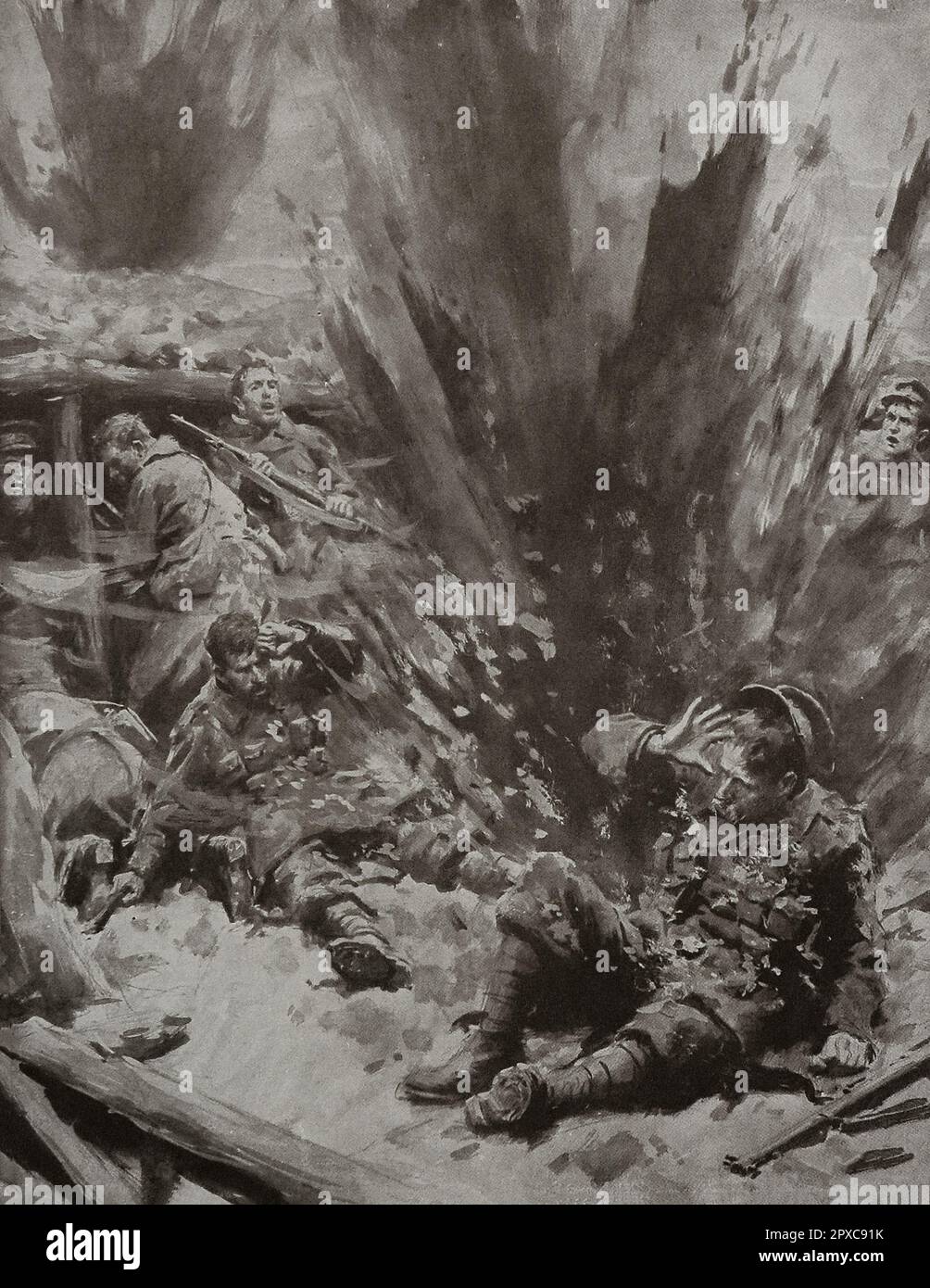 Wolrd War I. Battle of Flanders. Drawing by A.C. Michael, based on a sketch by Frederic Villiers The shell exploded in the mud without injuring anyone. Stock Photohttps://www.alamy.com/image-license-details/?v=1https://www.alamy.com/wolrd-war-i-battle-of-flanders-drawing-by-ac-michael-based-on-a-sketch-by-frederic-villiers-the-shell-exploded-in-the-mud-without-injuring-anyone-image549772991.html
Wolrd War I. Battle of Flanders. Drawing by A.C. Michael, based on a sketch by Frederic Villiers The shell exploded in the mud without injuring anyone. Stock Photohttps://www.alamy.com/image-license-details/?v=1https://www.alamy.com/wolrd-war-i-battle-of-flanders-drawing-by-ac-michael-based-on-a-sketch-by-frederic-villiers-the-shell-exploded-in-the-mud-without-injuring-anyone-image549772991.htmlRM2PXC91K–Wolrd War I. Battle of Flanders. Drawing by A.C. Michael, based on a sketch by Frederic Villiers The shell exploded in the mud without injuring anyone.
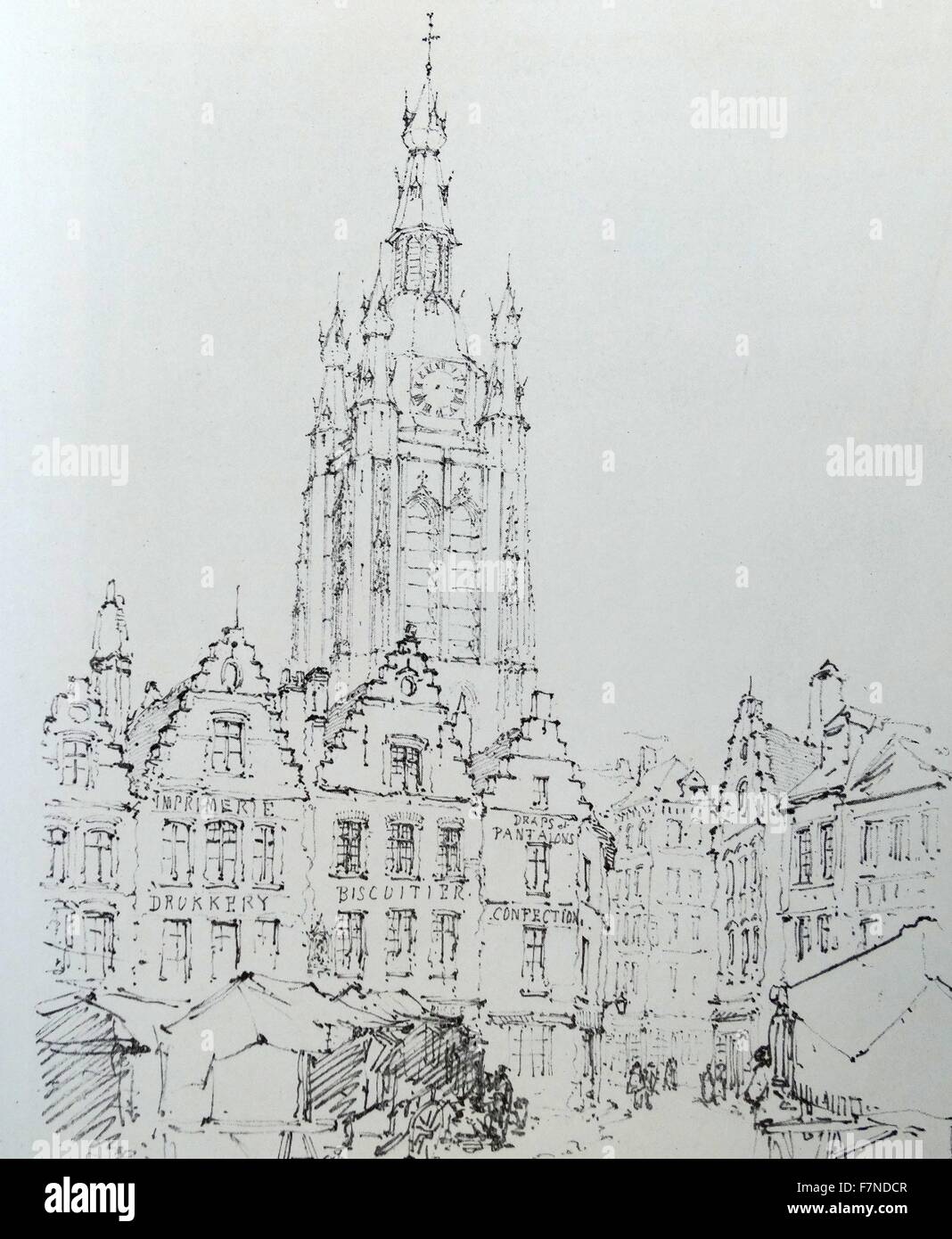 Pencil drawing of Courtrai, Belgium, showing the old buildings. Courtrai is a Flemish town, on the river Lys. Under its walls the 'Battle of the Spurs' was fought in which the Flanders defeated the French. Stock Photohttps://www.alamy.com/image-license-details/?v=1https://www.alamy.com/stock-photo-pencil-drawing-of-courtrai-belgium-showing-the-old-buildings-courtrai-90825975.html
Pencil drawing of Courtrai, Belgium, showing the old buildings. Courtrai is a Flemish town, on the river Lys. Under its walls the 'Battle of the Spurs' was fought in which the Flanders defeated the French. Stock Photohttps://www.alamy.com/image-license-details/?v=1https://www.alamy.com/stock-photo-pencil-drawing-of-courtrai-belgium-showing-the-old-buildings-courtrai-90825975.htmlRMF7NDCR–Pencil drawing of Courtrai, Belgium, showing the old buildings. Courtrai is a Flemish town, on the river Lys. Under its walls the 'Battle of the Spurs' was fought in which the Flanders defeated the French.
 The defeat at the naval Battle of Gravelines in the English Channel off Flanders (Belgium) in September 1588, of the Spanish Armada by Queen Elizabeth I's Royal Navy. Stock Photohttps://www.alamy.com/image-license-details/?v=1https://www.alamy.com/stock-photo-the-defeat-at-the-naval-battle-of-gravelines-in-the-english-channel-87359275.html
The defeat at the naval Battle of Gravelines in the English Channel off Flanders (Belgium) in September 1588, of the Spanish Armada by Queen Elizabeth I's Royal Navy. Stock Photohttps://www.alamy.com/image-license-details/?v=1https://www.alamy.com/stock-photo-the-defeat-at-the-naval-battle-of-gravelines-in-the-english-channel-87359275.htmlRMF23FJ3–The defeat at the naval Battle of Gravelines in the English Channel off Flanders (Belgium) in September 1588, of the Spanish Armada by Queen Elizabeth I's Royal Navy.
 Battle of Wervik and the wounding of the prince, 1793, Battle between Coalition troops and the French revolutionary army at Wervik in West Flanders on September 13, 1793 in which Willem George Frederik, Prince of Orange-Nassau, was wounded. With title in handwritten inscription., print, print maker: Cornelis Bogerts, after drawing by: Jacobus Buys, Northern Netherlands, 1793 - 1795, paper, etching, engraving, height, 164 mm × width, 115 mm Stock Photohttps://www.alamy.com/image-license-details/?v=1https://www.alamy.com/battle-of-wervik-and-the-wounding-of-the-prince-1793-battle-between-coalition-troops-and-the-french-revolutionary-army-at-wervik-in-west-flanders-on-september-13-1793-in-which-willem-george-frederik-prince-of-orange-nassau-was-wounded-with-title-in-handwritten-inscription-print-print-maker-cornelis-bogerts-after-drawing-by-jacobus-buys-northern-netherlands-1793-1795-paper-etching-engraving-height-164-mm-width-115-mm-image606634971.html
Battle of Wervik and the wounding of the prince, 1793, Battle between Coalition troops and the French revolutionary army at Wervik in West Flanders on September 13, 1793 in which Willem George Frederik, Prince of Orange-Nassau, was wounded. With title in handwritten inscription., print, print maker: Cornelis Bogerts, after drawing by: Jacobus Buys, Northern Netherlands, 1793 - 1795, paper, etching, engraving, height, 164 mm × width, 115 mm Stock Photohttps://www.alamy.com/image-license-details/?v=1https://www.alamy.com/battle-of-wervik-and-the-wounding-of-the-prince-1793-battle-between-coalition-troops-and-the-french-revolutionary-army-at-wervik-in-west-flanders-on-september-13-1793-in-which-willem-george-frederik-prince-of-orange-nassau-was-wounded-with-title-in-handwritten-inscription-print-print-maker-cornelis-bogerts-after-drawing-by-jacobus-buys-northern-netherlands-1793-1795-paper-etching-engraving-height-164-mm-width-115-mm-image606634971.htmlRM2X6XH2K–Battle of Wervik and the wounding of the prince, 1793, Battle between Coalition troops and the French revolutionary army at Wervik in West Flanders on September 13, 1793 in which Willem George Frederik, Prince of Orange-Nassau, was wounded. With title in handwritten inscription., print, print maker: Cornelis Bogerts, after drawing by: Jacobus Buys, Northern Netherlands, 1793 - 1795, paper, etching, engraving, height, 164 mm × width, 115 mm
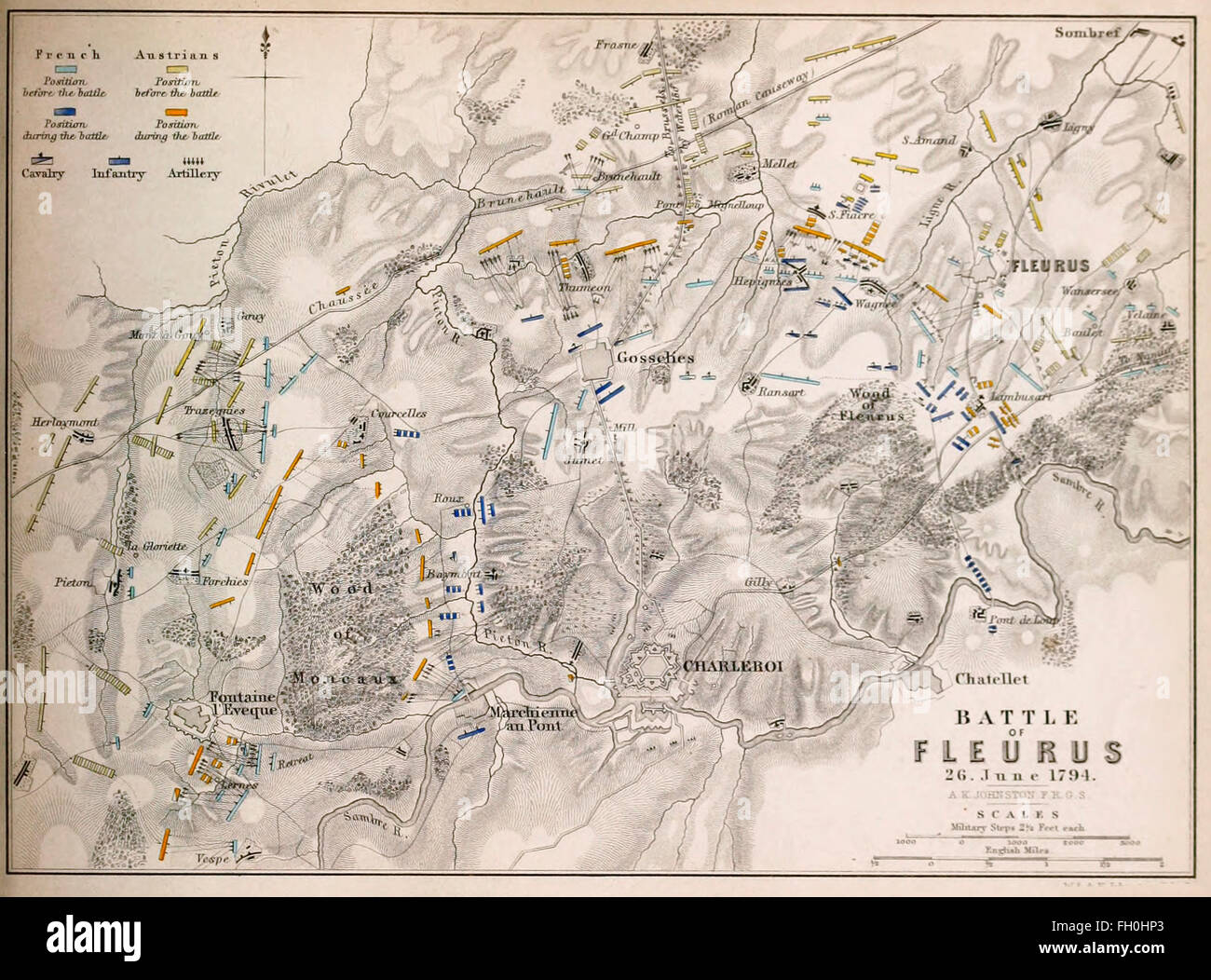 The Battle of Fleurus, on 26 June 1794, was a major engagement between the army of the First French Republic, under General Jean-Baptiste Jourdan, and the Coalition Army (Great Britain, Hanover, Dutch Republic, and Habsburg Monarchy), commanded by Prince Josias of Coburg, in the most decisive battle of the Flanders Campaign in the Low Countries during the French Revolutionary Wars. Stock Photohttps://www.alamy.com/image-license-details/?v=1https://www.alamy.com/stock-photo-the-battle-of-fleurus-on-26-june-1794-was-a-major-engagement-between-96514939.html
The Battle of Fleurus, on 26 June 1794, was a major engagement between the army of the First French Republic, under General Jean-Baptiste Jourdan, and the Coalition Army (Great Britain, Hanover, Dutch Republic, and Habsburg Monarchy), commanded by Prince Josias of Coburg, in the most decisive battle of the Flanders Campaign in the Low Countries during the French Revolutionary Wars. Stock Photohttps://www.alamy.com/image-license-details/?v=1https://www.alamy.com/stock-photo-the-battle-of-fleurus-on-26-june-1794-was-a-major-engagement-between-96514939.htmlRMFH0HP3–The Battle of Fleurus, on 26 June 1794, was a major engagement between the army of the First French Republic, under General Jean-Baptiste Jourdan, and the Coalition Army (Great Britain, Hanover, Dutch Republic, and Habsburg Monarchy), commanded by Prince Josias of Coburg, in the most decisive battle of the Flanders Campaign in the Low Countries during the French Revolutionary Wars.
 Sketches and Drawings of WW I - A Battle in Flanders. As Pictured by the Daily Papers Stock Photohttps://www.alamy.com/image-license-details/?v=1https://www.alamy.com/sketches-and-drawings-of-ww-i-a-battle-in-flanders-as-pictured-by-the-daily-papers-image227005734.html
Sketches and Drawings of WW I - A Battle in Flanders. As Pictured by the Daily Papers Stock Photohttps://www.alamy.com/image-license-details/?v=1https://www.alamy.com/sketches-and-drawings-of-ww-i-a-battle-in-flanders-as-pictured-by-the-daily-papers-image227005734.htmlRMR5903J–Sketches and Drawings of WW I - A Battle in Flanders. As Pictured by the Daily Papers
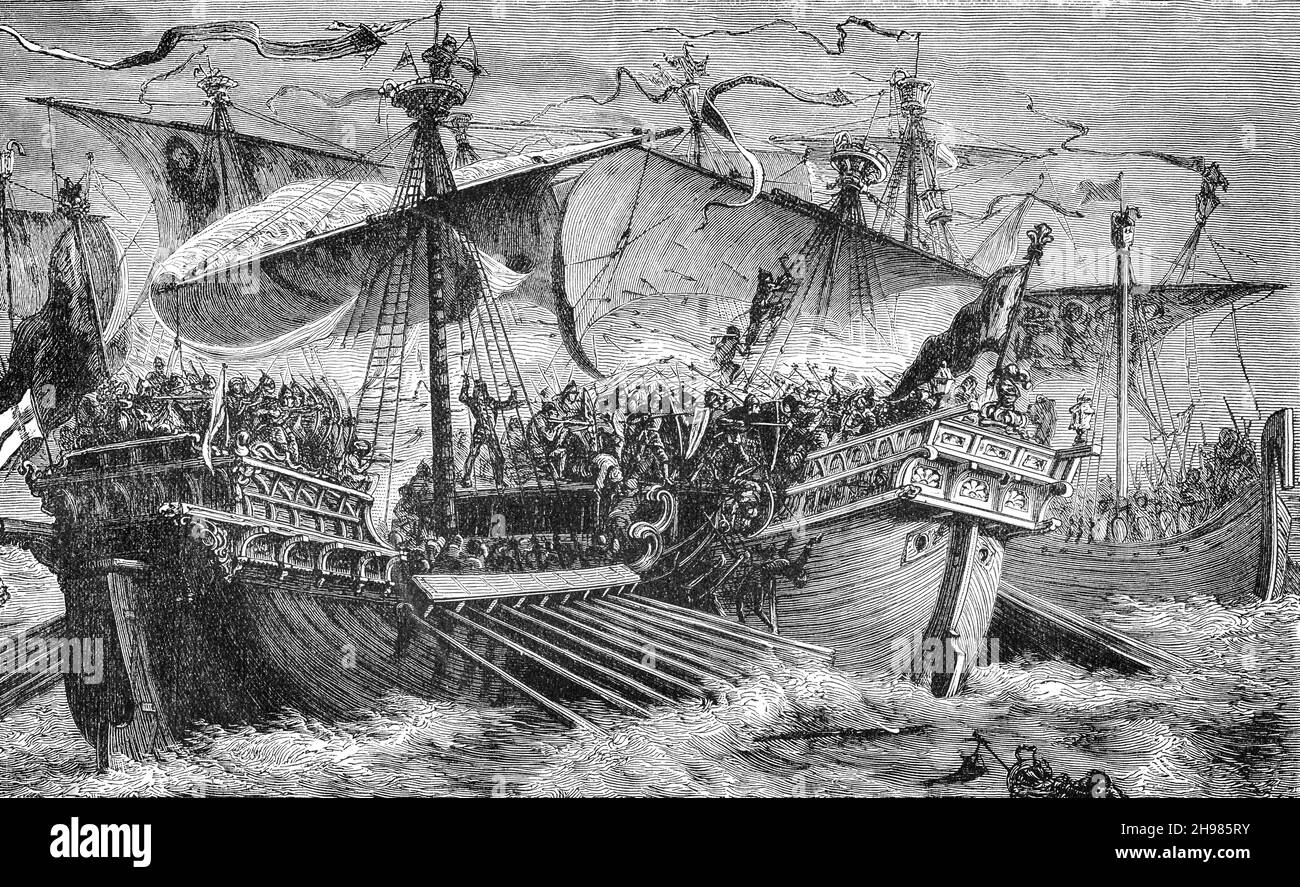 A late 19th Century illustration of the Battle of Sluys aka the Battle of l'Écluse, a naval battle fought on 24 June 1340 between England and France. It took place in the roadstead of the port of Sluys between Zeeland and West Flanders. The English fleet of 120–150 ships was led by Edward III of England defeated the 230-strong French fleet by the Breton knight Hugues Quiéret, Admiral of France, and Nicolas Béhuchet, Constable of France. The battle was one of the opening engagements of the Hundred Years' War. Stock Photohttps://www.alamy.com/image-license-details/?v=1https://www.alamy.com/a-late-19th-century-illustration-of-the-battle-of-sluys-aka-the-battle-of-lcluse-a-naval-battle-fought-on-24-june-1340-between-england-and-france-it-took-place-in-the-roadstead-of-the-port-of-sluys-between-zeeland-and-west-flanders-the-english-fleet-of-120150-ships-was-led-by-edward-iii-of-england-defeated-the-230-strong-french-fleet-by-the-breton-knight-hugues-quiret-admiral-of-france-and-nicolas-bhuchet-constable-of-france-the-battle-was-one-of-the-opening-engagements-of-the-hundred-years-war-image453181679.html
A late 19th Century illustration of the Battle of Sluys aka the Battle of l'Écluse, a naval battle fought on 24 June 1340 between England and France. It took place in the roadstead of the port of Sluys between Zeeland and West Flanders. The English fleet of 120–150 ships was led by Edward III of England defeated the 230-strong French fleet by the Breton knight Hugues Quiéret, Admiral of France, and Nicolas Béhuchet, Constable of France. The battle was one of the opening engagements of the Hundred Years' War. Stock Photohttps://www.alamy.com/image-license-details/?v=1https://www.alamy.com/a-late-19th-century-illustration-of-the-battle-of-sluys-aka-the-battle-of-lcluse-a-naval-battle-fought-on-24-june-1340-between-england-and-france-it-took-place-in-the-roadstead-of-the-port-of-sluys-between-zeeland-and-west-flanders-the-english-fleet-of-120150-ships-was-led-by-edward-iii-of-england-defeated-the-230-strong-french-fleet-by-the-breton-knight-hugues-quiret-admiral-of-france-and-nicolas-bhuchet-constable-of-france-the-battle-was-one-of-the-opening-engagements-of-the-hundred-years-war-image453181679.htmlRM2H985RY–A late 19th Century illustration of the Battle of Sluys aka the Battle of l'Écluse, a naval battle fought on 24 June 1340 between England and France. It took place in the roadstead of the port of Sluys between Zeeland and West Flanders. The English fleet of 120–150 ships was led by Edward III of England defeated the 230-strong French fleet by the Breton knight Hugues Quiéret, Admiral of France, and Nicolas Béhuchet, Constable of France. The battle was one of the opening engagements of the Hundred Years' War.
 World War One charge of the Grenadiers and death of Major Henri d'Oultremont at Tervaete during Battle of Beerst-Blote in 1914, West Flanders, Belgium Stock Photohttps://www.alamy.com/image-license-details/?v=1https://www.alamy.com/world-war-one-charge-of-the-grenadiers-and-death-of-major-henri-doultremont-at-tervaete-during-battle-of-beerst-blote-in-1914-west-flanders-belgium-image605480756.html
World War One charge of the Grenadiers and death of Major Henri d'Oultremont at Tervaete during Battle of Beerst-Blote in 1914, West Flanders, Belgium Stock Photohttps://www.alamy.com/image-license-details/?v=1https://www.alamy.com/world-war-one-charge-of-the-grenadiers-and-death-of-major-henri-doultremont-at-tervaete-during-battle-of-beerst-blote-in-1914-west-flanders-belgium-image605480756.htmlRM2X520TM–World War One charge of the Grenadiers and death of Major Henri d'Oultremont at Tervaete during Battle of Beerst-Blote in 1914, West Flanders, Belgium
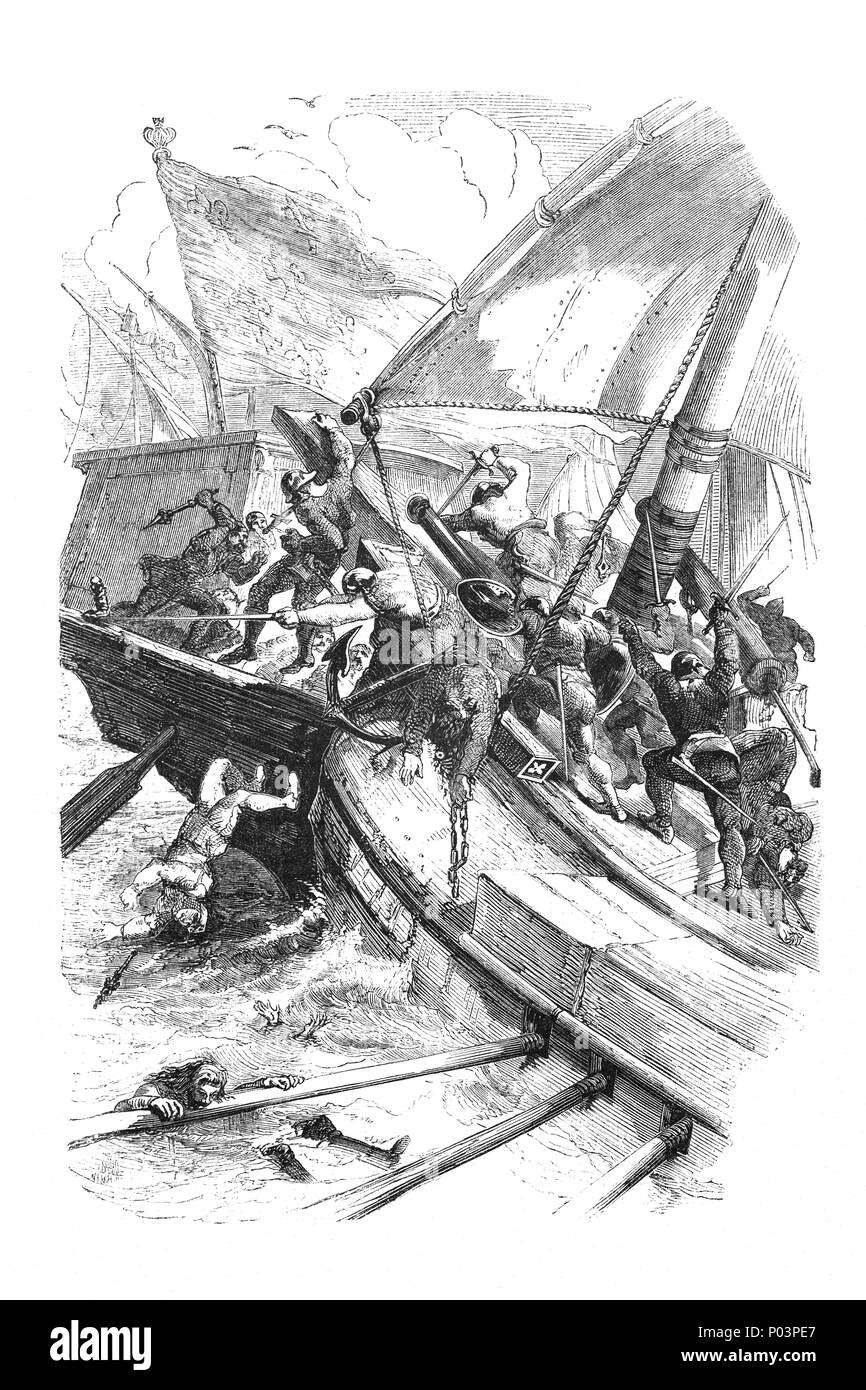 The Battle of Sluys, aka the Battle of l'Ecluse, was a sea battle fought on 24 June 1340 as one of the opening conflicts of the Hundred Years' War between England and France. The encounter happened during the reigns of Philip VI of France and Edward III of England, in front of the town of Newmarket or Sluis, on the inlet between West Flanders and Zeeland. During the battle Philip's navy was almost completely destroyed, giving the English fleet complete mastery over the channel. Stock Photohttps://www.alamy.com/image-license-details/?v=1https://www.alamy.com/the-battle-of-sluys-aka-the-battle-of-lecluse-was-a-sea-battle-fought-on-24-june-1340-as-one-of-the-opening-conflicts-of-the-hundred-years-war-between-england-and-france-the-encounter-happened-during-the-reigns-of-philip-vi-of-france-and-edward-iii-of-england-in-front-of-the-town-of-newmarket-or-sluis-on-the-inlet-between-west-flanders-and-zeeland-during-the-battle-philips-navy-was-almost-completely-destroyed-giving-the-english-fleet-complete-mastery-over-the-channel-image206607919.html
The Battle of Sluys, aka the Battle of l'Ecluse, was a sea battle fought on 24 June 1340 as one of the opening conflicts of the Hundred Years' War between England and France. The encounter happened during the reigns of Philip VI of France and Edward III of England, in front of the town of Newmarket or Sluis, on the inlet between West Flanders and Zeeland. During the battle Philip's navy was almost completely destroyed, giving the English fleet complete mastery over the channel. Stock Photohttps://www.alamy.com/image-license-details/?v=1https://www.alamy.com/the-battle-of-sluys-aka-the-battle-of-lecluse-was-a-sea-battle-fought-on-24-june-1340-as-one-of-the-opening-conflicts-of-the-hundred-years-war-between-england-and-france-the-encounter-happened-during-the-reigns-of-philip-vi-of-france-and-edward-iii-of-england-in-front-of-the-town-of-newmarket-or-sluis-on-the-inlet-between-west-flanders-and-zeeland-during-the-battle-philips-navy-was-almost-completely-destroyed-giving-the-english-fleet-complete-mastery-over-the-channel-image206607919.htmlRMP03PE7–The Battle of Sluys, aka the Battle of l'Ecluse, was a sea battle fought on 24 June 1340 as one of the opening conflicts of the Hundred Years' War between England and France. The encounter happened during the reigns of Philip VI of France and Edward III of England, in front of the town of Newmarket or Sluis, on the inlet between West Flanders and Zeeland. During the battle Philip's navy was almost completely destroyed, giving the English fleet complete mastery over the channel.
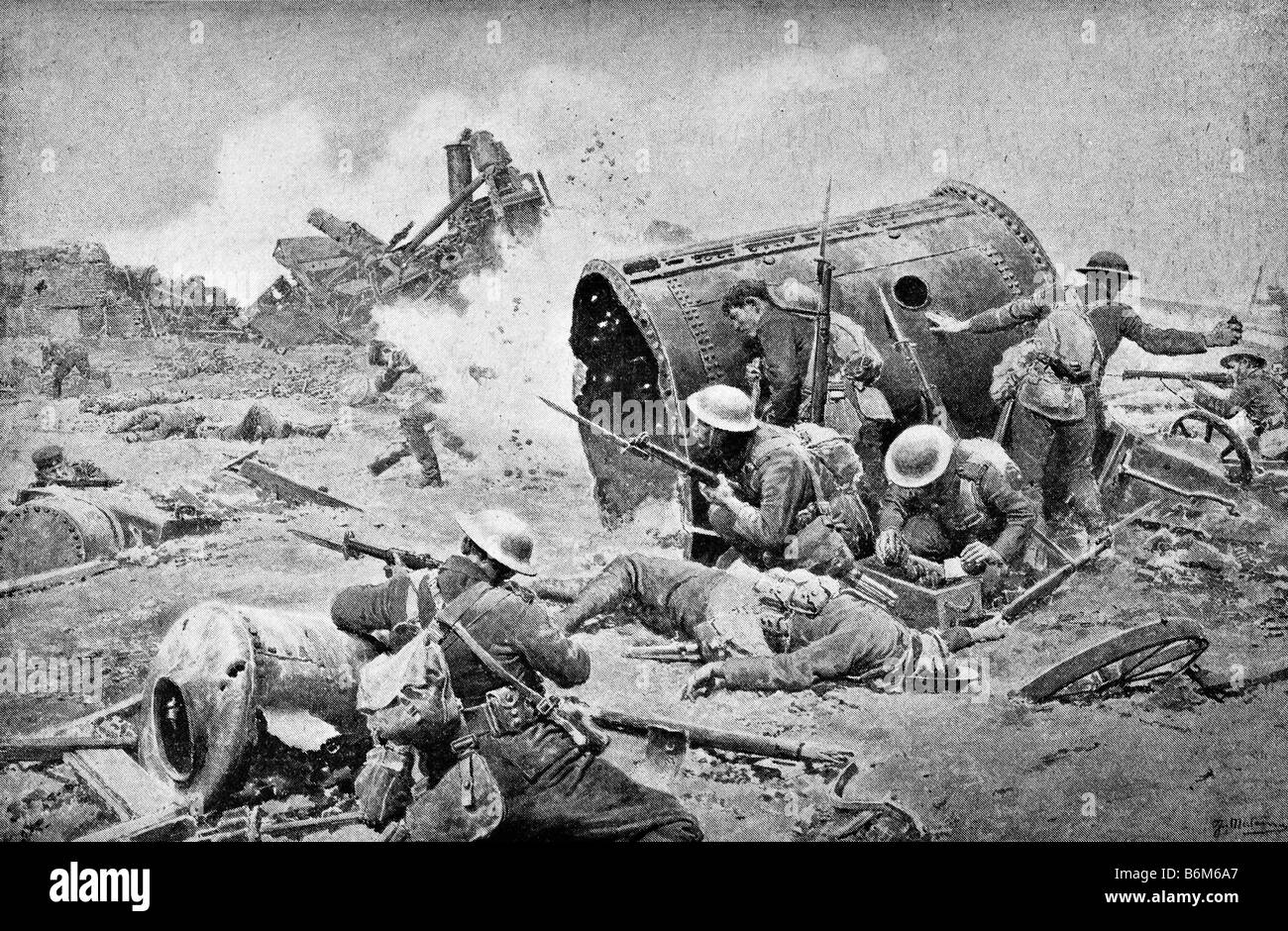 Contemporary World War One illustration of Canadian troops in action in France during the Battle of the Somme. Stock Photohttps://www.alamy.com/image-license-details/?v=1https://www.alamy.com/stock-photo-contemporary-world-war-one-illustration-of-canadian-troops-in-action-21342335.html
Contemporary World War One illustration of Canadian troops in action in France during the Battle of the Somme. Stock Photohttps://www.alamy.com/image-license-details/?v=1https://www.alamy.com/stock-photo-contemporary-world-war-one-illustration-of-canadian-troops-in-action-21342335.htmlRMB6M6A7–Contemporary World War One illustration of Canadian troops in action in France during the Battle of the Somme.
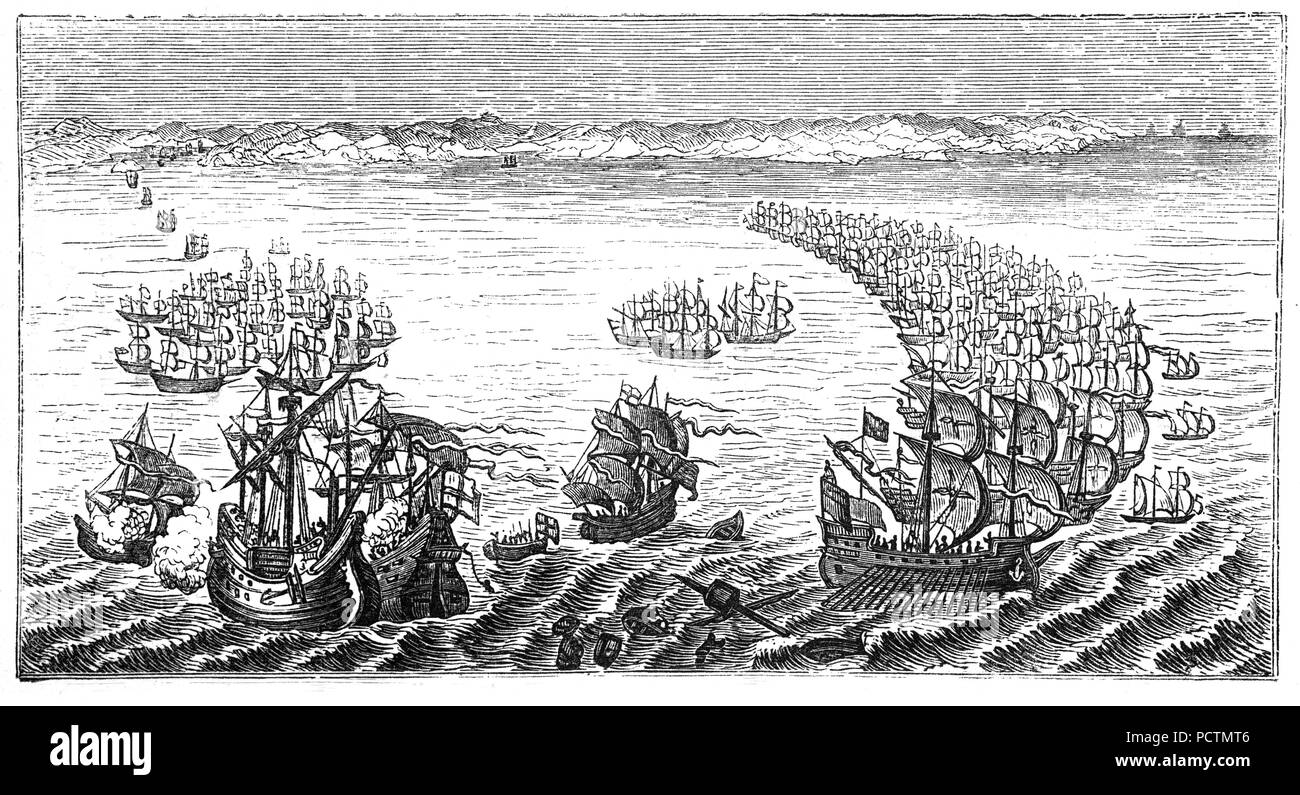 The Spanish Armada under attack from the English fleet during the largest engagement of the undeclared Anglo-Spanish War (1585–1604). The Spanish fleet of 130 ships sailed f in late May 1588, with the aim of escorting an army from Flanders to invade England and overthrow Queen Elizabeth I and her establishment of Protestantism in England. The Armada anchored off Calais, but was scattered by an English fireship attack. Following the ensuing Battle of Gravelines the Spanish fleet was forced to return to Spain. Stock Photohttps://www.alamy.com/image-license-details/?v=1https://www.alamy.com/the-spanish-armada-under-attack-from-the-english-fleet-during-the-largest-engagement-of-the-undeclared-anglo-spanish-war-15851604-the-spanish-fleet-of-130-ships-sailed-f-in-late-may-1588-with-the-aim-of-escorting-an-army-from-flanders-to-invade-england-and-overthrow-queen-elizabeth-i-and-her-establishment-of-protestantism-in-england-the-armada-anchored-off-calais-but-was-scattered-by-an-english-fireship-attack-following-the-ensuing-battle-of-gravelines-the-spanish-fleet-was-forced-to-return-to-spain-image214443494.html
The Spanish Armada under attack from the English fleet during the largest engagement of the undeclared Anglo-Spanish War (1585–1604). The Spanish fleet of 130 ships sailed f in late May 1588, with the aim of escorting an army from Flanders to invade England and overthrow Queen Elizabeth I and her establishment of Protestantism in England. The Armada anchored off Calais, but was scattered by an English fireship attack. Following the ensuing Battle of Gravelines the Spanish fleet was forced to return to Spain. Stock Photohttps://www.alamy.com/image-license-details/?v=1https://www.alamy.com/the-spanish-armada-under-attack-from-the-english-fleet-during-the-largest-engagement-of-the-undeclared-anglo-spanish-war-15851604-the-spanish-fleet-of-130-ships-sailed-f-in-late-may-1588-with-the-aim-of-escorting-an-army-from-flanders-to-invade-england-and-overthrow-queen-elizabeth-i-and-her-establishment-of-protestantism-in-england-the-armada-anchored-off-calais-but-was-scattered-by-an-english-fireship-attack-following-the-ensuing-battle-of-gravelines-the-spanish-fleet-was-forced-to-return-to-spain-image214443494.htmlRMPCTMT6–The Spanish Armada under attack from the English fleet during the largest engagement of the undeclared Anglo-Spanish War (1585–1604). The Spanish fleet of 130 ships sailed f in late May 1588, with the aim of escorting an army from Flanders to invade England and overthrow Queen Elizabeth I and her establishment of Protestantism in England. The Armada anchored off Calais, but was scattered by an English fireship attack. Following the ensuing Battle of Gravelines the Spanish fleet was forced to return to Spain.
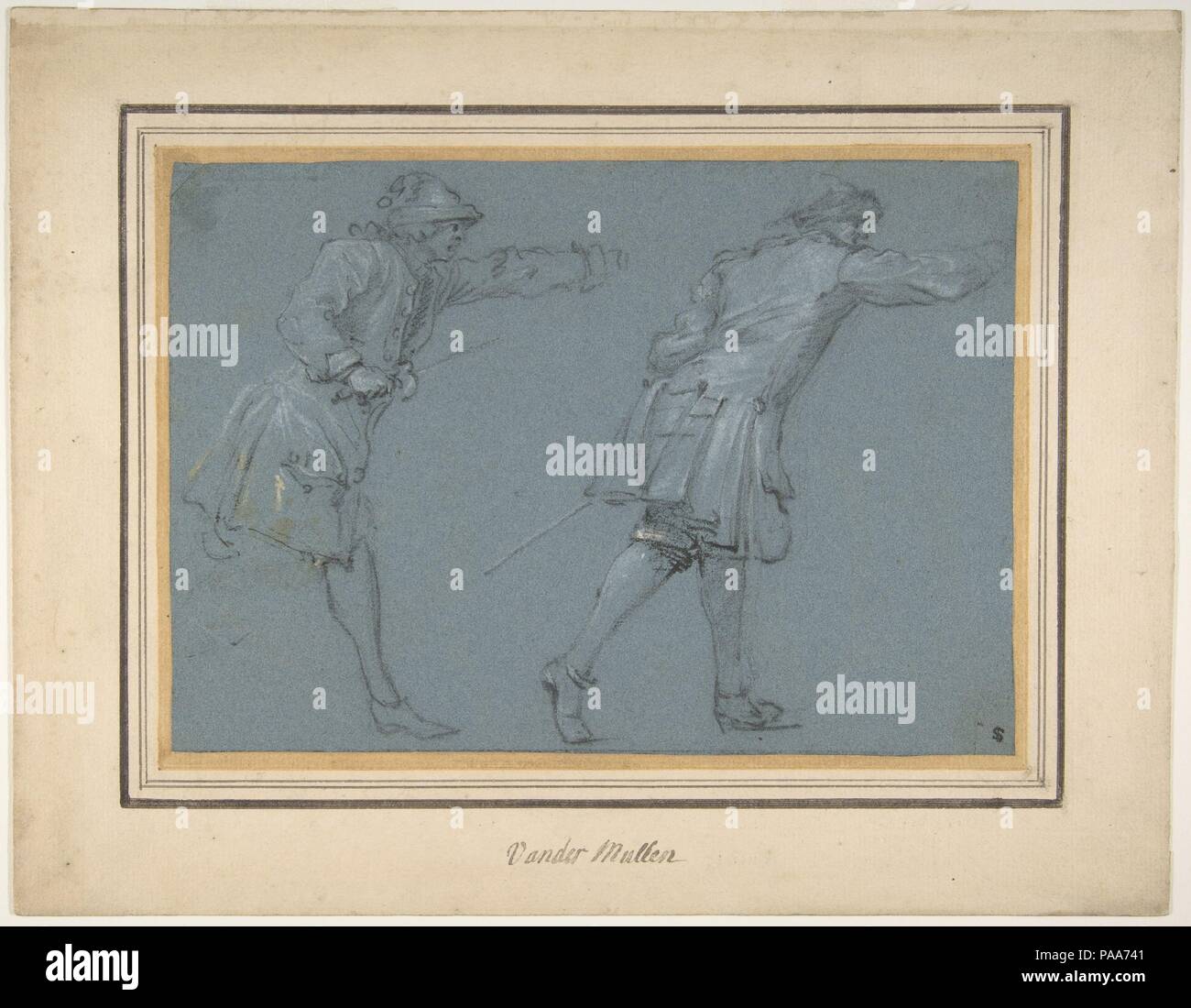 Study of Two Soldiers Swordfighting. Artist: Adam Frans van der Meulen (Flemish, Brussels 1632-1690 Paris). Dimensions: sheet: 6 9/16 x 9 7/16 in. (16.7 x 23.9 cm). Date: 17th century. Van der Meulen was active mostly in France, where he served as a court painter to King Louis XIV and specialized in historical and military scenes. This drawing of two soldiers in a sword fight reflects the artist's fascination with battle themes; instead of confronting one another, however, the two men seem to be battling an external opponent located beyond the frame. The format and cropping enhance the sense Stock Photohttps://www.alamy.com/image-license-details/?v=1https://www.alamy.com/study-of-two-soldiers-swordfighting-artist-adam-frans-van-der-meulen-flemish-brussels-1632-1690-paris-dimensions-sheet-6-916-x-9-716-in-167-x-239-cm-date-17th-century-van-der-meulen-was-active-mostly-in-france-where-he-served-as-a-court-painter-to-king-louis-xiv-and-specialized-in-historical-and-military-scenes-this-drawing-of-two-soldiers-in-a-sword-fight-reflects-the-artists-fascination-with-battle-themes-instead-of-confronting-one-another-however-the-two-men-seem-to-be-battling-an-external-opponent-located-beyond-the-frame-the-format-and-cropping-enhance-the-sense-image212896097.html
Study of Two Soldiers Swordfighting. Artist: Adam Frans van der Meulen (Flemish, Brussels 1632-1690 Paris). Dimensions: sheet: 6 9/16 x 9 7/16 in. (16.7 x 23.9 cm). Date: 17th century. Van der Meulen was active mostly in France, where he served as a court painter to King Louis XIV and specialized in historical and military scenes. This drawing of two soldiers in a sword fight reflects the artist's fascination with battle themes; instead of confronting one another, however, the two men seem to be battling an external opponent located beyond the frame. The format and cropping enhance the sense Stock Photohttps://www.alamy.com/image-license-details/?v=1https://www.alamy.com/study-of-two-soldiers-swordfighting-artist-adam-frans-van-der-meulen-flemish-brussels-1632-1690-paris-dimensions-sheet-6-916-x-9-716-in-167-x-239-cm-date-17th-century-van-der-meulen-was-active-mostly-in-france-where-he-served-as-a-court-painter-to-king-louis-xiv-and-specialized-in-historical-and-military-scenes-this-drawing-of-two-soldiers-in-a-sword-fight-reflects-the-artists-fascination-with-battle-themes-instead-of-confronting-one-another-however-the-two-men-seem-to-be-battling-an-external-opponent-located-beyond-the-frame-the-format-and-cropping-enhance-the-sense-image212896097.htmlRMPAA741–Study of Two Soldiers Swordfighting. Artist: Adam Frans van der Meulen (Flemish, Brussels 1632-1690 Paris). Dimensions: sheet: 6 9/16 x 9 7/16 in. (16.7 x 23.9 cm). Date: 17th century. Van der Meulen was active mostly in France, where he served as a court painter to King Louis XIV and specialized in historical and military scenes. This drawing of two soldiers in a sword fight reflects the artist's fascination with battle themes; instead of confronting one another, however, the two men seem to be battling an external opponent located beyond the frame. The format and cropping enhance the sense
 The Siege of Breda of 1624-25 occurred during the Eighty Years' War. Following the orders of Ambrogio Spinola, Philip IV's army laid siege to Breda in August 1624. The strategically located city was heavily fortified and strongly defended by a garrison of 7,000 men, that the Dutch were confident would hold out long enough to wear down besiegers. Spinola launched his Breda campaign, rapidly blocking the city's defenses and driving off a Dutch relief army that had attempted to cut off the Spanish army's access to supplies. In February 1625, a second relief force, consisting of 7,000 English troo Stock Photohttps://www.alamy.com/image-license-details/?v=1https://www.alamy.com/the-siege-of-breda-of-1624-25-occurred-during-the-eighty-years-war-image151887008.html
The Siege of Breda of 1624-25 occurred during the Eighty Years' War. Following the orders of Ambrogio Spinola, Philip IV's army laid siege to Breda in August 1624. The strategically located city was heavily fortified and strongly defended by a garrison of 7,000 men, that the Dutch were confident would hold out long enough to wear down besiegers. Spinola launched his Breda campaign, rapidly blocking the city's defenses and driving off a Dutch relief army that had attempted to cut off the Spanish army's access to supplies. In February 1625, a second relief force, consisting of 7,000 English troo Stock Photohttps://www.alamy.com/image-license-details/?v=1https://www.alamy.com/the-siege-of-breda-of-1624-25-occurred-during-the-eighty-years-war-image151887008.htmlRMJR31C0–The Siege of Breda of 1624-25 occurred during the Eighty Years' War. Following the orders of Ambrogio Spinola, Philip IV's army laid siege to Breda in August 1624. The strategically located city was heavily fortified and strongly defended by a garrison of 7,000 men, that the Dutch were confident would hold out long enough to wear down besiegers. Spinola launched his Breda campaign, rapidly blocking the city's defenses and driving off a Dutch relief army that had attempted to cut off the Spanish army's access to supplies. In February 1625, a second relief force, consisting of 7,000 English troo
 Algerian Turcos overcome German soldiers in house to house WW1 combat in Flanders. Contemporary drawing shows to ferocity of Stock Photohttps://www.alamy.com/image-license-details/?v=1https://www.alamy.com/stock-photo-algerian-turcos-overcome-german-soldiers-in-house-to-house-ww1-combat-59778004.html
Algerian Turcos overcome German soldiers in house to house WW1 combat in Flanders. Contemporary drawing shows to ferocity of Stock Photohttps://www.alamy.com/image-license-details/?v=1https://www.alamy.com/stock-photo-algerian-turcos-overcome-german-soldiers-in-house-to-house-ww1-combat-59778004.htmlRMDD73CM–Algerian Turcos overcome German soldiers in house to house WW1 combat in Flanders. Contemporary drawing shows to ferocity of
![Great Naval Engagement off Sluys [Sluis] [Battle of Sluys also called the Battle of l'Écluse, was a naval battle fought on 24 June 1340 between England and France. It took place in the roadstead of the port of Sluys (French Écluse), on a since silted-up inlet between Zeeland and West Flanders. The English fleet of 120–150 ships was led by Edward III of England and the 230-strong French fleet by the Breton knight Hugues Quiéret, Admiral of France, and Nicolas Béhuchet, Constable of France. The battle was one of the opening engagements of the Hundred Years' War]. from the book History of England Stock Photo Great Naval Engagement off Sluys [Sluis] [Battle of Sluys also called the Battle of l'Écluse, was a naval battle fought on 24 June 1340 between England and France. It took place in the roadstead of the port of Sluys (French Écluse), on a since silted-up inlet between Zeeland and West Flanders. The English fleet of 120–150 ships was led by Edward III of England and the 230-strong French fleet by the Breton knight Hugues Quiéret, Admiral of France, and Nicolas Béhuchet, Constable of France. The battle was one of the opening engagements of the Hundred Years' War]. from the book History of England Stock Photo](https://c8.alamy.com/comp/2FN51DJ/great-naval-engagement-off-sluys-sluis-battle-of-sluys-also-called-the-battle-of-lcluse-was-a-naval-battle-fought-on-24-june-1340-between-england-and-france-it-took-place-in-the-roadstead-of-the-port-of-sluys-french-cluse-on-a-since-silted-up-inlet-between-zeeland-and-west-flanders-the-english-fleet-of-120150-ships-was-led-by-edward-iii-of-england-and-the-230-strong-french-fleet-by-the-breton-knight-hugues-quiret-admiral-of-france-and-nicolas-bhuchet-constable-of-france-the-battle-was-one-of-the-opening-engagements-of-the-hundred-years-war-from-the-book-history-of-england-2FN51DJ.jpg) Great Naval Engagement off Sluys [Sluis] [Battle of Sluys also called the Battle of l'Écluse, was a naval battle fought on 24 June 1340 between England and France. It took place in the roadstead of the port of Sluys (French Écluse), on a since silted-up inlet between Zeeland and West Flanders. The English fleet of 120–150 ships was led by Edward III of England and the 230-strong French fleet by the Breton knight Hugues Quiéret, Admiral of France, and Nicolas Béhuchet, Constable of France. The battle was one of the opening engagements of the Hundred Years' War]. from the book History of England Stock Photohttps://www.alamy.com/image-license-details/?v=1https://www.alamy.com/great-naval-engagement-off-sluys-sluis-battle-of-sluys-also-called-the-battle-of-lcluse-was-a-naval-battle-fought-on-24-june-1340-between-england-and-france-it-took-place-in-the-roadstead-of-the-port-of-sluys-french-cluse-on-a-since-silted-up-inlet-between-zeeland-and-west-flanders-the-english-fleet-of-120150-ships-was-led-by-edward-iii-of-england-and-the-230-strong-french-fleet-by-the-breton-knight-hugues-quiret-admiral-of-france-and-nicolas-bhuchet-constable-of-france-the-battle-was-one-of-the-opening-engagements-of-the-hundred-years-war-from-the-book-history-of-england-image426067534.html
Great Naval Engagement off Sluys [Sluis] [Battle of Sluys also called the Battle of l'Écluse, was a naval battle fought on 24 June 1340 between England and France. It took place in the roadstead of the port of Sluys (French Écluse), on a since silted-up inlet between Zeeland and West Flanders. The English fleet of 120–150 ships was led by Edward III of England and the 230-strong French fleet by the Breton knight Hugues Quiéret, Admiral of France, and Nicolas Béhuchet, Constable of France. The battle was one of the opening engagements of the Hundred Years' War]. from the book History of England Stock Photohttps://www.alamy.com/image-license-details/?v=1https://www.alamy.com/great-naval-engagement-off-sluys-sluis-battle-of-sluys-also-called-the-battle-of-lcluse-was-a-naval-battle-fought-on-24-june-1340-between-england-and-france-it-took-place-in-the-roadstead-of-the-port-of-sluys-french-cluse-on-a-since-silted-up-inlet-between-zeeland-and-west-flanders-the-english-fleet-of-120150-ships-was-led-by-edward-iii-of-england-and-the-230-strong-french-fleet-by-the-breton-knight-hugues-quiret-admiral-of-france-and-nicolas-bhuchet-constable-of-france-the-battle-was-one-of-the-opening-engagements-of-the-hundred-years-war-from-the-book-history-of-england-image426067534.htmlRF2FN51DJ–Great Naval Engagement off Sluys [Sluis] [Battle of Sluys also called the Battle of l'Écluse, was a naval battle fought on 24 June 1340 between England and France. It took place in the roadstead of the port of Sluys (French Écluse), on a since silted-up inlet between Zeeland and West Flanders. The English fleet of 120–150 ships was led by Edward III of England and the 230-strong French fleet by the Breton knight Hugues Quiéret, Admiral of France, and Nicolas Béhuchet, Constable of France. The battle was one of the opening engagements of the Hundred Years' War]. from the book History of England
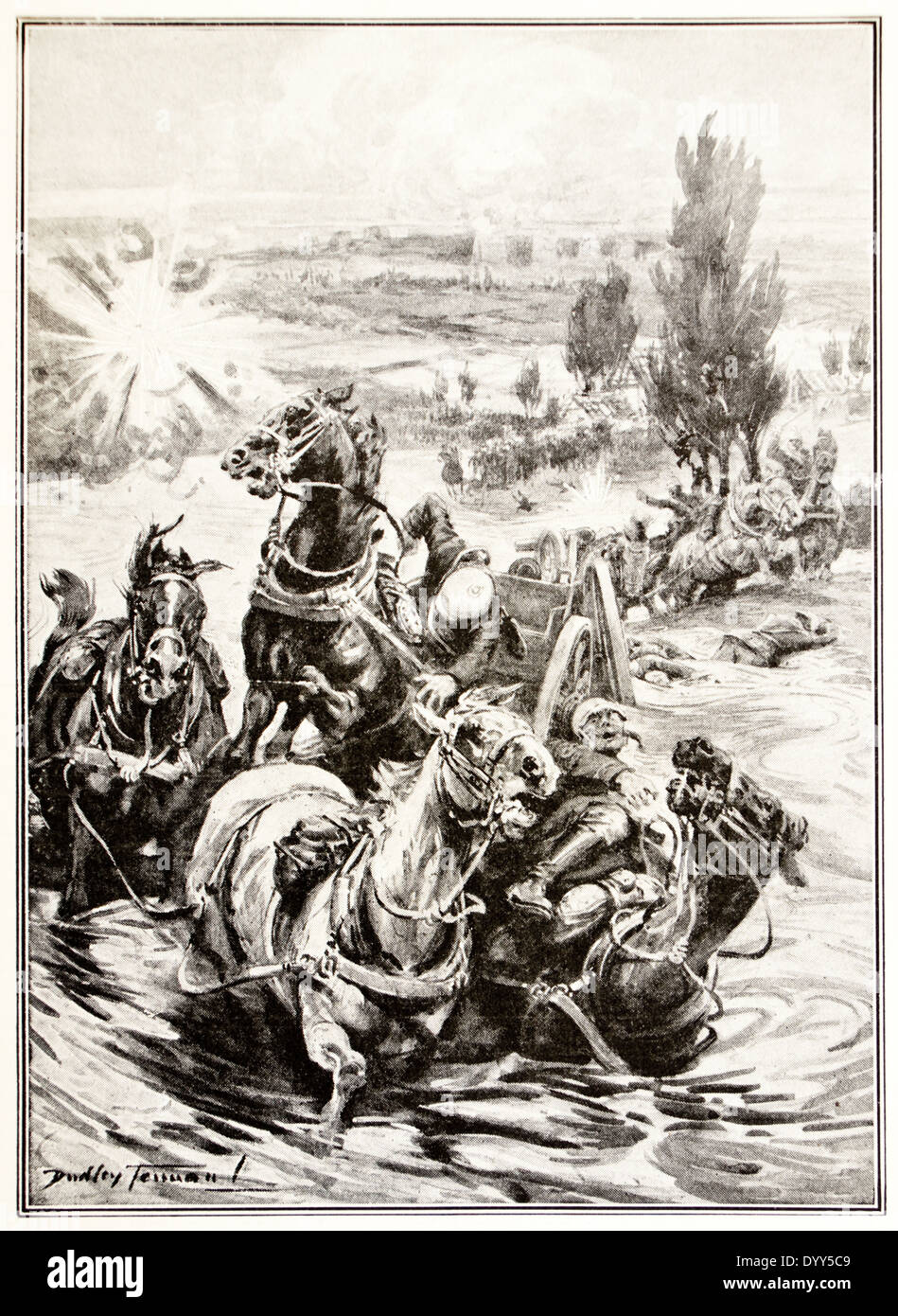 WW1 illustration from 1914 by Charles Dudley Tennant (1867-1952) entitled 'Opening the Flood-Gates in Flanders'. Stock Photohttps://www.alamy.com/image-license-details/?v=1https://www.alamy.com/ww1-illustration-from-1914-by-charles-dudley-tennant-1867-1952-entitled-image68823785.html
WW1 illustration from 1914 by Charles Dudley Tennant (1867-1952) entitled 'Opening the Flood-Gates in Flanders'. Stock Photohttps://www.alamy.com/image-license-details/?v=1https://www.alamy.com/ww1-illustration-from-1914-by-charles-dudley-tennant-1867-1952-entitled-image68823785.htmlRMDYY5C9–WW1 illustration from 1914 by Charles Dudley Tennant (1867-1952) entitled 'Opening the Flood-Gates in Flanders'.
 London buses used to transport troops to the front, First World War, 1914-1918, (c1920). 'Reinforcements for the Battle Front: the London Motor Bus on Active Service in Flanders. In describing the sketch from which the above drawing was made, Mr Frederic Villiers, the war artist, writes: "The strenuous fighting of the last week has necessitated the quick transportation of men from the base to fill up the gaps. A fleet of motor-omnibuses has assisted in this work; in fact, the London motor bus has had much to do with the stemming of the German onslaught"'. From "The Great World W Stock Photohttps://www.alamy.com/image-license-details/?v=1https://www.alamy.com/london-buses-used-to-transport-troops-to-the-front-first-world-war-1914-1918-c1920-reinforcements-for-the-battle-front-the-london-motor-bus-on-active-service-in-flanders-in-describing-the-sketch-from-which-the-above-drawing-was-made-mr-frederic-villiers-the-war-artist-writes-quotthe-strenuous-fighting-of-the-last-week-has-necessitated-the-quick-transportation-of-men-from-the-base-to-fill-up-the-gaps-a-fleet-of-motor-omnibuses-has-assisted-in-this-work-in-fact-the-london-motor-bus-has-had-much-to-do-with-the-stemming-of-the-german-onslaughtquot-from-quotthe-great-world-w-image262332835.html
London buses used to transport troops to the front, First World War, 1914-1918, (c1920). 'Reinforcements for the Battle Front: the London Motor Bus on Active Service in Flanders. In describing the sketch from which the above drawing was made, Mr Frederic Villiers, the war artist, writes: "The strenuous fighting of the last week has necessitated the quick transportation of men from the base to fill up the gaps. A fleet of motor-omnibuses has assisted in this work; in fact, the London motor bus has had much to do with the stemming of the German onslaught"'. From "The Great World W Stock Photohttps://www.alamy.com/image-license-details/?v=1https://www.alamy.com/london-buses-used-to-transport-troops-to-the-front-first-world-war-1914-1918-c1920-reinforcements-for-the-battle-front-the-london-motor-bus-on-active-service-in-flanders-in-describing-the-sketch-from-which-the-above-drawing-was-made-mr-frederic-villiers-the-war-artist-writes-quotthe-strenuous-fighting-of-the-last-week-has-necessitated-the-quick-transportation-of-men-from-the-base-to-fill-up-the-gaps-a-fleet-of-motor-omnibuses-has-assisted-in-this-work-in-fact-the-london-motor-bus-has-had-much-to-do-with-the-stemming-of-the-german-onslaughtquot-from-quotthe-great-world-w-image262332835.htmlRMW6P85R–London buses used to transport troops to the front, First World War, 1914-1918, (c1920). 'Reinforcements for the Battle Front: the London Motor Bus on Active Service in Flanders. In describing the sketch from which the above drawing was made, Mr Frederic Villiers, the war artist, writes: "The strenuous fighting of the last week has necessitated the quick transportation of men from the base to fill up the gaps. A fleet of motor-omnibuses has assisted in this work; in fact, the London motor bus has had much to do with the stemming of the German onslaught"'. From "The Great World W
 A Battle in Flanders. As Pictured by the Daily Papers - Sketch from anonymous british soldier ( knowed as ' JM') Stock Photohttps://www.alamy.com/image-license-details/?v=1https://www.alamy.com/stock-photo-a-battle-in-flanders-as-pictured-by-the-daily-papers-sketch-from-anonymous-136715792.html
A Battle in Flanders. As Pictured by the Daily Papers - Sketch from anonymous british soldier ( knowed as ' JM') Stock Photohttps://www.alamy.com/image-license-details/?v=1https://www.alamy.com/stock-photo-a-battle-in-flanders-as-pictured-by-the-daily-papers-sketch-from-anonymous-136715792.htmlRMHXBXAT–A Battle in Flanders. As Pictured by the Daily Papers - Sketch from anonymous british soldier ( knowed as ' JM')
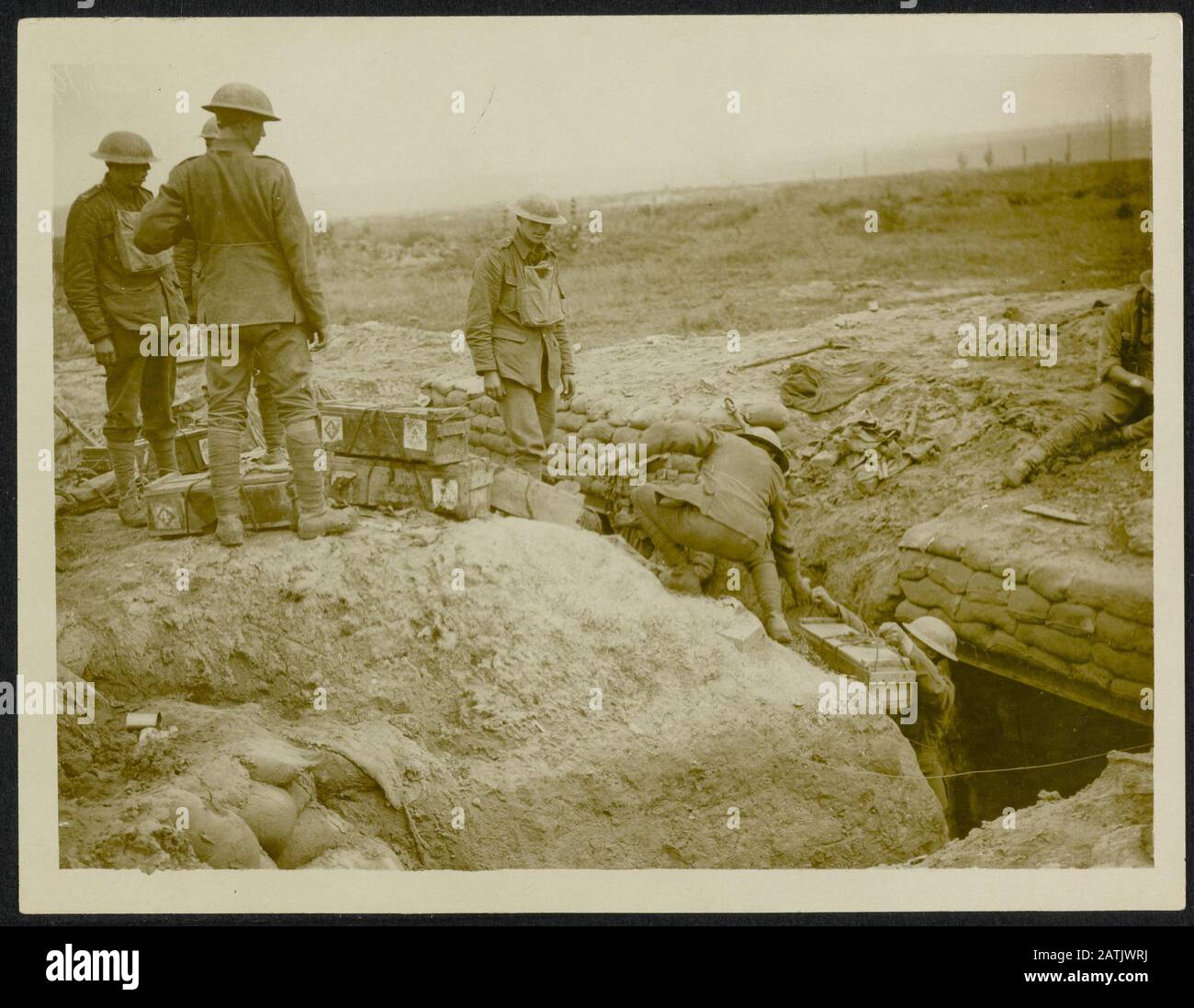 The British Western Front. Battle of Flanders Description: Bombing parties drawing bombs from a bomb store in support trenches Annotation: British Western Front. The battle of Flanders. Bombs are a warehouse to stock-trenches on beaten date: {1914-1918} Location: Belgium Keywords: bombs, World War fronts, trenches, soldiers, supplies Stock Photohttps://www.alamy.com/image-license-details/?v=1https://www.alamy.com/the-british-western-front-battle-of-flanders-description-bombing-parties-drawing-bombs-from-a-bomb-store-in-support-trenches-annotation-british-western-front-the-battle-of-flanders-bombs-are-a-warehouse-to-stock-trenches-on-beaten-date-1914-1918-location-belgium-keywords-bombs-world-war-fronts-trenches-soldiers-supplies-image342164134.html
The British Western Front. Battle of Flanders Description: Bombing parties drawing bombs from a bomb store in support trenches Annotation: British Western Front. The battle of Flanders. Bombs are a warehouse to stock-trenches on beaten date: {1914-1918} Location: Belgium Keywords: bombs, World War fronts, trenches, soldiers, supplies Stock Photohttps://www.alamy.com/image-license-details/?v=1https://www.alamy.com/the-british-western-front-battle-of-flanders-description-bombing-parties-drawing-bombs-from-a-bomb-store-in-support-trenches-annotation-british-western-front-the-battle-of-flanders-bombs-are-a-warehouse-to-stock-trenches-on-beaten-date-1914-1918-location-belgium-keywords-bombs-world-war-fronts-trenches-soldiers-supplies-image342164134.htmlRM2ATJWRJ–The British Western Front. Battle of Flanders Description: Bombing parties drawing bombs from a bomb store in support trenches Annotation: British Western Front. The battle of Flanders. Bombs are a warehouse to stock-trenches on beaten date: {1914-1918} Location: Belgium Keywords: bombs, World War fronts, trenches, soldiers, supplies
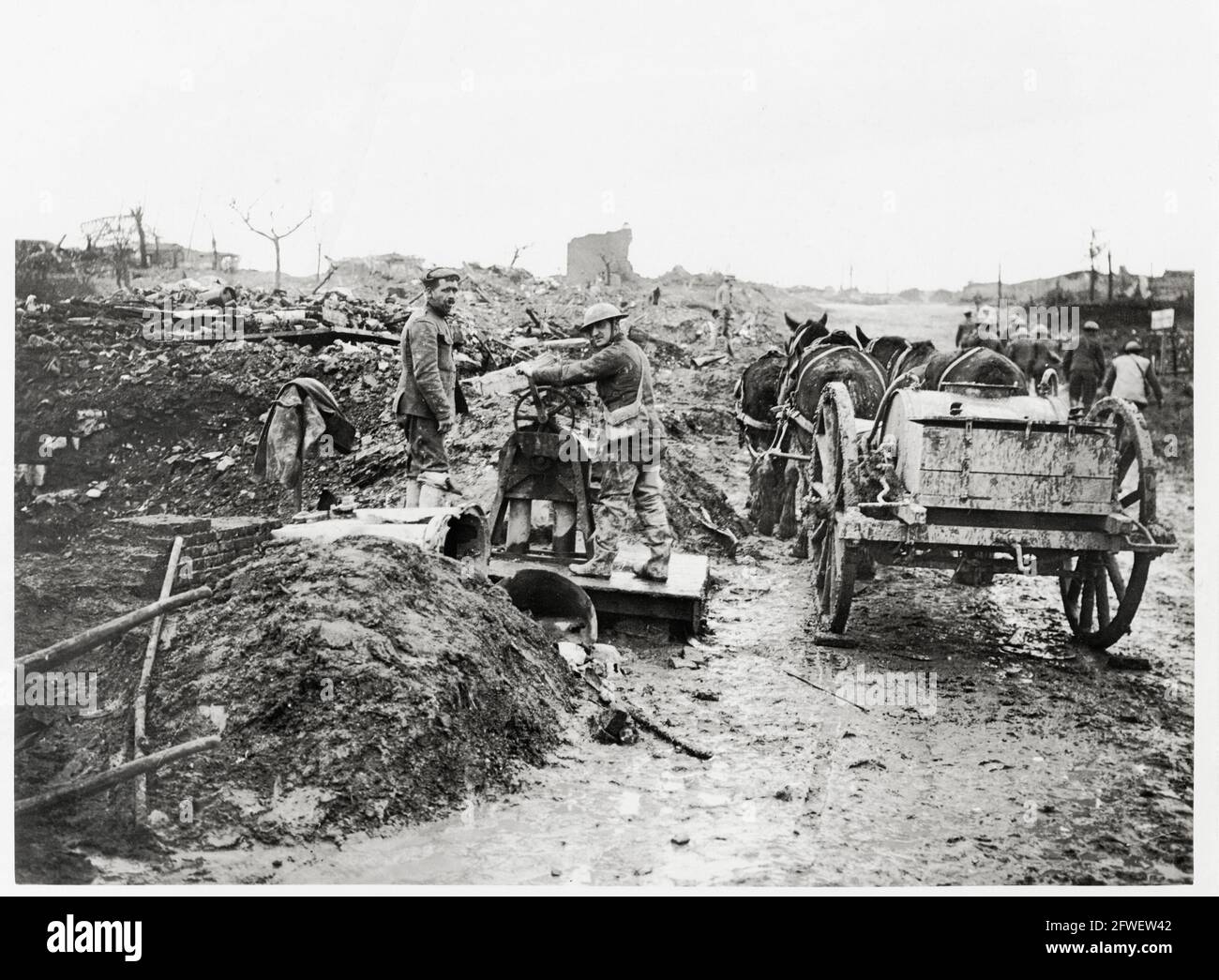 World War One, WWI, Western Front - Men drawing water in a captured and damaged village, France Stock Photohttps://www.alamy.com/image-license-details/?v=1https://www.alamy.com/world-war-one-wwi-western-front-men-drawing-water-in-a-captured-and-damaged-village-france-image428742274.html
World War One, WWI, Western Front - Men drawing water in a captured and damaged village, France Stock Photohttps://www.alamy.com/image-license-details/?v=1https://www.alamy.com/world-war-one-wwi-western-front-men-drawing-water-in-a-captured-and-damaged-village-france-image428742274.htmlRM2FWEW42–World War One, WWI, Western Front - Men drawing water in a captured and damaged village, France
 British troops on the left - centre of the battlefield , attacking and advancing on the German line in the midst of the fiercest fighting , during the new battle of Flanders . 1917 Stock Photohttps://www.alamy.com/image-license-details/?v=1https://www.alamy.com/british-troops-on-the-left-centre-of-the-battlefield-attacking-and-advancing-on-the-german-line-in-the-midst-of-the-fiercest-fighting-during-the-new-battle-of-flanders-1917-image623390895.html
British troops on the left - centre of the battlefield , attacking and advancing on the German line in the midst of the fiercest fighting , during the new battle of Flanders . 1917 Stock Photohttps://www.alamy.com/image-license-details/?v=1https://www.alamy.com/british-troops-on-the-left-centre-of-the-battlefield-attacking-and-advancing-on-the-german-line-in-the-midst-of-the-fiercest-fighting-during-the-new-battle-of-flanders-1917-image623390895.htmlRM2Y65WCF–British troops on the left - centre of the battlefield , attacking and advancing on the German line in the midst of the fiercest fighting , during the new battle of Flanders . 1917
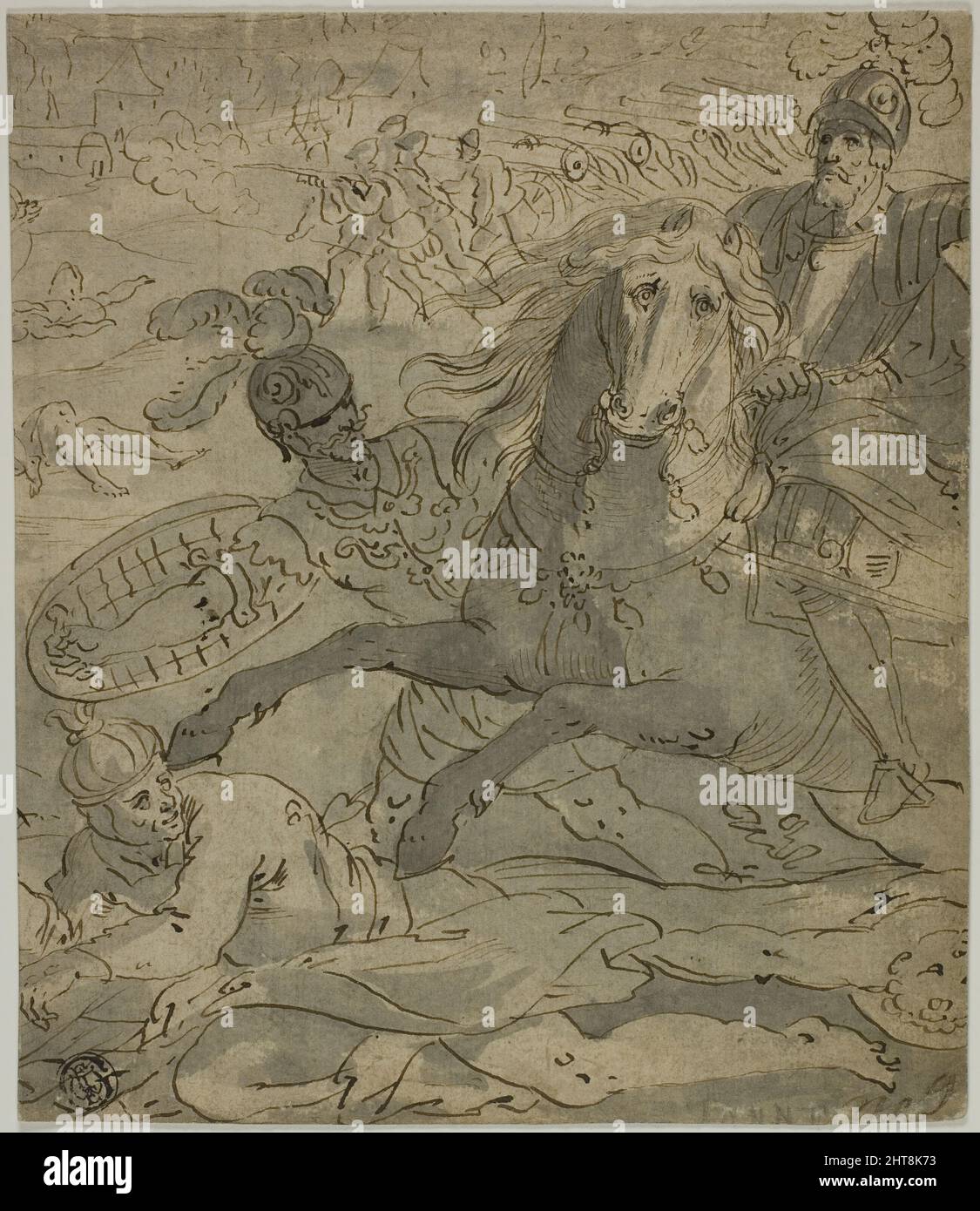 Battle Scene with Charging General on Horseback in Foreground, Artillery and Cannons in Background, n.d. Stock Photohttps://www.alamy.com/image-license-details/?v=1https://www.alamy.com/battle-scene-with-charging-general-on-horseback-in-foreground-artillery-and-cannons-in-background-nd-image462412023.html
Battle Scene with Charging General on Horseback in Foreground, Artillery and Cannons in Background, n.d. Stock Photohttps://www.alamy.com/image-license-details/?v=1https://www.alamy.com/battle-scene-with-charging-general-on-horseback-in-foreground-artillery-and-cannons-in-background-nd-image462412023.htmlRM2HT8K73–Battle Scene with Charging General on Horseback in Foreground, Artillery and Cannons in Background, n.d.
![Surrender of the Flemish cities, 1706, Siegreiche Länder und Stätt Ernde (title on object), Surrender of ten cities in Flanders and Brabant after the victory of the Allies in the battle of Ramillies. In the central scene the surrender of Brussels, in a richly decorated ornamental frame with cartouches with the other nine cities that surrendered, at the top Bruges. At the bottom a cartouche with the description of the events in German. Sheet in the bound collection of records released under the title: Repraesentatio belli ... Der Spanische Successions-Krieg [ca. 1720]., print, print maker Stock Photo Surrender of the Flemish cities, 1706, Siegreiche Länder und Stätt Ernde (title on object), Surrender of ten cities in Flanders and Brabant after the victory of the Allies in the battle of Ramillies. In the central scene the surrender of Brussels, in a richly decorated ornamental frame with cartouches with the other nine cities that surrendered, at the top Bruges. At the bottom a cartouche with the description of the events in German. Sheet in the bound collection of records released under the title: Repraesentatio belli ... Der Spanische Successions-Krieg [ca. 1720]., print, print maker Stock Photo](https://c8.alamy.com/comp/2X6Y0PY/surrender-of-the-flemish-cities-1706-siegreiche-lnder-und-sttt-ernde-title-on-object-surrender-of-ten-cities-in-flanders-and-brabant-after-the-victory-of-the-allies-in-the-battle-of-ramillies-in-the-central-scene-the-surrender-of-brussels-in-a-richly-decorated-ornamental-frame-with-cartouches-with-the-other-nine-cities-that-surrendered-at-the-top-bruges-at-the-bottom-a-cartouche-with-the-description-of-the-events-in-german-sheet-in-the-bound-collection-of-records-released-under-the-title-repraesentatio-belli-der-spanische-successions-krieg-ca-1720-print-print-maker-2X6Y0PY.jpg) Surrender of the Flemish cities, 1706, Siegreiche Länder und Stätt Ernde (title on object), Surrender of ten cities in Flanders and Brabant after the victory of the Allies in the battle of Ramillies. In the central scene the surrender of Brussels, in a richly decorated ornamental frame with cartouches with the other nine cities that surrendered, at the top Bruges. At the bottom a cartouche with the description of the events in German. Sheet in the bound collection of records released under the title: Repraesentatio belli ... Der Spanische Successions-Krieg [ca. 1720]., print, print maker Stock Photohttps://www.alamy.com/image-license-details/?v=1https://www.alamy.com/surrender-of-the-flemish-cities-1706-siegreiche-lnder-und-sttt-ernde-title-on-object-surrender-of-ten-cities-in-flanders-and-brabant-after-the-victory-of-the-allies-in-the-battle-of-ramillies-in-the-central-scene-the-surrender-of-brussels-in-a-richly-decorated-ornamental-frame-with-cartouches-with-the-other-nine-cities-that-surrendered-at-the-top-bruges-at-the-bottom-a-cartouche-with-the-description-of-the-events-in-german-sheet-in-the-bound-collection-of-records-released-under-the-title-repraesentatio-belli-der-spanische-successions-krieg-ca-1720-print-print-maker-image606644163.html
Surrender of the Flemish cities, 1706, Siegreiche Länder und Stätt Ernde (title on object), Surrender of ten cities in Flanders and Brabant after the victory of the Allies in the battle of Ramillies. In the central scene the surrender of Brussels, in a richly decorated ornamental frame with cartouches with the other nine cities that surrendered, at the top Bruges. At the bottom a cartouche with the description of the events in German. Sheet in the bound collection of records released under the title: Repraesentatio belli ... Der Spanische Successions-Krieg [ca. 1720]., print, print maker Stock Photohttps://www.alamy.com/image-license-details/?v=1https://www.alamy.com/surrender-of-the-flemish-cities-1706-siegreiche-lnder-und-sttt-ernde-title-on-object-surrender-of-ten-cities-in-flanders-and-brabant-after-the-victory-of-the-allies-in-the-battle-of-ramillies-in-the-central-scene-the-surrender-of-brussels-in-a-richly-decorated-ornamental-frame-with-cartouches-with-the-other-nine-cities-that-surrendered-at-the-top-bruges-at-the-bottom-a-cartouche-with-the-description-of-the-events-in-german-sheet-in-the-bound-collection-of-records-released-under-the-title-repraesentatio-belli-der-spanische-successions-krieg-ca-1720-print-print-maker-image606644163.htmlRM2X6Y0PY–Surrender of the Flemish cities, 1706, Siegreiche Länder und Stätt Ernde (title on object), Surrender of ten cities in Flanders and Brabant after the victory of the Allies in the battle of Ramillies. In the central scene the surrender of Brussels, in a richly decorated ornamental frame with cartouches with the other nine cities that surrendered, at the top Bruges. At the bottom a cartouche with the description of the events in German. Sheet in the bound collection of records released under the title: Repraesentatio belli ... Der Spanische Successions-Krieg [ca. 1720]., print, print maker
 French Trenches destroyed by heavy artillery bombardment in Belgium during the fall of 1917. A deep shell hole in the foreground is filled with water. The French and British won the battle of Flanders through miles of pitted country. Photograph taken near Bar Le Duc, France in 1919, showing French soldiers drawing water from a public well for a nearby hospital. Photograph number 2002, taken by photographer Red P.0.243. Stock Photohttps://www.alamy.com/image-license-details/?v=1https://www.alamy.com/french-trenches-destroyed-by-heavy-artillery-bombardment-in-belgium-during-the-fall-of-1917-a-deep-shell-hole-in-the-foreground-is-filled-with-water-the-french-and-british-won-the-battle-of-flanders-through-miles-of-pitted-country-photograph-taken-near-bar-le-duc-france-in-1919-showing-french-soldiers-drawing-water-from-a-public-well-for-a-nearby-hospital-photograph-number-2002-taken-by-photographer-red-p0243-image558348209.html
French Trenches destroyed by heavy artillery bombardment in Belgium during the fall of 1917. A deep shell hole in the foreground is filled with water. The French and British won the battle of Flanders through miles of pitted country. Photograph taken near Bar Le Duc, France in 1919, showing French soldiers drawing water from a public well for a nearby hospital. Photograph number 2002, taken by photographer Red P.0.243. Stock Photohttps://www.alamy.com/image-license-details/?v=1https://www.alamy.com/french-trenches-destroyed-by-heavy-artillery-bombardment-in-belgium-during-the-fall-of-1917-a-deep-shell-hole-in-the-foreground-is-filled-with-water-the-french-and-british-won-the-battle-of-flanders-through-miles-of-pitted-country-photograph-taken-near-bar-le-duc-france-in-1919-showing-french-soldiers-drawing-water-from-a-public-well-for-a-nearby-hospital-photograph-number-2002-taken-by-photographer-red-p0243-image558348209.htmlRM2RCAXRD–French Trenches destroyed by heavy artillery bombardment in Belgium during the fall of 1917. A deep shell hole in the foreground is filled with water. The French and British won the battle of Flanders through miles of pitted country. Photograph taken near Bar Le Duc, France in 1919, showing French soldiers drawing water from a public well for a nearby hospital. Photograph number 2002, taken by photographer Red P.0.243.
 The French king Philip IV the Fair defeats the count of Flanders at Veurne (Furnes) in 1296. The print shows the battle, the fleeing armies of Guy van Stock Photohttps://www.alamy.com/image-license-details/?v=1https://www.alamy.com/the-french-king-philip-iv-the-fair-defeats-the-count-of-flanders-at-veurne-furnes-in-1296-the-print-shows-the-battle-the-fleeing-armies-of-guy-van-image488036688.html
The French king Philip IV the Fair defeats the count of Flanders at Veurne (Furnes) in 1296. The print shows the battle, the fleeing armies of Guy van Stock Photohttps://www.alamy.com/image-license-details/?v=1https://www.alamy.com/the-french-king-philip-iv-the-fair-defeats-the-count-of-flanders-at-veurne-furnes-in-1296-the-print-shows-the-battle-the-fleeing-armies-of-guy-van-image488036688.htmlRF2K9YYNM–The French king Philip IV the Fair defeats the count of Flanders at Veurne (Furnes) in 1296. The print shows the battle, the fleeing armies of Guy van
 Pictural Plan of the grand EXPEDITION, in the WEST SCHELDT, August 1809; showing the difficulty of approach to Antwerp. A high oblique view of the Scheldt between Bath and Antwerp showing the British combined operations on the expedition to Walcheren, and the situation of the French navy, August 1809. Napoleonic Wars (1803-15). Stock Photohttps://www.alamy.com/image-license-details/?v=1https://www.alamy.com/pictural-plan-of-the-grand-expedition-in-the-west-scheldt-august-1809-showing-the-difficulty-of-approach-to-antwerp-a-high-oblique-view-of-the-scheldt-between-bath-and-antwerp-showing-the-british-combined-operations-on-the-expedition-to-walcheren-and-the-situation-of-the-french-navy-august-1809-napoleonic-wars-1803-15-image476375109.html
Pictural Plan of the grand EXPEDITION, in the WEST SCHELDT, August 1809; showing the difficulty of approach to Antwerp. A high oblique view of the Scheldt between Bath and Antwerp showing the British combined operations on the expedition to Walcheren, and the situation of the French navy, August 1809. Napoleonic Wars (1803-15). Stock Photohttps://www.alamy.com/image-license-details/?v=1https://www.alamy.com/pictural-plan-of-the-grand-expedition-in-the-west-scheldt-august-1809-showing-the-difficulty-of-approach-to-antwerp-a-high-oblique-view-of-the-scheldt-between-bath-and-antwerp-showing-the-british-combined-operations-on-the-expedition-to-walcheren-and-the-situation-of-the-french-navy-august-1809-napoleonic-wars-1803-15-image476375109.htmlRF2JK0N8N–Pictural Plan of the grand EXPEDITION, in the WEST SCHELDT, August 1809; showing the difficulty of approach to Antwerp. A high oblique view of the Scheldt between Bath and Antwerp showing the British combined operations on the expedition to Walcheren, and the situation of the French navy, August 1809. Napoleonic Wars (1803-15).
![In Flanders; The Yser offensive (1917), French front line near Het-Sas, before the advance march of July 31.', 1917. From "L'Album de la Guerre 1914-1919, Volume 2" [L 'Illustration, Paris, 1924]. Stock Photo In Flanders; The Yser offensive (1917), French front line near Het-Sas, before the advance march of July 31.', 1917. From "L'Album de la Guerre 1914-1919, Volume 2" [L 'Illustration, Paris, 1924]. Stock Photo](https://c8.alamy.com/comp/2RRJENK/in-flanders-the-yser-offensive-1917-french-front-line-near-het-sas-before-the-advance-march-of-july-31-1917-from-quotlalbum-de-la-guerre-1914-1919-volume-2quot-l-illustration-paris-1924-2RRJENK.jpg) In Flanders; The Yser offensive (1917), French front line near Het-Sas, before the advance march of July 31.', 1917. From "L'Album de la Guerre 1914-1919, Volume 2" [L 'Illustration, Paris, 1924]. Stock Photohttps://www.alamy.com/image-license-details/?v=1https://www.alamy.com/in-flanders-the-yser-offensive-1917-french-front-line-near-het-sas-before-the-advance-march-of-july-31-1917-from-quotlalbum-de-la-guerre-1914-1919-volume-2quot-l-illustration-paris-1924-image565275583.html
In Flanders; The Yser offensive (1917), French front line near Het-Sas, before the advance march of July 31.', 1917. From "L'Album de la Guerre 1914-1919, Volume 2" [L 'Illustration, Paris, 1924]. Stock Photohttps://www.alamy.com/image-license-details/?v=1https://www.alamy.com/in-flanders-the-yser-offensive-1917-french-front-line-near-het-sas-before-the-advance-march-of-july-31-1917-from-quotlalbum-de-la-guerre-1914-1919-volume-2quot-l-illustration-paris-1924-image565275583.htmlRM2RRJENK–In Flanders; The Yser offensive (1917), French front line near Het-Sas, before the advance march of July 31.', 1917. From "L'Album de la Guerre 1914-1919, Volume 2" [L 'Illustration, Paris, 1924].
 A German field postcard from World War I shows destroyed buildings in Diskmuide in West Flanders, Belgium, in 1915. Fotoarchiv für Zeitgeschichte Stock Photohttps://www.alamy.com/image-license-details/?v=1https://www.alamy.com/a-german-field-postcard-from-world-war-i-shows-destroyed-buildings-image65352264.html
A German field postcard from World War I shows destroyed buildings in Diskmuide in West Flanders, Belgium, in 1915. Fotoarchiv für Zeitgeschichte Stock Photohttps://www.alamy.com/image-license-details/?v=1https://www.alamy.com/a-german-field-postcard-from-world-war-i-shows-destroyed-buildings-image65352264.htmlRMDP91DC–A German field postcard from World War I shows destroyed buildings in Diskmuide in West Flanders, Belgium, in 1915. Fotoarchiv für Zeitgeschichte
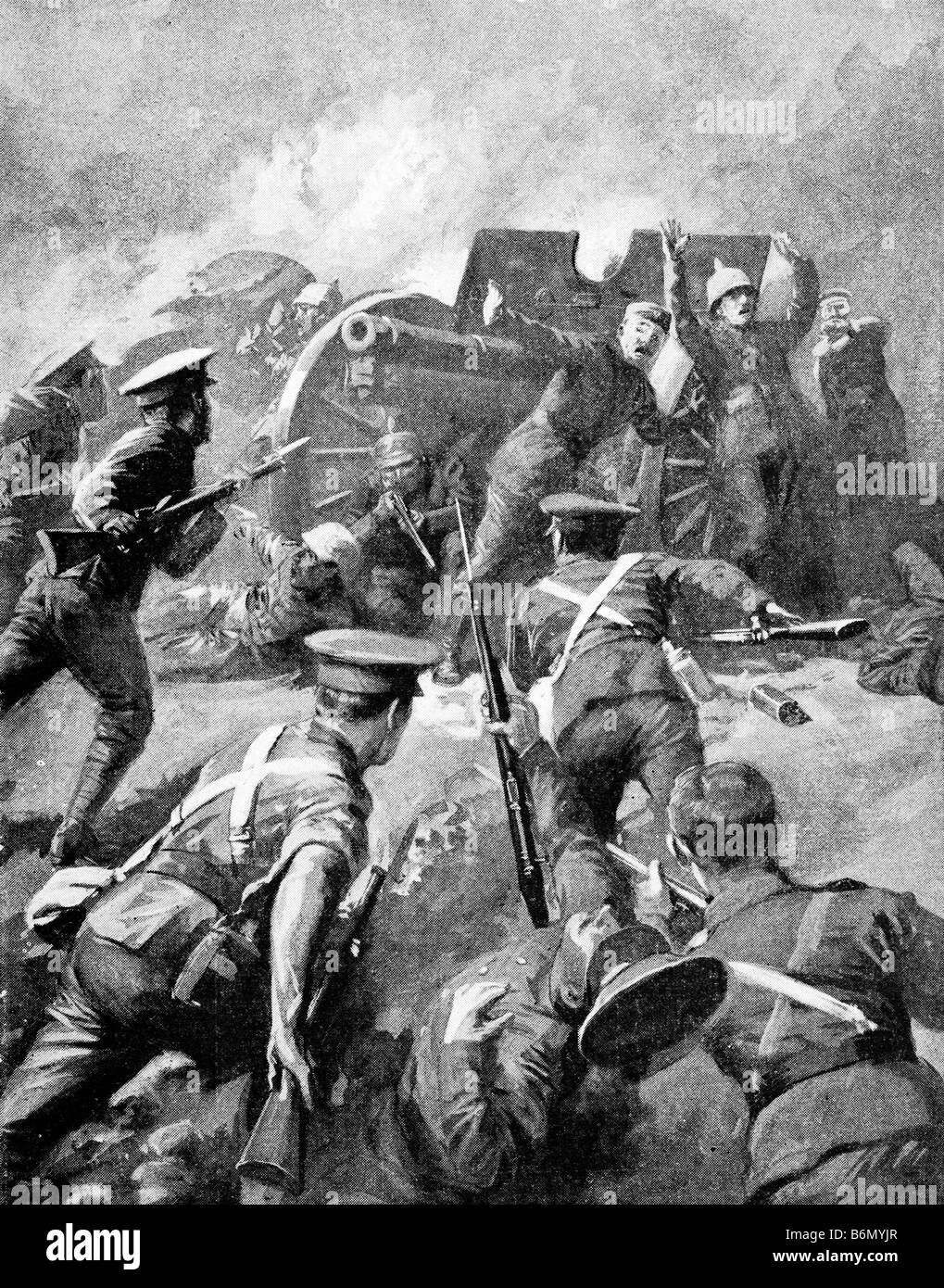 Contemporary World War One illustration of a German artillery crew surrendering in the face of a charge by Allied soldiers. Stock Photohttps://www.alamy.com/image-license-details/?v=1https://www.alamy.com/stock-photo-contemporary-world-war-one-illustration-of-a-german-artillery-crew-21359039.html
Contemporary World War One illustration of a German artillery crew surrendering in the face of a charge by Allied soldiers. Stock Photohttps://www.alamy.com/image-license-details/?v=1https://www.alamy.com/stock-photo-contemporary-world-war-one-illustration-of-a-german-artillery-crew-21359039.htmlRMB6MYJR–Contemporary World War One illustration of a German artillery crew surrendering in the face of a charge by Allied soldiers.
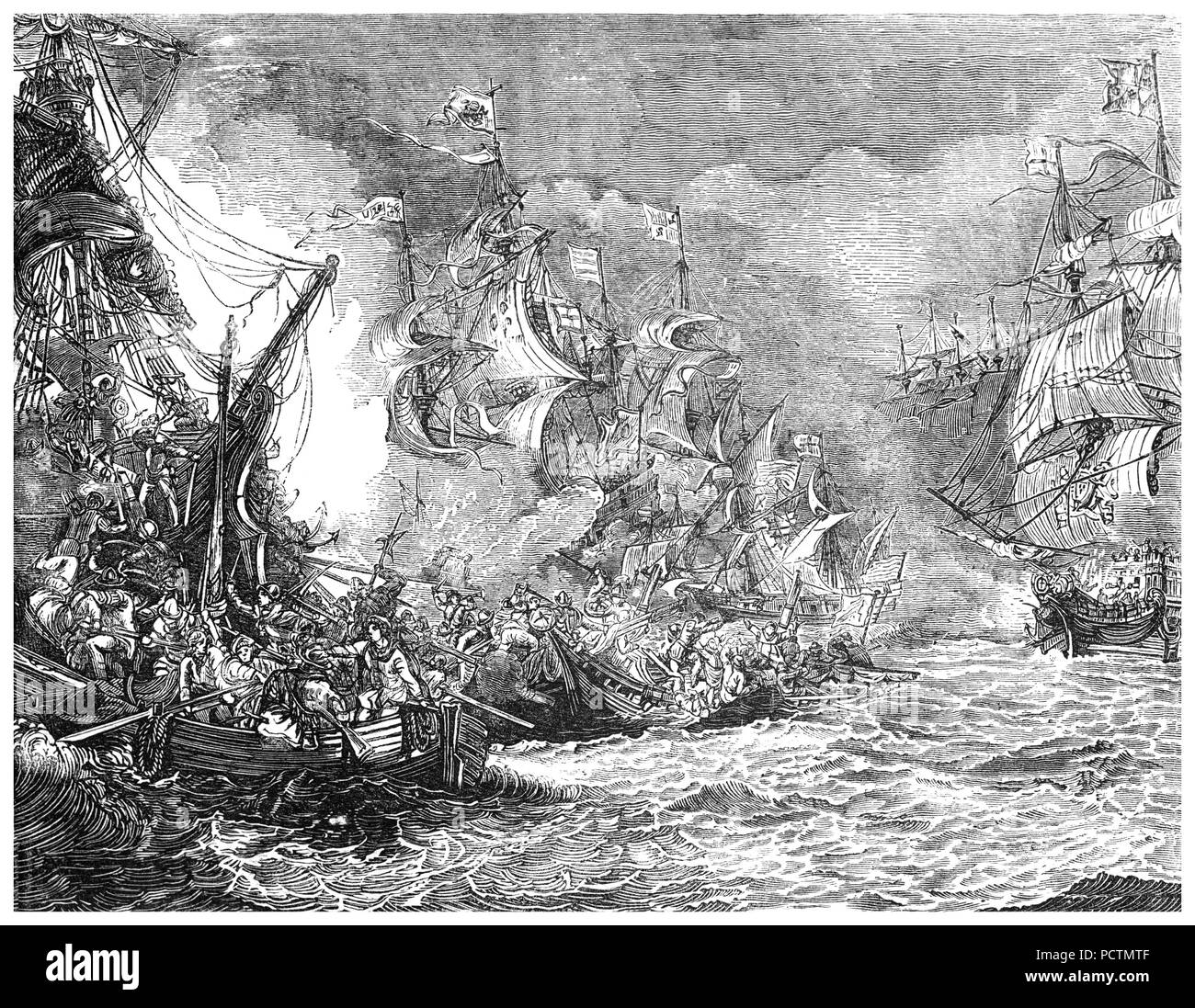 The Spanish Armada under attack from the English fleet during the largest engagement of the undeclared Anglo-Spanish War (1585–1604). The Spanish fleet of 130 ships sailed f in late May 1588, with the aim of escorting an army from Flanders to invade England and overthrow Queen Elizabeth I and her establishment of Protestantism in England. The Armada anchored off Calais, but was scattered by an English fireship attack. Following the ensuing Battle of Gravelines the Spanish fleet was forced to return to Spain. Stock Photohttps://www.alamy.com/image-license-details/?v=1https://www.alamy.com/the-spanish-armada-under-attack-from-the-english-fleet-during-the-largest-engagement-of-the-undeclared-anglo-spanish-war-15851604-the-spanish-fleet-of-130-ships-sailed-f-in-late-may-1588-with-the-aim-of-escorting-an-army-from-flanders-to-invade-england-and-overthrow-queen-elizabeth-i-and-her-establishment-of-protestantism-in-england-the-armada-anchored-off-calais-but-was-scattered-by-an-english-fireship-attack-following-the-ensuing-battle-of-gravelines-the-spanish-fleet-was-forced-to-return-to-spain-image214443503.html
The Spanish Armada under attack from the English fleet during the largest engagement of the undeclared Anglo-Spanish War (1585–1604). The Spanish fleet of 130 ships sailed f in late May 1588, with the aim of escorting an army from Flanders to invade England and overthrow Queen Elizabeth I and her establishment of Protestantism in England. The Armada anchored off Calais, but was scattered by an English fireship attack. Following the ensuing Battle of Gravelines the Spanish fleet was forced to return to Spain. Stock Photohttps://www.alamy.com/image-license-details/?v=1https://www.alamy.com/the-spanish-armada-under-attack-from-the-english-fleet-during-the-largest-engagement-of-the-undeclared-anglo-spanish-war-15851604-the-spanish-fleet-of-130-ships-sailed-f-in-late-may-1588-with-the-aim-of-escorting-an-army-from-flanders-to-invade-england-and-overthrow-queen-elizabeth-i-and-her-establishment-of-protestantism-in-england-the-armada-anchored-off-calais-but-was-scattered-by-an-english-fireship-attack-following-the-ensuing-battle-of-gravelines-the-spanish-fleet-was-forced-to-return-to-spain-image214443503.htmlRMPCTMTF–The Spanish Armada under attack from the English fleet during the largest engagement of the undeclared Anglo-Spanish War (1585–1604). The Spanish fleet of 130 ships sailed f in late May 1588, with the aim of escorting an army from Flanders to invade England and overthrow Queen Elizabeth I and her establishment of Protestantism in England. The Armada anchored off Calais, but was scattered by an English fireship attack. Following the ensuing Battle of Gravelines the Spanish fleet was forced to return to Spain.
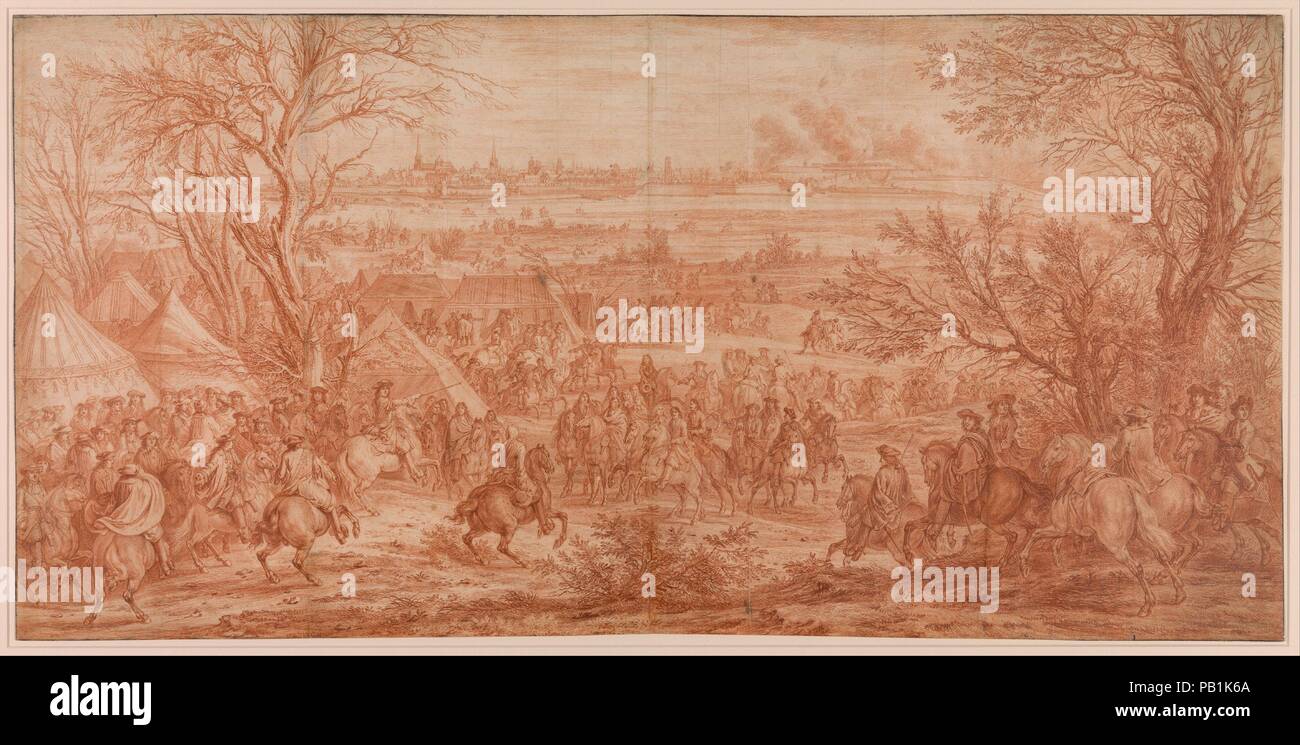 Louis XIV at the Siege of Cambrai, Seen from the South-West (March 20-April 19, 1677). Artist: studio of Adam Frans van der Meulen (Flemish, Brussels 1632-1690 Paris). Dimensions: 18 1/2 × 37 9/16 in. (47 × 95.4 cm). Date: probably 1680s. Flemish by birth and training, Adam Frans van der Meulen, called to Paris in 1664, owes his reputation to the battle scenes commemorating Louis XIV's military exploits. As 'Ordinary Painter of the King's Conquests', Van der Meulen joined the French army on its campaigns, painstakingly recording the subjugated towns on paper. On the basis of such drawings, Va Stock Photohttps://www.alamy.com/image-license-details/?v=1https://www.alamy.com/louis-xiv-at-the-siege-of-cambrai-seen-from-the-south-west-march-20-april-19-1677-artist-studio-of-adam-frans-van-der-meulen-flemish-brussels-1632-1690-paris-dimensions-18-12-37-916-in-47-954-cm-date-probably-1680s-flemish-by-birth-and-training-adam-frans-van-der-meulen-called-to-paris-in-1664-owes-his-reputation-to-the-battle-scenes-commemorating-louis-xivs-military-exploits-as-ordinary-painter-of-the-kings-conquests-van-der-meulen-joined-the-french-army-on-its-campaigns-painstakingly-recording-the-subjugated-towns-on-paper-on-the-basis-of-such-drawings-va-image213322658.html
Louis XIV at the Siege of Cambrai, Seen from the South-West (March 20-April 19, 1677). Artist: studio of Adam Frans van der Meulen (Flemish, Brussels 1632-1690 Paris). Dimensions: 18 1/2 × 37 9/16 in. (47 × 95.4 cm). Date: probably 1680s. Flemish by birth and training, Adam Frans van der Meulen, called to Paris in 1664, owes his reputation to the battle scenes commemorating Louis XIV's military exploits. As 'Ordinary Painter of the King's Conquests', Van der Meulen joined the French army on its campaigns, painstakingly recording the subjugated towns on paper. On the basis of such drawings, Va Stock Photohttps://www.alamy.com/image-license-details/?v=1https://www.alamy.com/louis-xiv-at-the-siege-of-cambrai-seen-from-the-south-west-march-20-april-19-1677-artist-studio-of-adam-frans-van-der-meulen-flemish-brussels-1632-1690-paris-dimensions-18-12-37-916-in-47-954-cm-date-probably-1680s-flemish-by-birth-and-training-adam-frans-van-der-meulen-called-to-paris-in-1664-owes-his-reputation-to-the-battle-scenes-commemorating-louis-xivs-military-exploits-as-ordinary-painter-of-the-kings-conquests-van-der-meulen-joined-the-french-army-on-its-campaigns-painstakingly-recording-the-subjugated-towns-on-paper-on-the-basis-of-such-drawings-va-image213322658.htmlRMPB1K6A–Louis XIV at the Siege of Cambrai, Seen from the South-West (March 20-April 19, 1677). Artist: studio of Adam Frans van der Meulen (Flemish, Brussels 1632-1690 Paris). Dimensions: 18 1/2 × 37 9/16 in. (47 × 95.4 cm). Date: probably 1680s. Flemish by birth and training, Adam Frans van der Meulen, called to Paris in 1664, owes his reputation to the battle scenes commemorating Louis XIV's military exploits. As 'Ordinary Painter of the King's Conquests', Van der Meulen joined the French army on its campaigns, painstakingly recording the subjugated towns on paper. On the basis of such drawings, Va
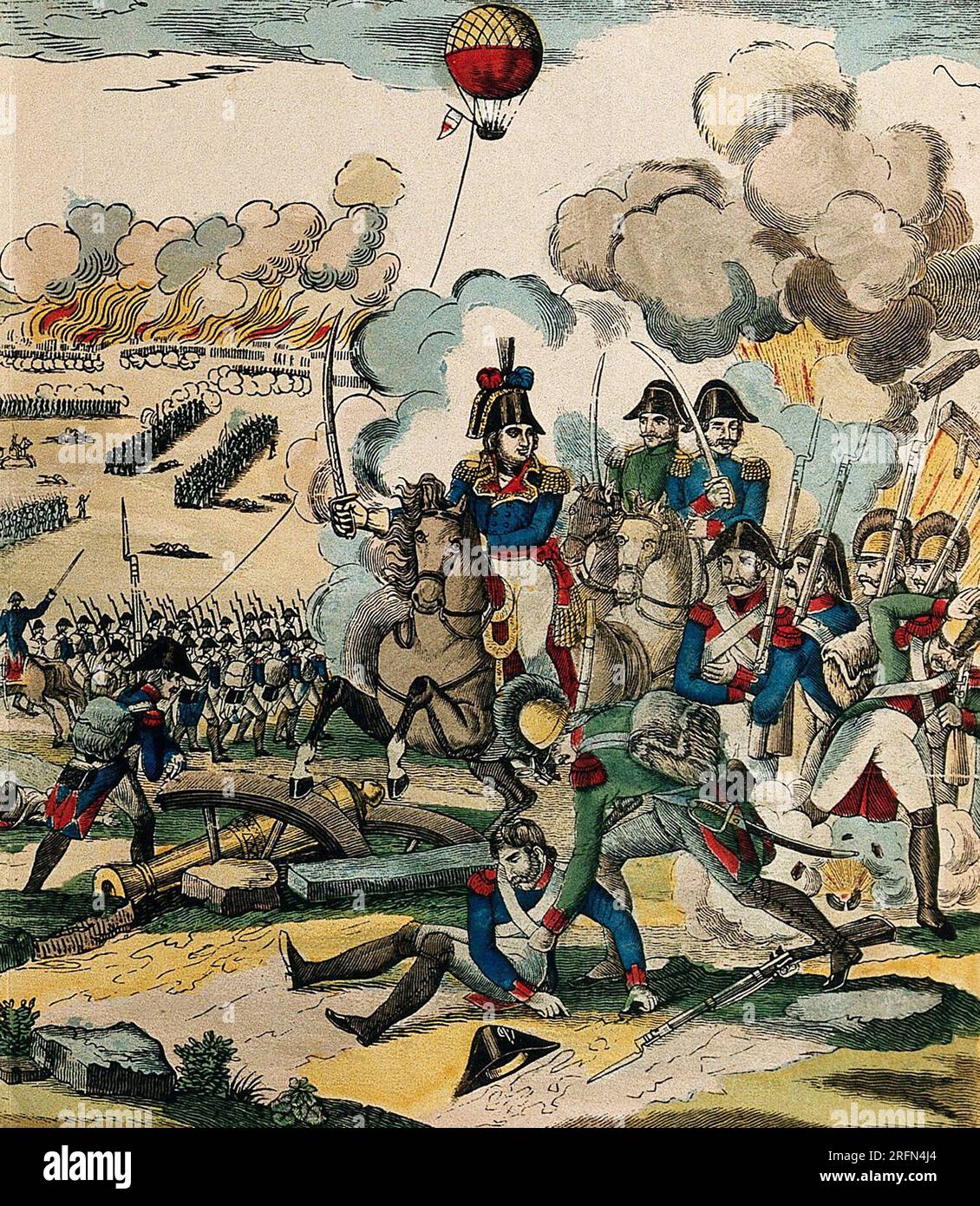 The Battle of Fleurus, 26 June 1794, during the War of the First Coalition, between the First French Republic and the Coalition army (Britain, Hanover, Dutch Republic, and Habsburg monarchy). This was the most significant battle of the Flanders Campaign in the Low Countries during the French Revolutionary Wars. Note the observation balloon in the background. Stock Photohttps://www.alamy.com/image-license-details/?v=1https://www.alamy.com/the-battle-of-fleurus-26-june-1794-during-the-war-of-the-first-coalition-between-the-first-french-republic-and-the-coalition-army-britain-hanover-dutch-republic-and-habsburg-monarchy-this-was-the-most-significant-battle-of-the-flanders-campaign-in-the-low-countries-during-the-french-revolutionary-wars-note-the-observation-balloon-in-the-background-image560416252.html
The Battle of Fleurus, 26 June 1794, during the War of the First Coalition, between the First French Republic and the Coalition army (Britain, Hanover, Dutch Republic, and Habsburg monarchy). This was the most significant battle of the Flanders Campaign in the Low Countries during the French Revolutionary Wars. Note the observation balloon in the background. Stock Photohttps://www.alamy.com/image-license-details/?v=1https://www.alamy.com/the-battle-of-fleurus-26-june-1794-during-the-war-of-the-first-coalition-between-the-first-french-republic-and-the-coalition-army-britain-hanover-dutch-republic-and-habsburg-monarchy-this-was-the-most-significant-battle-of-the-flanders-campaign-in-the-low-countries-during-the-french-revolutionary-wars-note-the-observation-balloon-in-the-background-image560416252.htmlRF2RFN4J4–The Battle of Fleurus, 26 June 1794, during the War of the First Coalition, between the First French Republic and the Coalition army (Britain, Hanover, Dutch Republic, and Habsburg monarchy). This was the most significant battle of the Flanders Campaign in the Low Countries during the French Revolutionary Wars. Note the observation balloon in the background.
 Robert Curthose(1051–1134), son of William the Conqueror, was Duke of Normandy from 1087 until 1106 and an unsuccessful claimant to the English throne. He fled to the court of his uncle Robert I, Count of Flanders, but caused mayhem. At a battle in January 1079, Robert unhorsed King William in combat and succeeded in wounding him. He stopped his attack when he recognised his father's voice. King William cursed his son, then raised the siege and returned to Rouen. At Easter 1080, father and son were reunited by the efforts of Queen Matilda, and a truce lasted until she died in 1083. Stock Photohttps://www.alamy.com/image-license-details/?v=1https://www.alamy.com/robert-curthose10511134-son-of-william-the-conqueror-was-duke-of-normandy-from-1087-until-1106-and-an-unsuccessful-claimant-to-the-english-throne-he-fled-to-the-court-of-his-uncle-robert-i-count-of-flanders-but-caused-mayhem-at-a-battle-in-january-1079-robert-unhorsed-king-william-in-combat-and-succeeded-in-wounding-him-he-stopped-his-attack-when-he-recognised-his-fathers-voice-king-william-cursed-his-son-then-raised-the-siege-and-returned-to-rouen-at-easter-1080-father-and-son-were-reunited-by-the-efforts-of-queen-matilda-and-a-truce-lasted-until-she-died-in-1083-image185844819.html
Robert Curthose(1051–1134), son of William the Conqueror, was Duke of Normandy from 1087 until 1106 and an unsuccessful claimant to the English throne. He fled to the court of his uncle Robert I, Count of Flanders, but caused mayhem. At a battle in January 1079, Robert unhorsed King William in combat and succeeded in wounding him. He stopped his attack when he recognised his father's voice. King William cursed his son, then raised the siege and returned to Rouen. At Easter 1080, father and son were reunited by the efforts of Queen Matilda, and a truce lasted until she died in 1083. Stock Photohttps://www.alamy.com/image-license-details/?v=1https://www.alamy.com/robert-curthose10511134-son-of-william-the-conqueror-was-duke-of-normandy-from-1087-until-1106-and-an-unsuccessful-claimant-to-the-english-throne-he-fled-to-the-court-of-his-uncle-robert-i-count-of-flanders-but-caused-mayhem-at-a-battle-in-january-1079-robert-unhorsed-king-william-in-combat-and-succeeded-in-wounding-him-he-stopped-his-attack-when-he-recognised-his-fathers-voice-king-william-cursed-his-son-then-raised-the-siege-and-returned-to-rouen-at-easter-1080-father-and-son-were-reunited-by-the-efforts-of-queen-matilda-and-a-truce-lasted-until-she-died-in-1083-image185844819.htmlRMMP9XXY–Robert Curthose(1051–1134), son of William the Conqueror, was Duke of Normandy from 1087 until 1106 and an unsuccessful claimant to the English throne. He fled to the court of his uncle Robert I, Count of Flanders, but caused mayhem. At a battle in January 1079, Robert unhorsed King William in combat and succeeded in wounding him. He stopped his attack when he recognised his father's voice. King William cursed his son, then raised the siege and returned to Rouen. At Easter 1080, father and son were reunited by the efforts of Queen Matilda, and a truce lasted until she died in 1083.
 Contemporary WW1 illustration of a British private in hand to hand combat with German soldiers at Ypres in Flanders in 1917. Stock Photohttps://www.alamy.com/image-license-details/?v=1https://www.alamy.com/stock-photo-contemporary-ww1-illustration-of-a-british-private-in-hand-to-hand-27092291.html
Contemporary WW1 illustration of a British private in hand to hand combat with German soldiers at Ypres in Flanders in 1917. Stock Photohttps://www.alamy.com/image-license-details/?v=1https://www.alamy.com/stock-photo-contemporary-ww1-illustration-of-a-british-private-in-hand-to-hand-27092291.htmlRMBG24DR–Contemporary WW1 illustration of a British private in hand to hand combat with German soldiers at Ypres in Flanders in 1917.
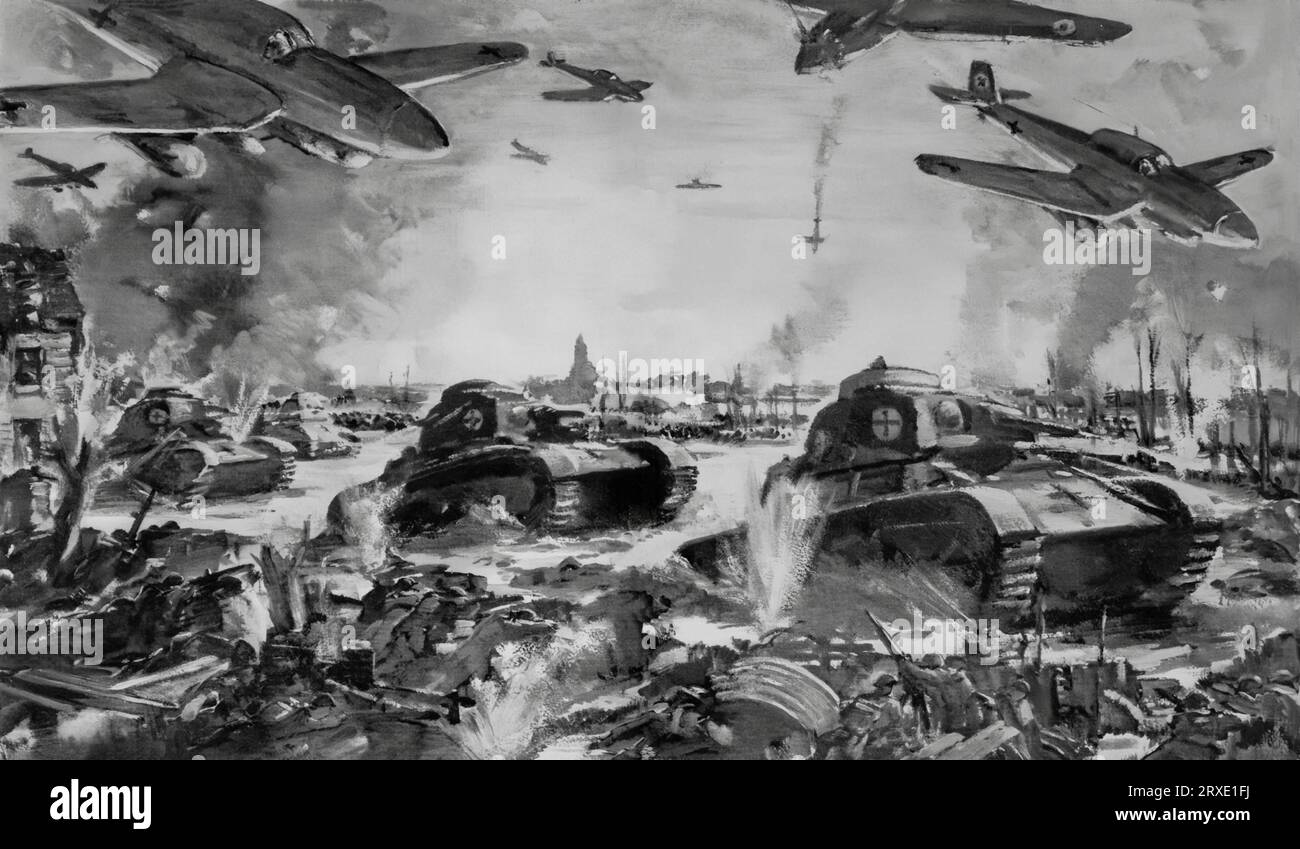 An illustration of the German Blitzkrieg in Flanders, Belgium, May 1940., by Charles Ernest Cundall, British artist. The surprise attack used a rapid, overwhelming force concentration of armoured and motorised or mechanised infantry formations, together with artillery, air assault and close air support. Stock Photohttps://www.alamy.com/image-license-details/?v=1https://www.alamy.com/an-illustration-of-the-german-blitzkrieg-in-flanders-belgium-may-1940-by-charles-ernest-cundall-british-artist-the-surprise-attack-used-a-rapid-overwhelming-force-concentration-of-armoured-and-motorised-or-mechanised-infantry-formations-together-with-artillery-air-assault-and-close-air-support-image567021382.html
An illustration of the German Blitzkrieg in Flanders, Belgium, May 1940., by Charles Ernest Cundall, British artist. The surprise attack used a rapid, overwhelming force concentration of armoured and motorised or mechanised infantry formations, together with artillery, air assault and close air support. Stock Photohttps://www.alamy.com/image-license-details/?v=1https://www.alamy.com/an-illustration-of-the-german-blitzkrieg-in-flanders-belgium-may-1940-by-charles-ernest-cundall-british-artist-the-surprise-attack-used-a-rapid-overwhelming-force-concentration-of-armoured-and-motorised-or-mechanised-infantry-formations-together-with-artillery-air-assault-and-close-air-support-image567021382.htmlRM2RXE1FJ–An illustration of the German Blitzkrieg in Flanders, Belgium, May 1940., by Charles Ernest Cundall, British artist. The surprise attack used a rapid, overwhelming force concentration of armoured and motorised or mechanised infantry formations, together with artillery, air assault and close air support.
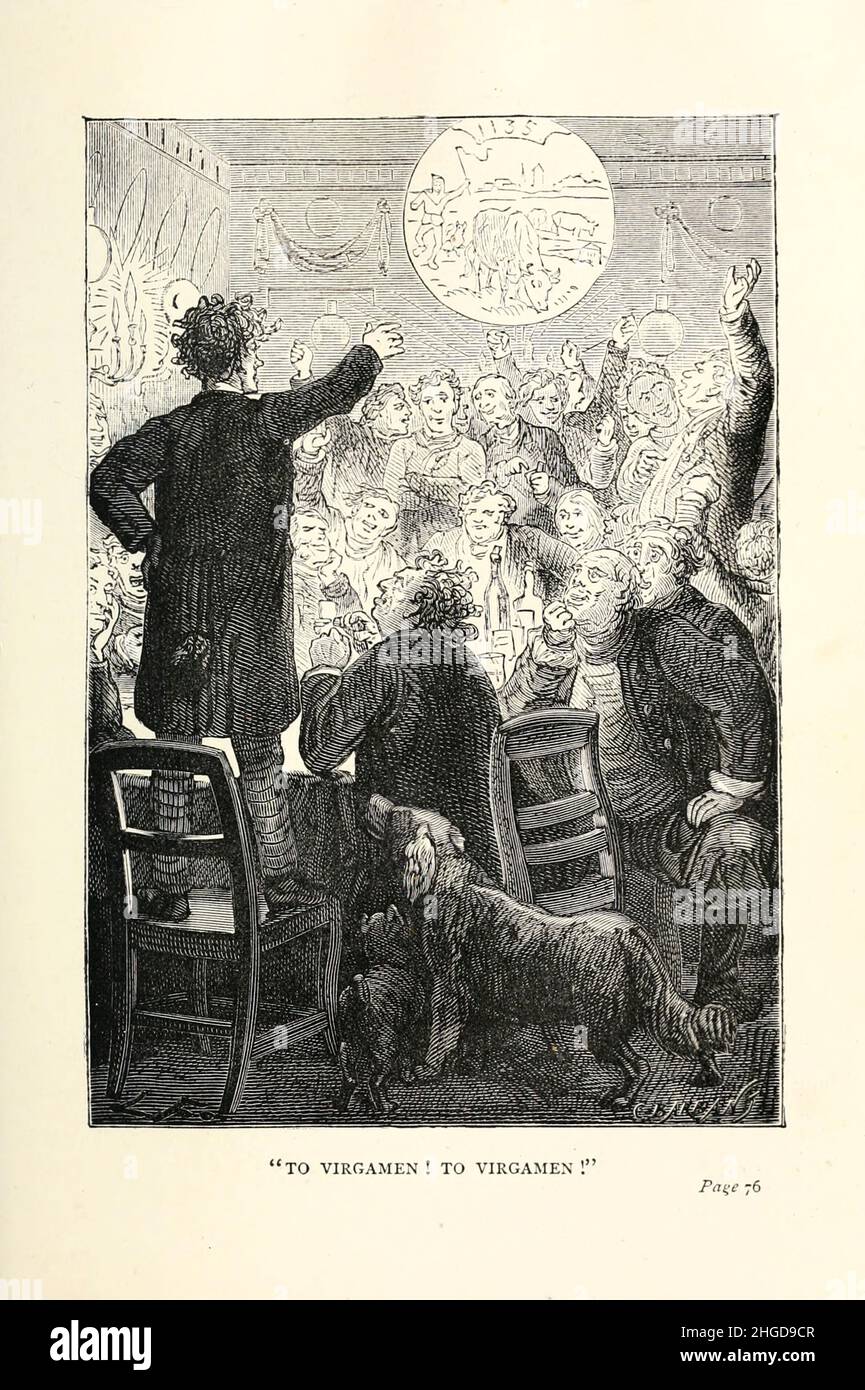 To Virgamen ! to Virgamen ! from Dr. Ox's Experiment (French: Une fantaisie du docteur Ox, 'A Fantasy of Doctor Ox') is a humorous science fiction short story by the French writer Jules Verne, published in 1872. It describes an experiment by one Dr. Ox, and is inspired by the real or alleged effects of oxygen on living things. The setting of the story is the imaginary village of Quiquendone in West Flanders (Belgium) whose citizens are described as 'well-to-do folks, wise, prudent, sociable, with even tempers, hospitable, perhaps a bit heavy in conversation as in mind'; A scientist Dr. Ox come Stock Photohttps://www.alamy.com/image-license-details/?v=1https://www.alamy.com/to-virgamen-!-to-virgamen-!-from-dr-oxs-experiment-french-une-fantaisie-du-docteur-ox-a-fantasy-of-doctor-ox-is-a-humorous-science-fiction-short-story-by-the-french-writer-jules-verne-published-in-1872-it-describes-an-experiment-by-one-dr-ox-and-is-inspired-by-the-real-or-alleged-effects-of-oxygen-on-living-things-the-setting-of-the-story-is-the-imaginary-village-of-quiquendone-in-west-flanders-belgium-whose-citizens-are-described-as-well-to-do-folks-wise-prudent-sociable-with-even-tempers-hospitable-perhaps-a-bit-heavy-in-conversation-as-in-mind-a-scientist-dr-ox-come-image457596855.html
To Virgamen ! to Virgamen ! from Dr. Ox's Experiment (French: Une fantaisie du docteur Ox, 'A Fantasy of Doctor Ox') is a humorous science fiction short story by the French writer Jules Verne, published in 1872. It describes an experiment by one Dr. Ox, and is inspired by the real or alleged effects of oxygen on living things. The setting of the story is the imaginary village of Quiquendone in West Flanders (Belgium) whose citizens are described as 'well-to-do folks, wise, prudent, sociable, with even tempers, hospitable, perhaps a bit heavy in conversation as in mind'; A scientist Dr. Ox come Stock Photohttps://www.alamy.com/image-license-details/?v=1https://www.alamy.com/to-virgamen-!-to-virgamen-!-from-dr-oxs-experiment-french-une-fantaisie-du-docteur-ox-a-fantasy-of-doctor-ox-is-a-humorous-science-fiction-short-story-by-the-french-writer-jules-verne-published-in-1872-it-describes-an-experiment-by-one-dr-ox-and-is-inspired-by-the-real-or-alleged-effects-of-oxygen-on-living-things-the-setting-of-the-story-is-the-imaginary-village-of-quiquendone-in-west-flanders-belgium-whose-citizens-are-described-as-well-to-do-folks-wise-prudent-sociable-with-even-tempers-hospitable-perhaps-a-bit-heavy-in-conversation-as-in-mind-a-scientist-dr-ox-come-image457596855.htmlRF2HGD9CR–To Virgamen ! to Virgamen ! from Dr. Ox's Experiment (French: Une fantaisie du docteur Ox, 'A Fantasy of Doctor Ox') is a humorous science fiction short story by the French writer Jules Verne, published in 1872. It describes an experiment by one Dr. Ox, and is inspired by the real or alleged effects of oxygen on living things. The setting of the story is the imaginary village of Quiquendone in West Flanders (Belgium) whose citizens are described as 'well-to-do folks, wise, prudent, sociable, with even tempers, hospitable, perhaps a bit heavy in conversation as in mind'; A scientist Dr. Ox come
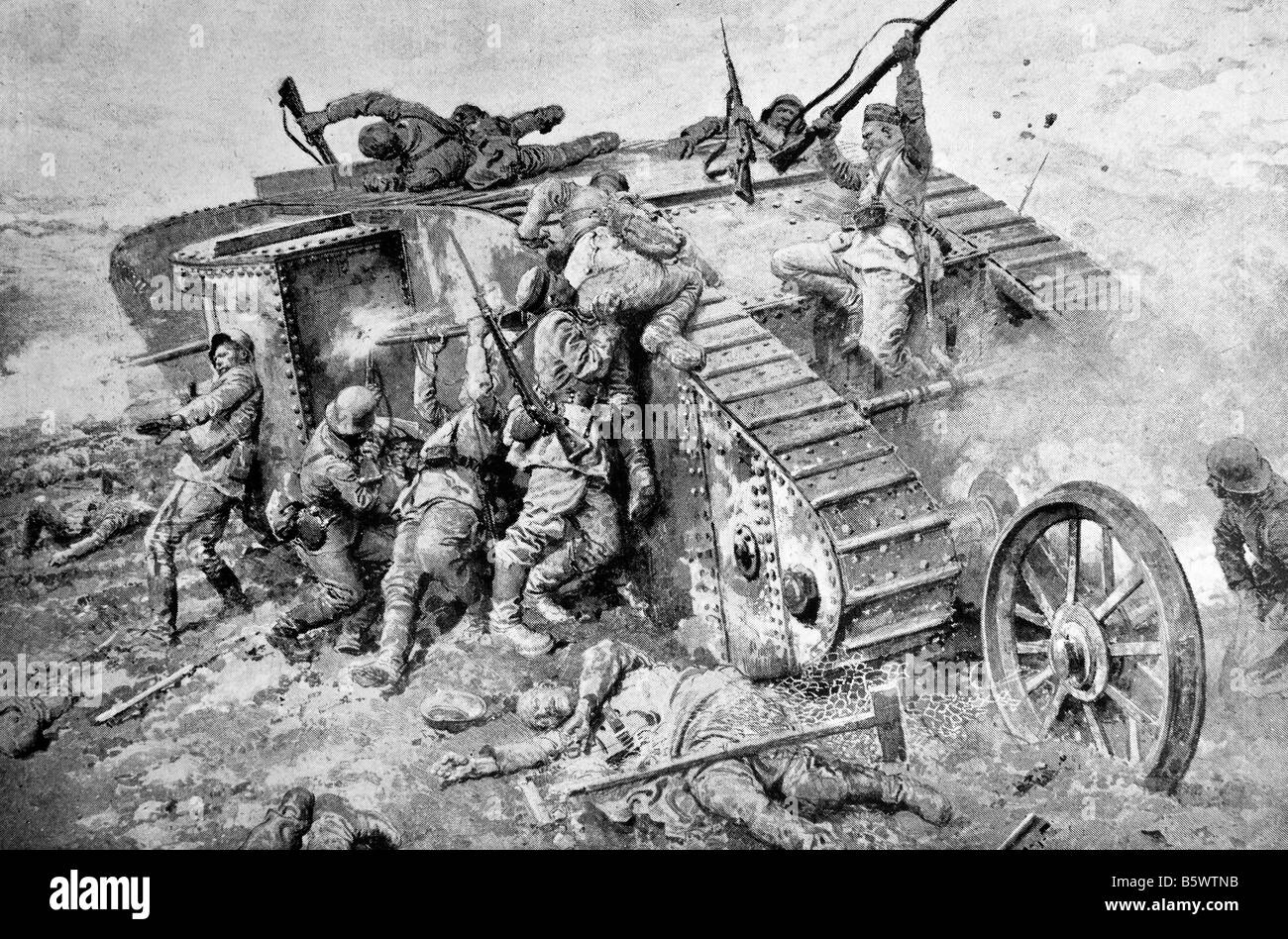 Contemporary World War One illustration of a futile attack by German soldiers on a British tank in France. Stock Photohttps://www.alamy.com/image-license-details/?v=1https://www.alamy.com/stock-photo-contemporary-world-war-one-illustration-of-a-futile-attack-by-german-20851863.html
Contemporary World War One illustration of a futile attack by German soldiers on a British tank in France. Stock Photohttps://www.alamy.com/image-license-details/?v=1https://www.alamy.com/stock-photo-contemporary-world-war-one-illustration-of-a-futile-attack-by-german-20851863.htmlRMB5WTNB–Contemporary World War One illustration of a futile attack by German soldiers on a British tank in France.
 The British Western Front. Battle of Flanders Description: Bombing parties drawing bombs from a bomb store in support trenches. Annotation: The British Western Front. The battle of Flanders. Soldiers carry bombs resolve this in a store in a support trench. Date: {1914-1918} Keywords: bombs, World War fronts, trenches, warehouses, soldiers Stock Photohttps://www.alamy.com/image-license-details/?v=1https://www.alamy.com/the-british-western-front-battle-of-flanders-description-bombing-parties-drawing-bombs-from-a-bomb-store-in-support-trenches-annotation-the-british-western-front-the-battle-of-flanders-soldiers-carry-bombs-resolve-this-in-a-store-in-a-support-trench-date-1914-1918-keywords-bombs-world-war-fronts-trenches-warehouses-soldiers-image342164163.html
The British Western Front. Battle of Flanders Description: Bombing parties drawing bombs from a bomb store in support trenches. Annotation: The British Western Front. The battle of Flanders. Soldiers carry bombs resolve this in a store in a support trench. Date: {1914-1918} Keywords: bombs, World War fronts, trenches, warehouses, soldiers Stock Photohttps://www.alamy.com/image-license-details/?v=1https://www.alamy.com/the-british-western-front-battle-of-flanders-description-bombing-parties-drawing-bombs-from-a-bomb-store-in-support-trenches-annotation-the-british-western-front-the-battle-of-flanders-soldiers-carry-bombs-resolve-this-in-a-store-in-a-support-trench-date-1914-1918-keywords-bombs-world-war-fronts-trenches-warehouses-soldiers-image342164163.htmlRM2ATJWTK–The British Western Front. Battle of Flanders Description: Bombing parties drawing bombs from a bomb store in support trenches. Annotation: The British Western Front. The battle of Flanders. Soldiers carry bombs resolve this in a store in a support trench. Date: {1914-1918} Keywords: bombs, World War fronts, trenches, warehouses, soldiers
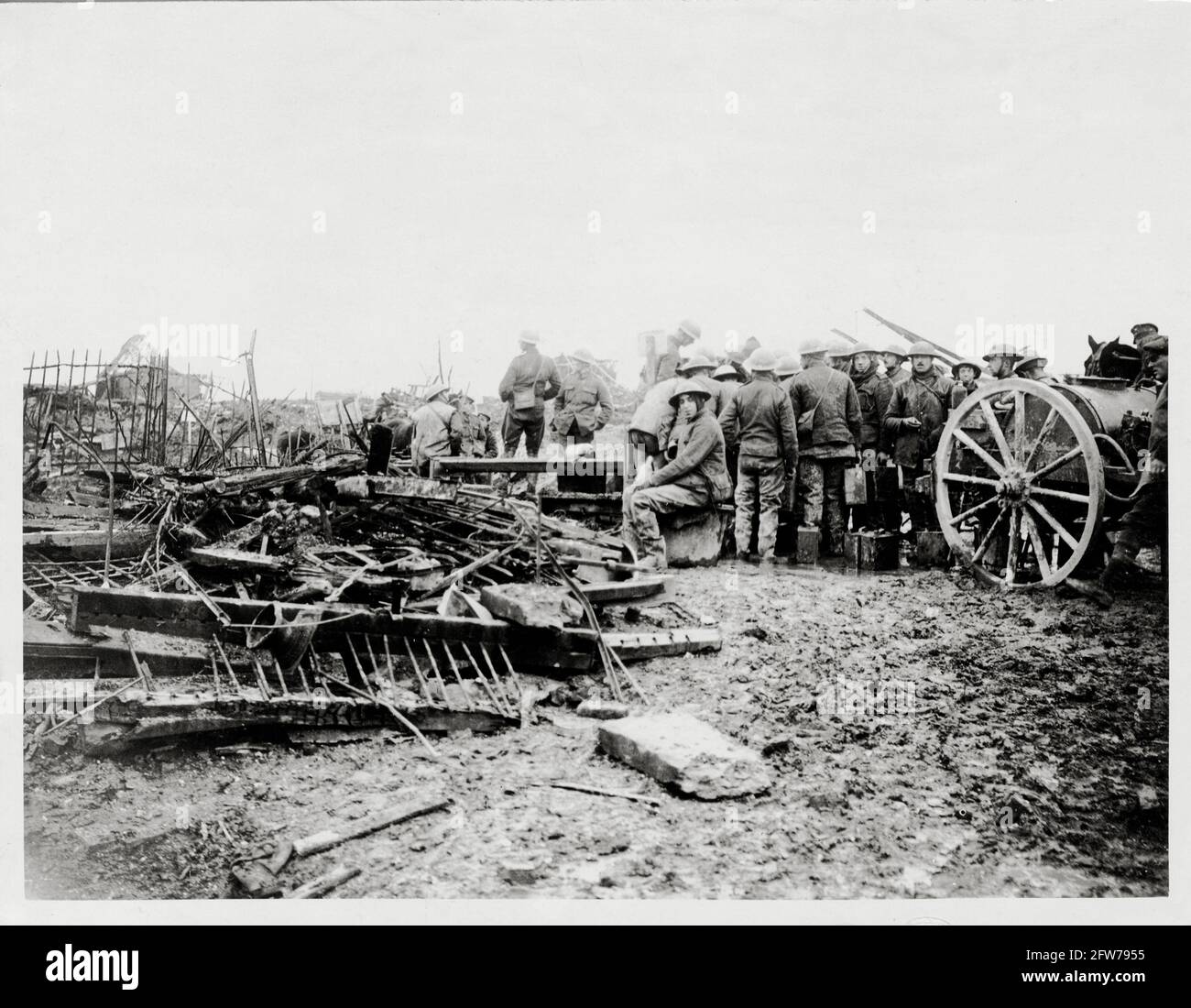 World War One, WWI, Western Front - Troops drawing water from a pump in a ruined village, France Stock Photohttps://www.alamy.com/image-license-details/?v=1https://www.alamy.com/world-war-one-wwi-western-front-troops-drawing-water-from-a-pump-in-a-ruined-village-france-image428576097.html
World War One, WWI, Western Front - Troops drawing water from a pump in a ruined village, France Stock Photohttps://www.alamy.com/image-license-details/?v=1https://www.alamy.com/world-war-one-wwi-western-front-troops-drawing-water-from-a-pump-in-a-ruined-village-france-image428576097.htmlRM2FW7955–World War One, WWI, Western Front - Troops drawing water from a pump in a ruined village, France
 General John Richmond Webb at the The Battle of Wijnendale, 28 September 1708, From British Battles on Land and Sea, by James Grant Stock Photohttps://www.alamy.com/image-license-details/?v=1https://www.alamy.com/general-john-richmond-webb-at-the-the-battle-of-wijnendale-28-september-1708-from-british-battles-on-land-and-sea-by-james-grant-image216213732.html
General John Richmond Webb at the The Battle of Wijnendale, 28 September 1708, From British Battles on Land and Sea, by James Grant Stock Photohttps://www.alamy.com/image-license-details/?v=1https://www.alamy.com/general-john-richmond-webb-at-the-the-battle-of-wijnendale-28-september-1708-from-british-battles-on-land-and-sea-by-james-grant-image216213732.htmlRMPFNAR0–General John Richmond Webb at the The Battle of Wijnendale, 28 September 1708, From British Battles on Land and Sea, by James Grant
 World War One, WWI, Western Front - Men drawing water in a captured village, France Stock Photohttps://www.alamy.com/image-license-details/?v=1https://www.alamy.com/world-war-one-wwi-western-front-men-drawing-water-in-a-captured-village-france-image428046362.html
World War One, WWI, Western Front - Men drawing water in a captured village, France Stock Photohttps://www.alamy.com/image-license-details/?v=1https://www.alamy.com/world-war-one-wwi-western-front-men-drawing-water-in-a-captured-village-france-image428046362.htmlRM2FTB5E2–World War One, WWI, Western Front - Men drawing water in a captured village, France
 Breaking through the French lines in Flanders, 1705, Ersteig und Eroberung der Französischen Linien in Flandern unter dem Höllandischen General Spar, Ao. 1705. den 4. Aug. (title on object), Breaking of the French lines in Flanders at Fort St. Philips, by the Allies under the Dutch general Sparre, August 4, 1705. Oval representation of the battle in a richly decorated ornamental frame, at the top of the Faam. At the bottom a cartouche with the description of the battle in German, on the right a seated woman with crown and scepter and swan. Sheet in the bound collection of records released Stock Photohttps://www.alamy.com/image-license-details/?v=1https://www.alamy.com/breaking-through-the-french-lines-in-flanders-1705-ersteig-und-eroberung-der-franzsischen-linien-in-flandern-unter-dem-hllandischen-general-spar-ao-1705-den-4-aug-title-on-object-breaking-of-the-french-lines-in-flanders-at-fort-st-philips-by-the-allies-under-the-dutch-general-sparre-august-4-1705-oval-representation-of-the-battle-in-a-richly-decorated-ornamental-frame-at-the-top-of-the-faam-at-the-bottom-a-cartouche-with-the-description-of-the-battle-in-german-on-the-right-a-seated-woman-with-crown-and-scepter-and-swan-sheet-in-the-bound-collection-of-records-released-image606644153.html
Breaking through the French lines in Flanders, 1705, Ersteig und Eroberung der Französischen Linien in Flandern unter dem Höllandischen General Spar, Ao. 1705. den 4. Aug. (title on object), Breaking of the French lines in Flanders at Fort St. Philips, by the Allies under the Dutch general Sparre, August 4, 1705. Oval representation of the battle in a richly decorated ornamental frame, at the top of the Faam. At the bottom a cartouche with the description of the battle in German, on the right a seated woman with crown and scepter and swan. Sheet in the bound collection of records released Stock Photohttps://www.alamy.com/image-license-details/?v=1https://www.alamy.com/breaking-through-the-french-lines-in-flanders-1705-ersteig-und-eroberung-der-franzsischen-linien-in-flandern-unter-dem-hllandischen-general-spar-ao-1705-den-4-aug-title-on-object-breaking-of-the-french-lines-in-flanders-at-fort-st-philips-by-the-allies-under-the-dutch-general-sparre-august-4-1705-oval-representation-of-the-battle-in-a-richly-decorated-ornamental-frame-at-the-top-of-the-faam-at-the-bottom-a-cartouche-with-the-description-of-the-battle-in-german-on-the-right-a-seated-woman-with-crown-and-scepter-and-swan-sheet-in-the-bound-collection-of-records-released-image606644153.htmlRM2X6Y0PH–Breaking through the French lines in Flanders, 1705, Ersteig und Eroberung der Französischen Linien in Flandern unter dem Höllandischen General Spar, Ao. 1705. den 4. Aug. (title on object), Breaking of the French lines in Flanders at Fort St. Philips, by the Allies under the Dutch general Sparre, August 4, 1705. Oval representation of the battle in a richly decorated ornamental frame, at the top of the Faam. At the bottom a cartouche with the description of the battle in German, on the right a seated woman with crown and scepter and swan. Sheet in the bound collection of records released
 Soldiers in Battle, n.d. Stock Photohttps://www.alamy.com/image-license-details/?v=1https://www.alamy.com/soldiers-in-battle-nd-image491535331.html
Soldiers in Battle, n.d. Stock Photohttps://www.alamy.com/image-license-details/?v=1https://www.alamy.com/soldiers-in-battle-nd-image491535331.htmlRM2KFKA97–Soldiers in Battle, n.d.
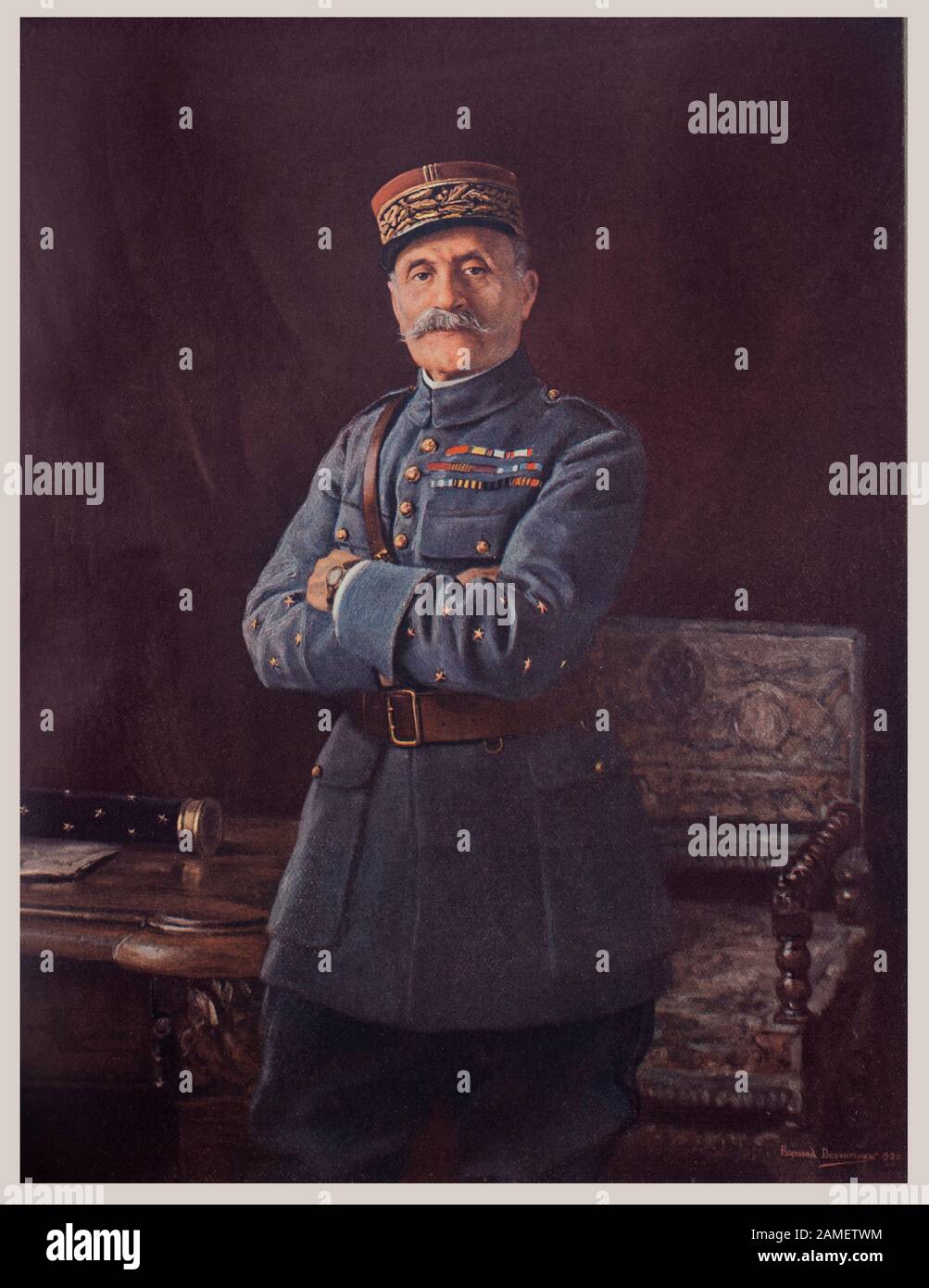 Ferdinand Foch (1851 – 1929) was a French general and military theorist who served as the Supreme Allied Commander during the First World War. An aggr Stock Photohttps://www.alamy.com/image-license-details/?v=1https://www.alamy.com/ferdinand-foch-1851-1929-was-a-french-general-and-military-theorist-who-served-as-the-supreme-allied-commander-during-the-first-world-war-an-aggr-image339616976.html
Ferdinand Foch (1851 – 1929) was a French general and military theorist who served as the Supreme Allied Commander during the First World War. An aggr Stock Photohttps://www.alamy.com/image-license-details/?v=1https://www.alamy.com/ferdinand-foch-1851-1929-was-a-french-general-and-military-theorist-who-served-as-the-supreme-allied-commander-during-the-first-world-war-an-aggr-image339616976.htmlRM2AMETWM–Ferdinand Foch (1851 – 1929) was a French general and military theorist who served as the Supreme Allied Commander during the First World War. An aggr
 Poppy illustration Stock Photohttps://www.alamy.com/image-license-details/?v=1https://www.alamy.com/stock-photo-poppy-illustration-99615392.html
Poppy illustration Stock Photohttps://www.alamy.com/image-license-details/?v=1https://www.alamy.com/stock-photo-poppy-illustration-99615392.htmlRFFP1TCG–Poppy illustration
![In Flanders; The Yser Offensive (1917); Bombardment of German lines by Franco-British artillery on the night of August 15-16, 1917 (3:30 a.m.)', 1917. From "L'Album de la Guerre 1914-1919, Volume 2" [L' Illustration, Paris, 1924]. Stock Photo In Flanders; The Yser Offensive (1917); Bombardment of German lines by Franco-British artillery on the night of August 15-16, 1917 (3:30 a.m.)', 1917. From "L'Album de la Guerre 1914-1919, Volume 2" [L' Illustration, Paris, 1924]. Stock Photo](https://c8.alamy.com/comp/2RRJENY/in-flanders-the-yser-offensive-1917-bombardment-of-german-lines-by-franco-british-artillery-on-the-night-of-august-15-16-1917-330-am-1917-from-quotlalbum-de-la-guerre-1914-1919-volume-2quot-l-illustration-paris-1924-2RRJENY.jpg) In Flanders; The Yser Offensive (1917); Bombardment of German lines by Franco-British artillery on the night of August 15-16, 1917 (3:30 a.m.)', 1917. From "L'Album de la Guerre 1914-1919, Volume 2" [L' Illustration, Paris, 1924]. Stock Photohttps://www.alamy.com/image-license-details/?v=1https://www.alamy.com/in-flanders-the-yser-offensive-1917-bombardment-of-german-lines-by-franco-british-artillery-on-the-night-of-august-15-16-1917-330-am-1917-from-quotlalbum-de-la-guerre-1914-1919-volume-2quot-l-illustration-paris-1924-image565275591.html
In Flanders; The Yser Offensive (1917); Bombardment of German lines by Franco-British artillery on the night of August 15-16, 1917 (3:30 a.m.)', 1917. From "L'Album de la Guerre 1914-1919, Volume 2" [L' Illustration, Paris, 1924]. Stock Photohttps://www.alamy.com/image-license-details/?v=1https://www.alamy.com/in-flanders-the-yser-offensive-1917-bombardment-of-german-lines-by-franco-british-artillery-on-the-night-of-august-15-16-1917-330-am-1917-from-quotlalbum-de-la-guerre-1914-1919-volume-2quot-l-illustration-paris-1924-image565275591.htmlRM2RRJENY–In Flanders; The Yser Offensive (1917); Bombardment of German lines by Franco-British artillery on the night of August 15-16, 1917 (3:30 a.m.)', 1917. From "L'Album de la Guerre 1914-1919, Volume 2" [L' Illustration, Paris, 1924].
 A German field postcard from World War I shows destroyed buildings in Diksmuide in West Flanders, Belgium, in 1915. Fotoarchiv für Zeitgeschichte Stock Photohttps://www.alamy.com/image-license-details/?v=1https://www.alamy.com/a-german-field-postcard-from-world-war-i-shows-destroyed-buildings-image65352253.html
A German field postcard from World War I shows destroyed buildings in Diksmuide in West Flanders, Belgium, in 1915. Fotoarchiv für Zeitgeschichte Stock Photohttps://www.alamy.com/image-license-details/?v=1https://www.alamy.com/a-german-field-postcard-from-world-war-i-shows-destroyed-buildings-image65352253.htmlRMDP91D1–A German field postcard from World War I shows destroyed buildings in Diksmuide in West Flanders, Belgium, in 1915. Fotoarchiv für Zeitgeschichte
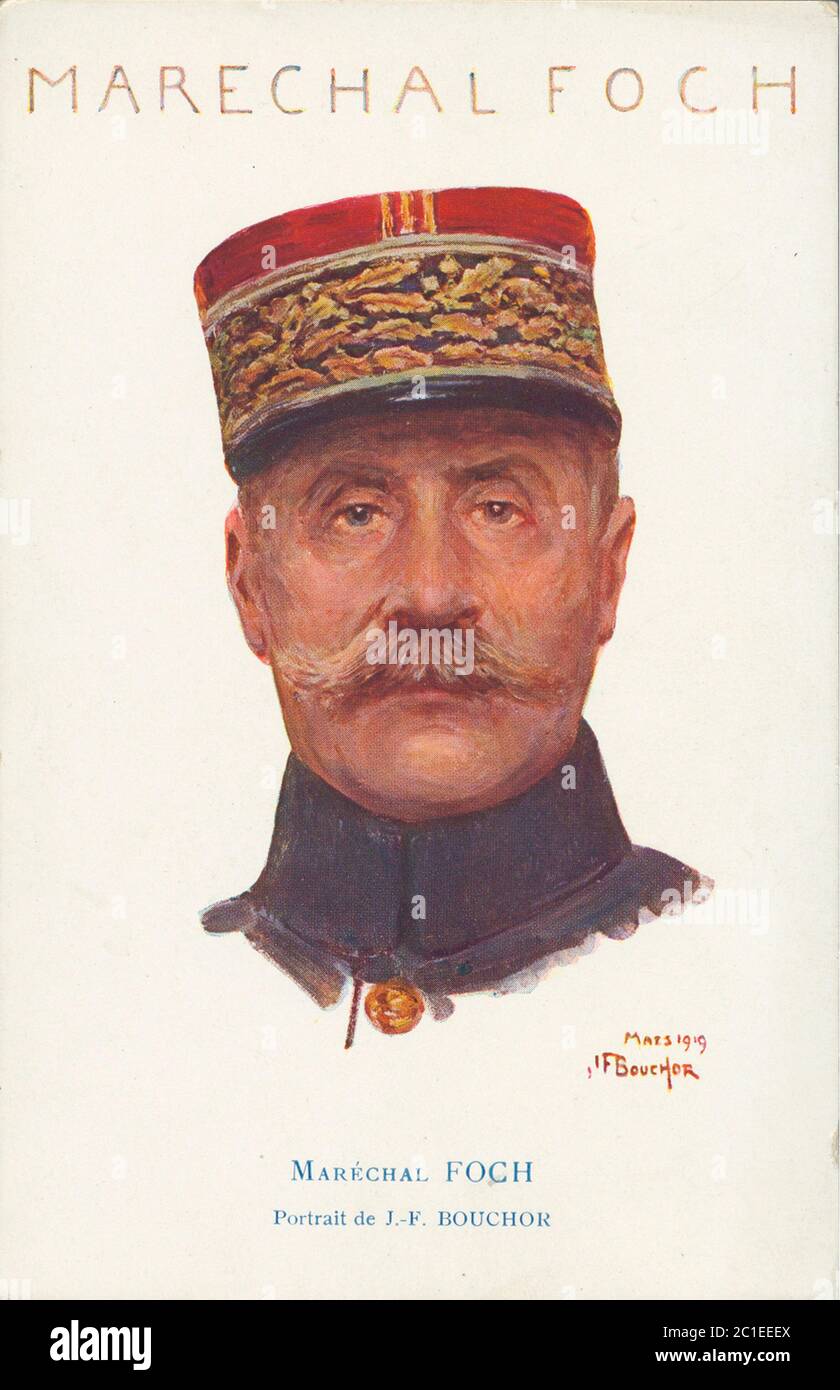 Ferdinand Foch (1851 – 1929) was a French general and military theorist who served as the Supreme Allied Commander during the First World War. He succ Stock Photohttps://www.alamy.com/image-license-details/?v=1https://www.alamy.com/ferdinand-foch-1851-1929-was-a-french-general-and-military-theorist-who-served-as-the-supreme-allied-commander-during-the-first-world-war-he-succ-image362351106.html
Ferdinand Foch (1851 – 1929) was a French general and military theorist who served as the Supreme Allied Commander during the First World War. He succ Stock Photohttps://www.alamy.com/image-license-details/?v=1https://www.alamy.com/ferdinand-foch-1851-1929-was-a-french-general-and-military-theorist-who-served-as-the-supreme-allied-commander-during-the-first-world-war-he-succ-image362351106.htmlRF2C1EEEX–Ferdinand Foch (1851 – 1929) was a French general and military theorist who served as the Supreme Allied Commander during the First World War. He succ
 A German field postcard from World War I shows a destroyed church in Sint-Pieters-Kapelle in West Flanders, Belgium, in 1915. Fotoarchiv für Zeitgeschichte Stock Photohttps://www.alamy.com/image-license-details/?v=1https://www.alamy.com/a-german-field-postcard-from-world-war-i-shows-a-destroyed-church-image65352266.html
A German field postcard from World War I shows a destroyed church in Sint-Pieters-Kapelle in West Flanders, Belgium, in 1915. Fotoarchiv für Zeitgeschichte Stock Photohttps://www.alamy.com/image-license-details/?v=1https://www.alamy.com/a-german-field-postcard-from-world-war-i-shows-a-destroyed-church-image65352266.htmlRMDP91DE–A German field postcard from World War I shows a destroyed church in Sint-Pieters-Kapelle in West Flanders, Belgium, in 1915. Fotoarchiv für Zeitgeschichte
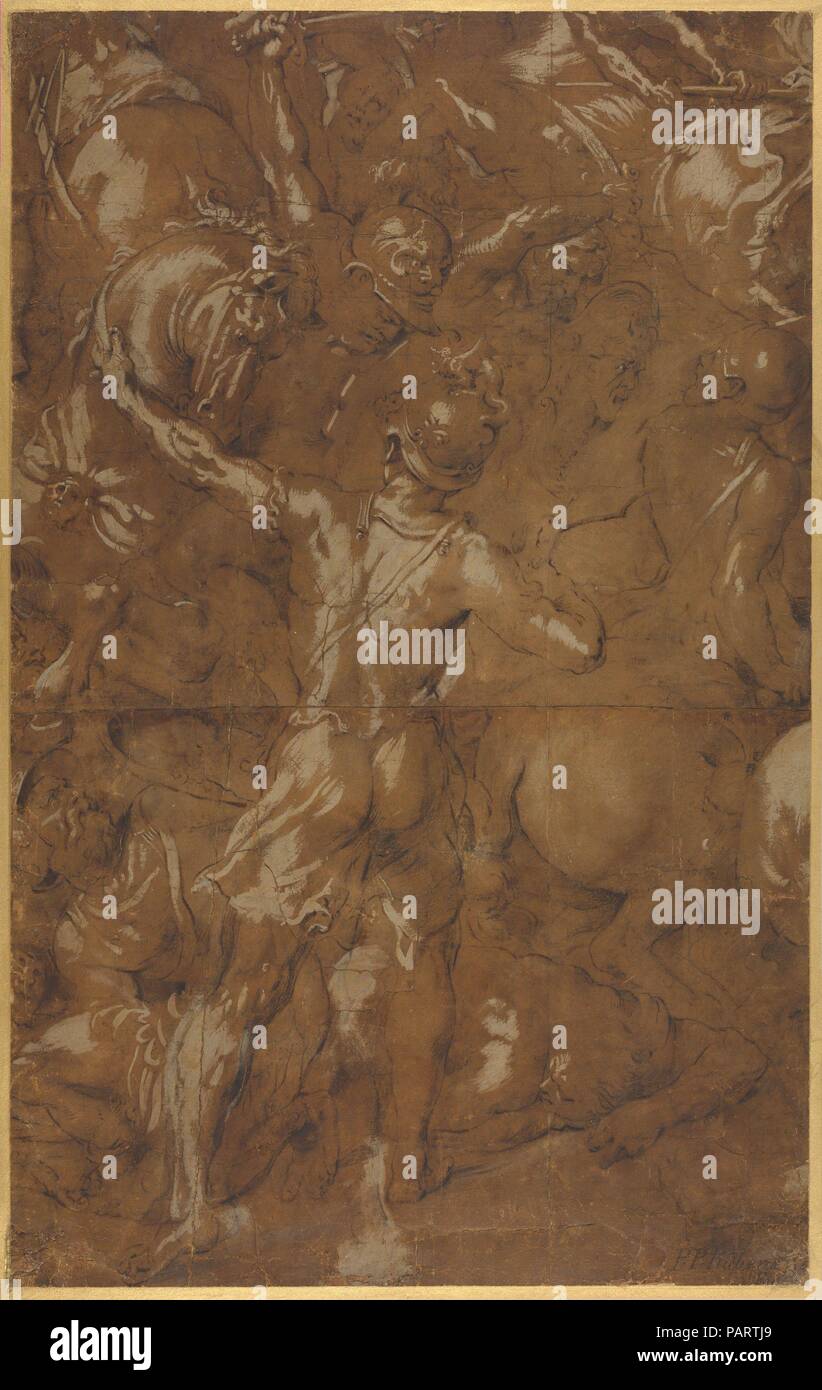 Battle Scene. Artist: Workshop of Peter Paul Rubens (Flemish, Siegen 1577-1640 Antwerp). Dimensions: sheet: 23 7/16 x 14 5/8 in. (59.5 x 37.2 cm). Date: n.d.. Museum: Metropolitan Museum of Art, New York, USA. Stock Photohttps://www.alamy.com/image-license-details/?v=1https://www.alamy.com/battle-scene-artist-workshop-of-peter-paul-rubens-flemish-siegen-1577-1640-antwerp-dimensions-sheet-23-716-x-14-58-in-595-x-372-cm-date-nd-museum-metropolitan-museum-of-art-new-york-usa-image213195201.html
Battle Scene. Artist: Workshop of Peter Paul Rubens (Flemish, Siegen 1577-1640 Antwerp). Dimensions: sheet: 23 7/16 x 14 5/8 in. (59.5 x 37.2 cm). Date: n.d.. Museum: Metropolitan Museum of Art, New York, USA. Stock Photohttps://www.alamy.com/image-license-details/?v=1https://www.alamy.com/battle-scene-artist-workshop-of-peter-paul-rubens-flemish-siegen-1577-1640-antwerp-dimensions-sheet-23-716-x-14-58-in-595-x-372-cm-date-nd-museum-metropolitan-museum-of-art-new-york-usa-image213195201.htmlRMPARTJ9–Battle Scene. Artist: Workshop of Peter Paul Rubens (Flemish, Siegen 1577-1640 Antwerp). Dimensions: sheet: 23 7/16 x 14 5/8 in. (59.5 x 37.2 cm). Date: n.d.. Museum: Metropolitan Museum of Art, New York, USA.
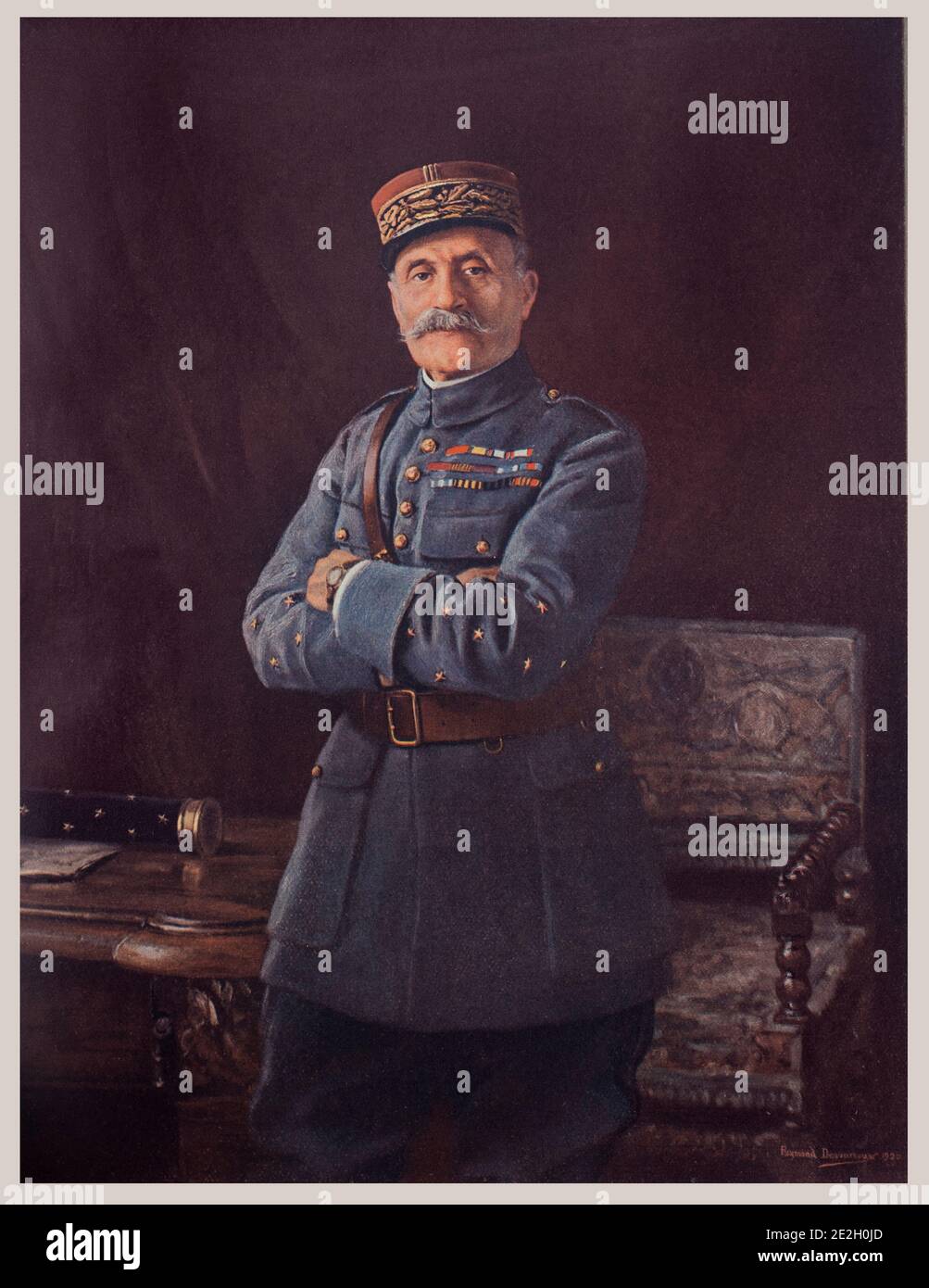 Ferdinand Foch (1851 – 1929) was a French general and military theorist who served as the Supreme Allied Commander during the First World War. An aggr Stock Photohttps://www.alamy.com/image-license-details/?v=1https://www.alamy.com/ferdinand-foch-1851-1929-was-a-french-general-and-military-theorist-who-served-as-the-supreme-allied-commander-during-the-first-world-war-an-aggr-image397441477.html
Ferdinand Foch (1851 – 1929) was a French general and military theorist who served as the Supreme Allied Commander during the First World War. An aggr Stock Photohttps://www.alamy.com/image-license-details/?v=1https://www.alamy.com/ferdinand-foch-1851-1929-was-a-french-general-and-military-theorist-who-served-as-the-supreme-allied-commander-during-the-first-world-war-an-aggr-image397441477.htmlRM2E2H0JD–Ferdinand Foch (1851 – 1929) was a French general and military theorist who served as the Supreme Allied Commander during the First World War. An aggr
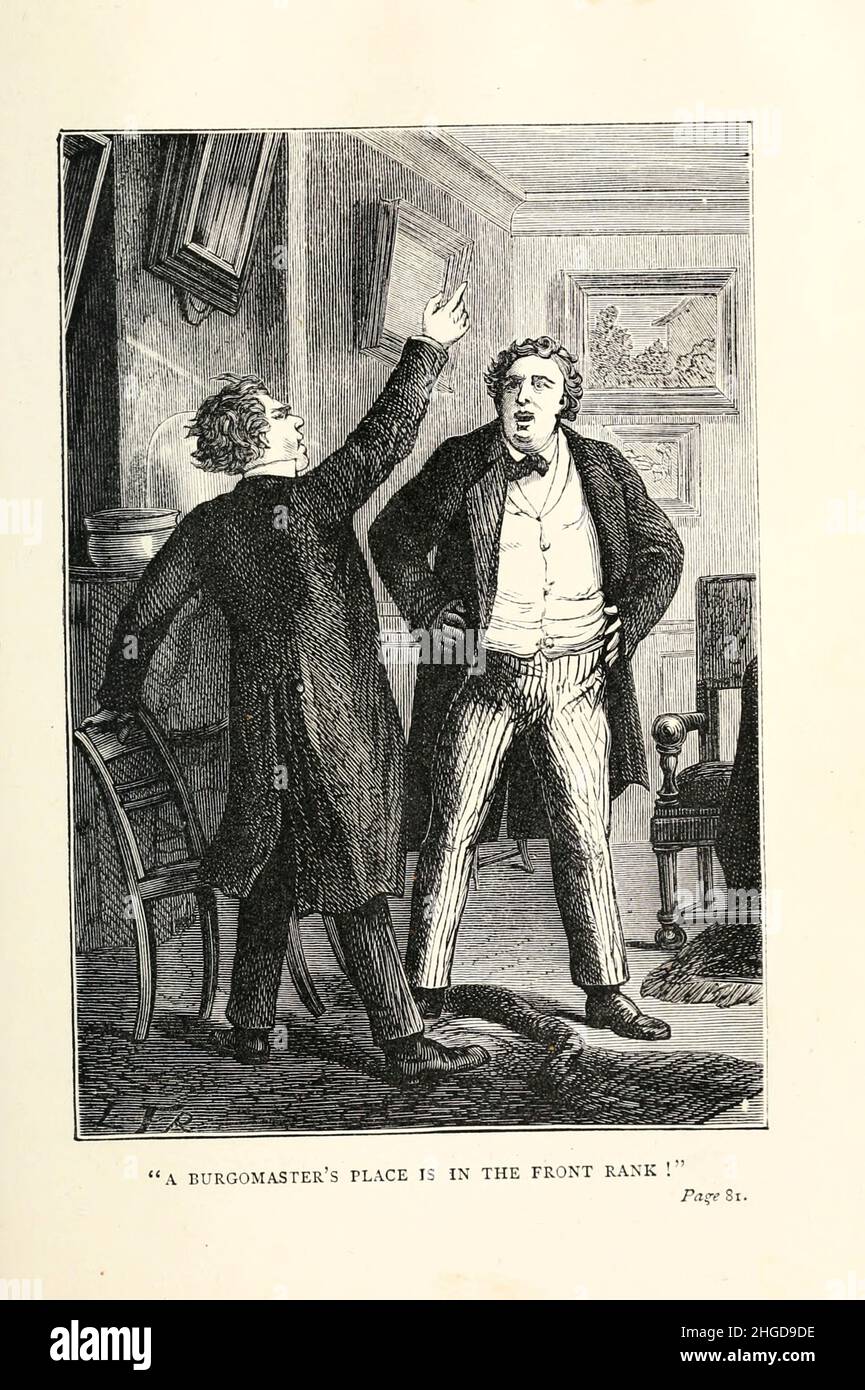 A burgomaster's place is in the front rank from Dr. Ox's Experiment (French: Une fantaisie du docteur Ox, 'A Fantasy of Doctor Ox') is a humorous science fiction short story by the French writer Jules Verne, published in 1872. It describes an experiment by one Dr. Ox, and is inspired by the real or alleged effects of oxygen on living things. The setting of the story is the imaginary village of Quiquendone in West Flanders (Belgium) whose citizens are described as 'well-to-do folks, wise, prudent, sociable, with even tempers, hospitable, perhaps a bit heavy in conversation as in mind'; A scient Stock Photohttps://www.alamy.com/image-license-details/?v=1https://www.alamy.com/a-burgomasters-place-is-in-the-front-rank-from-dr-oxs-experiment-french-une-fantaisie-du-docteur-ox-a-fantasy-of-doctor-ox-is-a-humorous-science-fiction-short-story-by-the-french-writer-jules-verne-published-in-1872-it-describes-an-experiment-by-one-dr-ox-and-is-inspired-by-the-real-or-alleged-effects-of-oxygen-on-living-things-the-setting-of-the-story-is-the-imaginary-village-of-quiquendone-in-west-flanders-belgium-whose-citizens-are-described-as-well-to-do-folks-wise-prudent-sociable-with-even-tempers-hospitable-perhaps-a-bit-heavy-in-conversation-as-in-mind-a-scient-image457596874.html
A burgomaster's place is in the front rank from Dr. Ox's Experiment (French: Une fantaisie du docteur Ox, 'A Fantasy of Doctor Ox') is a humorous science fiction short story by the French writer Jules Verne, published in 1872. It describes an experiment by one Dr. Ox, and is inspired by the real or alleged effects of oxygen on living things. The setting of the story is the imaginary village of Quiquendone in West Flanders (Belgium) whose citizens are described as 'well-to-do folks, wise, prudent, sociable, with even tempers, hospitable, perhaps a bit heavy in conversation as in mind'; A scient Stock Photohttps://www.alamy.com/image-license-details/?v=1https://www.alamy.com/a-burgomasters-place-is-in-the-front-rank-from-dr-oxs-experiment-french-une-fantaisie-du-docteur-ox-a-fantasy-of-doctor-ox-is-a-humorous-science-fiction-short-story-by-the-french-writer-jules-verne-published-in-1872-it-describes-an-experiment-by-one-dr-ox-and-is-inspired-by-the-real-or-alleged-effects-of-oxygen-on-living-things-the-setting-of-the-story-is-the-imaginary-village-of-quiquendone-in-west-flanders-belgium-whose-citizens-are-described-as-well-to-do-folks-wise-prudent-sociable-with-even-tempers-hospitable-perhaps-a-bit-heavy-in-conversation-as-in-mind-a-scient-image457596874.htmlRF2HGD9DE–A burgomaster's place is in the front rank from Dr. Ox's Experiment (French: Une fantaisie du docteur Ox, 'A Fantasy of Doctor Ox') is a humorous science fiction short story by the French writer Jules Verne, published in 1872. It describes an experiment by one Dr. Ox, and is inspired by the real or alleged effects of oxygen on living things. The setting of the story is the imaginary village of Quiquendone in West Flanders (Belgium) whose citizens are described as 'well-to-do folks, wise, prudent, sociable, with even tempers, hospitable, perhaps a bit heavy in conversation as in mind'; A scient
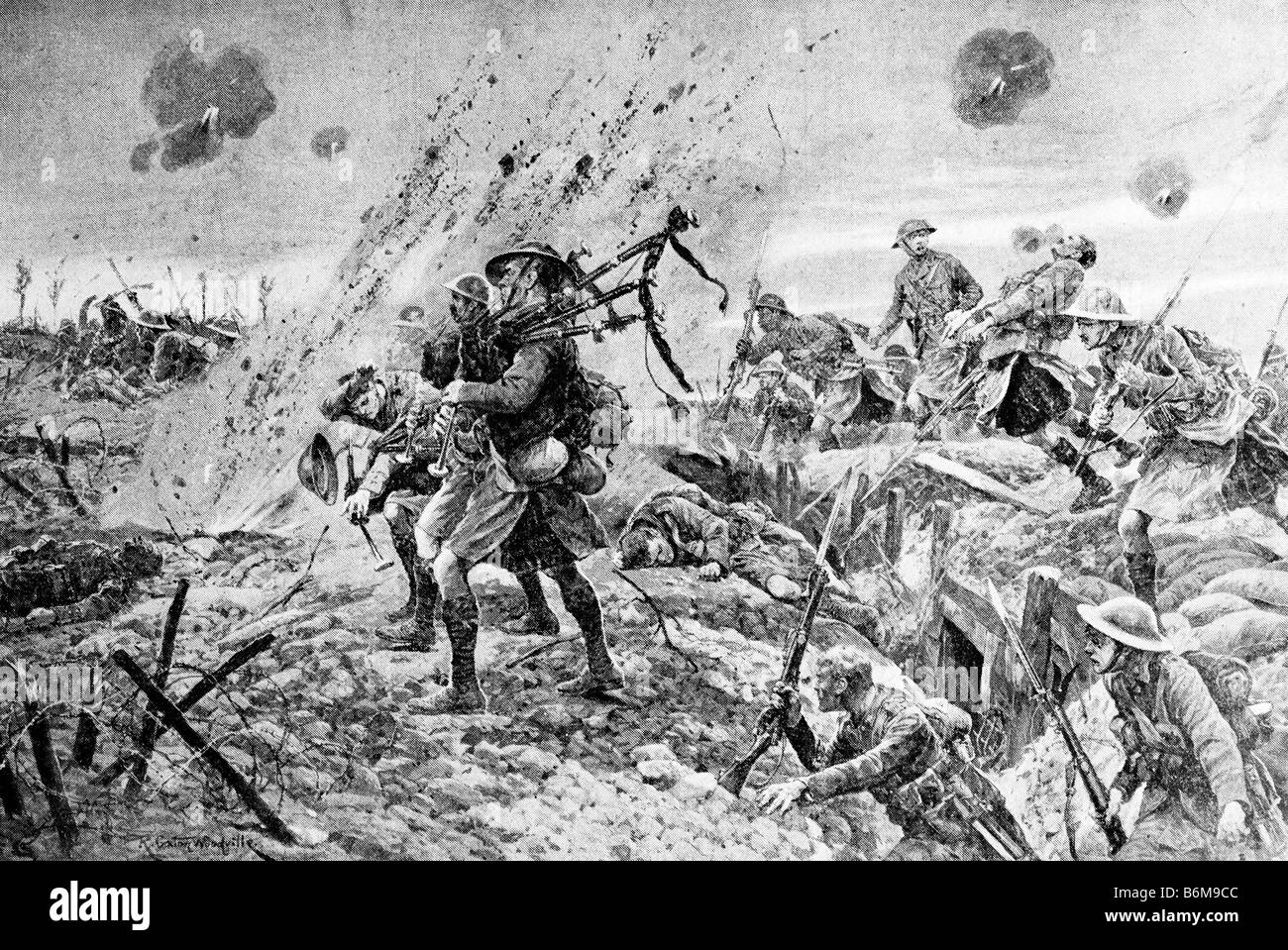 Contemporary World War One illustration of Scottish soldiers playing bagpipes under enemy fire during the Battle of the Somme. Stock Photohttps://www.alamy.com/image-license-details/?v=1https://www.alamy.com/stock-photo-contemporary-world-war-one-illustration-of-scottish-soldiers-playing-21344748.html
Contemporary World War One illustration of Scottish soldiers playing bagpipes under enemy fire during the Battle of the Somme. Stock Photohttps://www.alamy.com/image-license-details/?v=1https://www.alamy.com/stock-photo-contemporary-world-war-one-illustration-of-scottish-soldiers-playing-21344748.htmlRMB6M9CC–Contemporary World War One illustration of Scottish soldiers playing bagpipes under enemy fire during the Battle of the Somme.
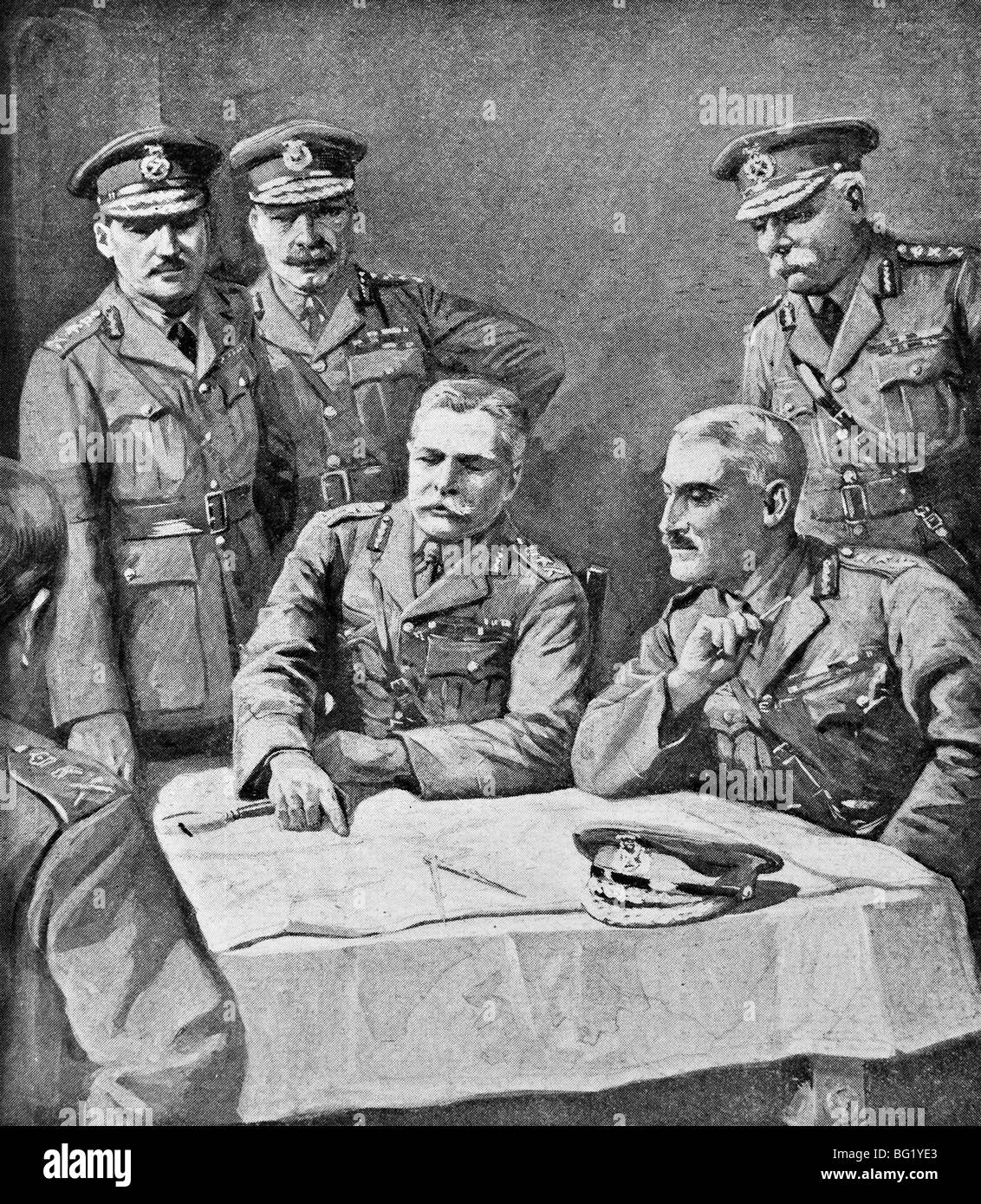 Contemporary World War One illustration of Field Marshal Douglas Haig and British Generals planning the Third Battle of Ypres. Stock Photohttps://www.alamy.com/image-license-details/?v=1https://www.alamy.com/stock-photo-contemporary-world-war-one-illustration-of-field-marshal-douglas-haig-27088379.html
Contemporary World War One illustration of Field Marshal Douglas Haig and British Generals planning the Third Battle of Ypres. Stock Photohttps://www.alamy.com/image-license-details/?v=1https://www.alamy.com/stock-photo-contemporary-world-war-one-illustration-of-field-marshal-douglas-haig-27088379.htmlRMBG1YE3–Contemporary World War One illustration of Field Marshal Douglas Haig and British Generals planning the Third Battle of Ypres.
 General John Richmond Webb at the The Battle of Wijnendale, 28 September 1708, From British Battles on Land and Sea, by James Grant Stock Photohttps://www.alamy.com/image-license-details/?v=1https://www.alamy.com/general-john-richmond-webb-at-the-the-battle-of-wijnendale-28-september-1708-from-british-battles-on-land-and-sea-by-james-grant-image216213526.html
General John Richmond Webb at the The Battle of Wijnendale, 28 September 1708, From British Battles on Land and Sea, by James Grant Stock Photohttps://www.alamy.com/image-license-details/?v=1https://www.alamy.com/general-john-richmond-webb-at-the-the-battle-of-wijnendale-28-september-1708-from-british-battles-on-land-and-sea-by-james-grant-image216213526.htmlRMPFNAFJ–General John Richmond Webb at the The Battle of Wijnendale, 28 September 1708, From British Battles on Land and Sea, by James Grant
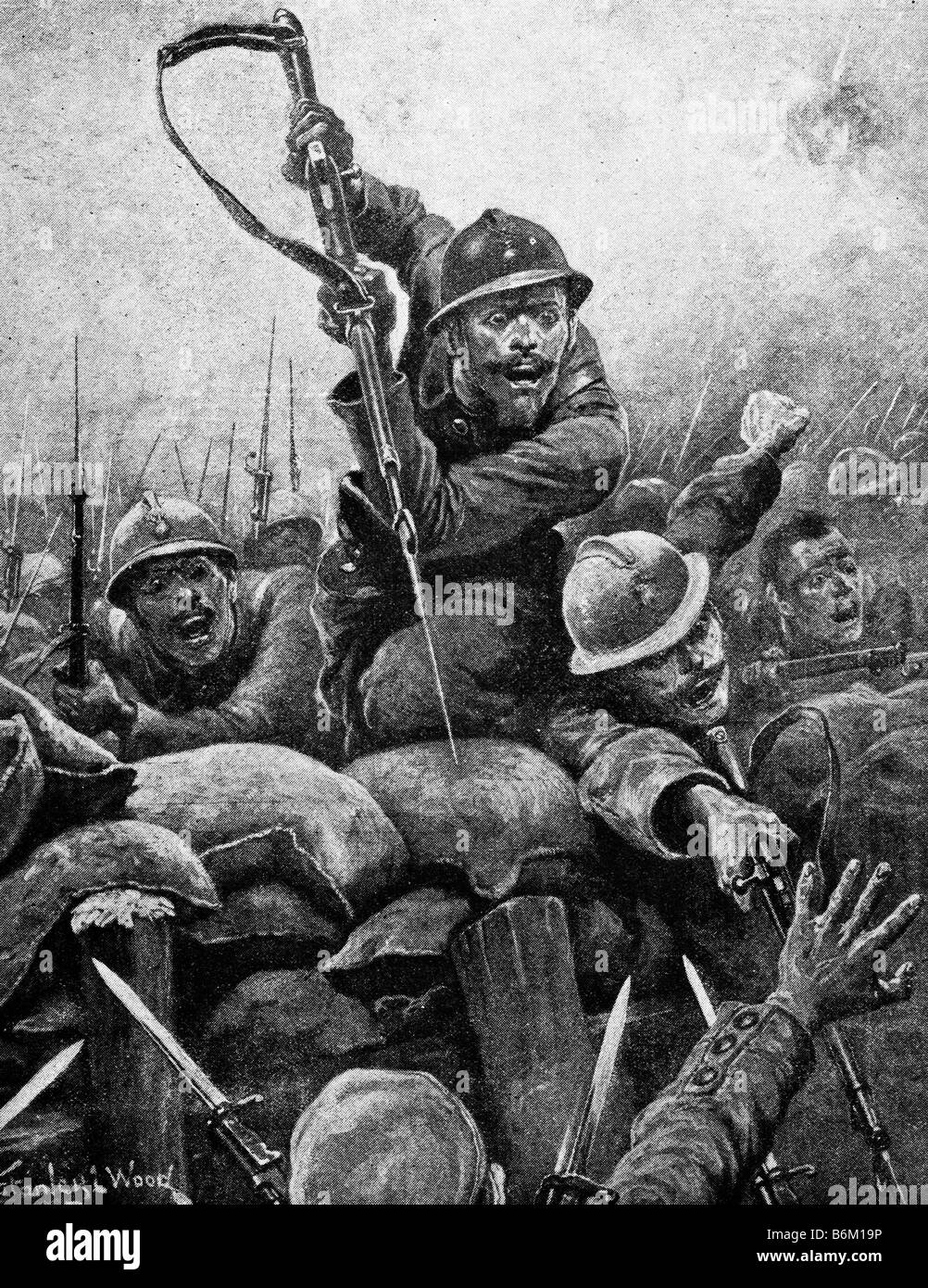 Contemporary World War One illustration of French soldiers storming a German trench. Stock Photohttps://www.alamy.com/image-license-details/?v=1https://www.alamy.com/stock-photo-contemporary-world-war-one-illustration-of-french-soldiers-storming-21338402.html
Contemporary World War One illustration of French soldiers storming a German trench. Stock Photohttps://www.alamy.com/image-license-details/?v=1https://www.alamy.com/stock-photo-contemporary-world-war-one-illustration-of-french-soldiers-storming-21338402.htmlRMB6M19P–Contemporary World War One illustration of French soldiers storming a German trench.
 Prince Willem George Frederik is wounded at Werwik, 1793, Bataille van den 13. September 1793, in addition to hurting H.D.H. Willem George Fredrik of Orange, at the height of Werwick (title on object), Willem George Frederik, prince of Orange-Nassau, is wounded in a battle against the French near Wervik in West Flanders on September 13, 1793., print, print maker: Carel Jacob de Huyser, (mentioned on object), after drawing by: Cornelis Groeneveld, (mentioned on object), Northern Netherlands, 1802, paper, etching, engraving, height, 203 mm × width, 240 mm Stock Photohttps://www.alamy.com/image-license-details/?v=1https://www.alamy.com/prince-willem-george-frederik-is-wounded-at-werwik-1793-bataille-van-den-13-september-1793-in-addition-to-hurting-hdh-willem-george-fredrik-of-orange-at-the-height-of-werwick-title-on-object-willem-george-frederik-prince-of-orange-nassau-is-wounded-in-a-battle-against-the-french-near-wervik-in-west-flanders-on-september-13-1793-print-print-maker-carel-jacob-de-huyser-mentioned-on-object-after-drawing-by-cornelis-groeneveld-mentioned-on-object-northern-netherlands-1802-paper-etching-engraving-height-203-mm-width-240-mm-image606634938.html
Prince Willem George Frederik is wounded at Werwik, 1793, Bataille van den 13. September 1793, in addition to hurting H.D.H. Willem George Fredrik of Orange, at the height of Werwick (title on object), Willem George Frederik, prince of Orange-Nassau, is wounded in a battle against the French near Wervik in West Flanders on September 13, 1793., print, print maker: Carel Jacob de Huyser, (mentioned on object), after drawing by: Cornelis Groeneveld, (mentioned on object), Northern Netherlands, 1802, paper, etching, engraving, height, 203 mm × width, 240 mm Stock Photohttps://www.alamy.com/image-license-details/?v=1https://www.alamy.com/prince-willem-george-frederik-is-wounded-at-werwik-1793-bataille-van-den-13-september-1793-in-addition-to-hurting-hdh-willem-george-fredrik-of-orange-at-the-height-of-werwick-title-on-object-willem-george-frederik-prince-of-orange-nassau-is-wounded-in-a-battle-against-the-french-near-wervik-in-west-flanders-on-september-13-1793-print-print-maker-carel-jacob-de-huyser-mentioned-on-object-after-drawing-by-cornelis-groeneveld-mentioned-on-object-northern-netherlands-1802-paper-etching-engraving-height-203-mm-width-240-mm-image606634938.htmlRM2X6XH1E–Prince Willem George Frederik is wounded at Werwik, 1793, Bataille van den 13. September 1793, in addition to hurting H.D.H. Willem George Fredrik of Orange, at the height of Werwick (title on object), Willem George Frederik, prince of Orange-Nassau, is wounded in a battle against the French near Wervik in West Flanders on September 13, 1793., print, print maker: Carel Jacob de Huyser, (mentioned on object), after drawing by: Cornelis Groeneveld, (mentioned on object), Northern Netherlands, 1802, paper, etching, engraving, height, 203 mm × width, 240 mm
 The Battle of Damme on 30 May and 31 May 1213, Anglo-French War, From British Battles on Land and Sea, by James Grant Stock Photohttps://www.alamy.com/image-license-details/?v=1https://www.alamy.com/the-battle-of-damme-on-30-may-and-31-may-1213-anglo-french-war-from-british-battles-on-land-and-sea-by-james-grant-image213384746.html
The Battle of Damme on 30 May and 31 May 1213, Anglo-French War, From British Battles on Land and Sea, by James Grant Stock Photohttps://www.alamy.com/image-license-details/?v=1https://www.alamy.com/the-battle-of-damme-on-30-may-and-31-may-1213-anglo-french-war-from-british-battles-on-land-and-sea-by-james-grant-image213384746.htmlRMPB4EBP–The Battle of Damme on 30 May and 31 May 1213, Anglo-French War, From British Battles on Land and Sea, by James Grant
 Tomyris with the Head of Cyrus, c. 1637-1638. This subject is oddly related to that seen on the other side of the sheet: both feature a severed head, the result of an act of revenge by a powerful woman. The story of Queen Tomyris is a rare one in northern European art. Tomyris ruled a central Asian tribe and her son died while held captive by Cyrus, the king of Persia. Years later, Tomyris avenged her son's death when her armies defeated the Persians in battle and she found Cyrus's body and cut off the head. Rubens probably took the story from the ancient Greek historian Herodotus (about 484-4 Stock Photohttps://www.alamy.com/image-license-details/?v=1https://www.alamy.com/tomyris-with-the-head-of-cyrus-c-1637-1638-this-subject-is-oddly-related-to-that-seen-on-the-other-side-of-the-sheet-both-feature-a-severed-head-the-result-of-an-act-of-revenge-by-a-powerful-woman-the-story-of-queen-tomyris-is-a-rare-one-in-northern-european-art-tomyris-ruled-a-central-asian-tribe-and-her-son-died-while-held-captive-by-cyrus-the-king-of-persia-years-later-tomyris-avenged-her-sons-death-when-her-armies-defeated-the-persians-in-battle-and-she-found-cyruss-body-and-cut-off-the-head-rubens-probably-took-the-story-from-the-ancient-greek-historian-herodotus-about-484-4-image330131689.html
Tomyris with the Head of Cyrus, c. 1637-1638. This subject is oddly related to that seen on the other side of the sheet: both feature a severed head, the result of an act of revenge by a powerful woman. The story of Queen Tomyris is a rare one in northern European art. Tomyris ruled a central Asian tribe and her son died while held captive by Cyrus, the king of Persia. Years later, Tomyris avenged her son's death when her armies defeated the Persians in battle and she found Cyrus's body and cut off the head. Rubens probably took the story from the ancient Greek historian Herodotus (about 484-4 Stock Photohttps://www.alamy.com/image-license-details/?v=1https://www.alamy.com/tomyris-with-the-head-of-cyrus-c-1637-1638-this-subject-is-oddly-related-to-that-seen-on-the-other-side-of-the-sheet-both-feature-a-severed-head-the-result-of-an-act-of-revenge-by-a-powerful-woman-the-story-of-queen-tomyris-is-a-rare-one-in-northern-european-art-tomyris-ruled-a-central-asian-tribe-and-her-son-died-while-held-captive-by-cyrus-the-king-of-persia-years-later-tomyris-avenged-her-sons-death-when-her-armies-defeated-the-persians-in-battle-and-she-found-cyruss-body-and-cut-off-the-head-rubens-probably-took-the-story-from-the-ancient-greek-historian-herodotus-about-484-4-image330131689.htmlRM2A52P9D–Tomyris with the Head of Cyrus, c. 1637-1638. This subject is oddly related to that seen on the other side of the sheet: both feature a severed head, the result of an act of revenge by a powerful woman. The story of Queen Tomyris is a rare one in northern European art. Tomyris ruled a central Asian tribe and her son died while held captive by Cyrus, the king of Persia. Years later, Tomyris avenged her son's death when her armies defeated the Persians in battle and she found Cyrus's body and cut off the head. Rubens probably took the story from the ancient Greek historian Herodotus (about 484-4
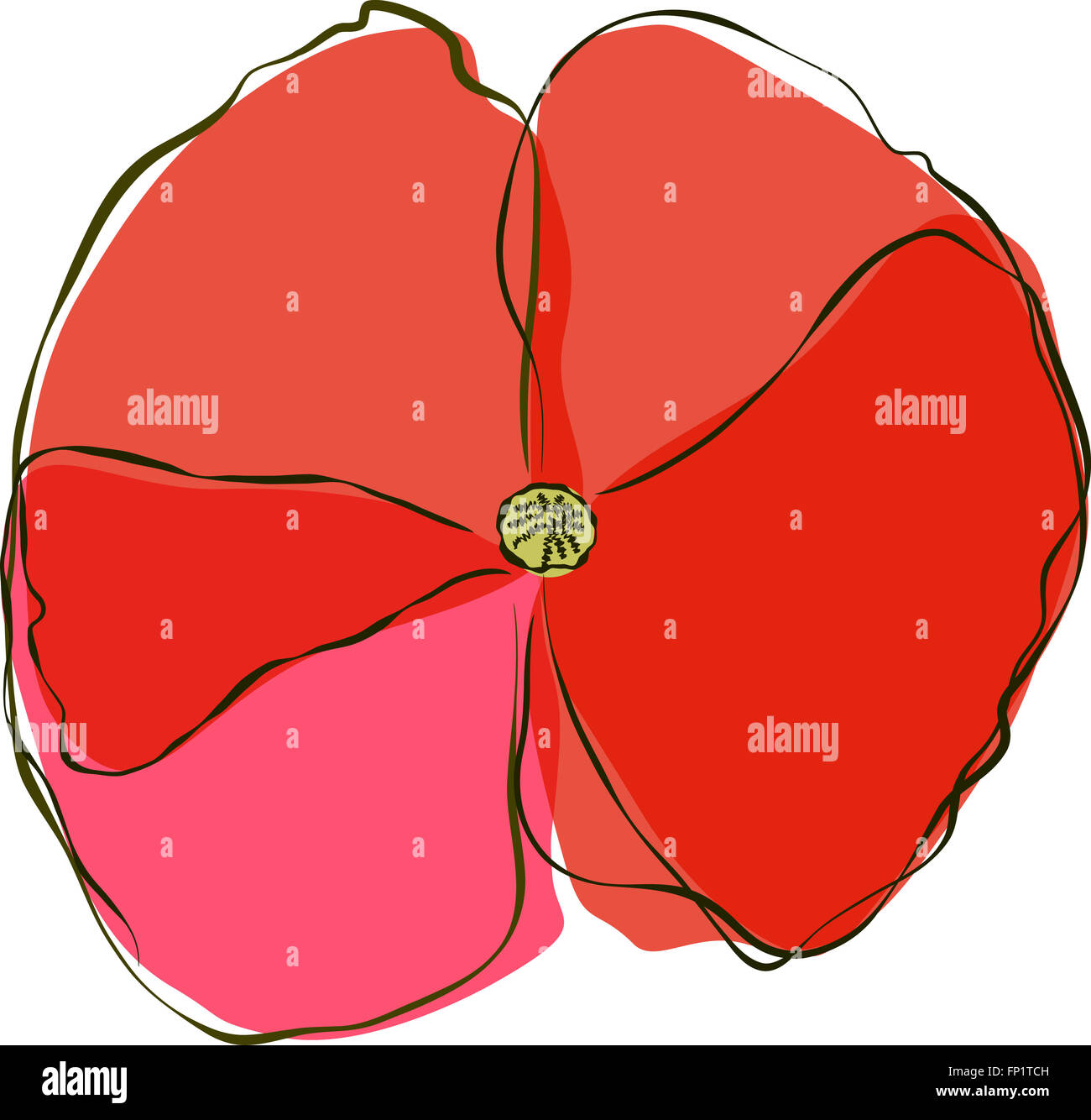 Poppy illustration Stock Photohttps://www.alamy.com/image-license-details/?v=1https://www.alamy.com/stock-photo-poppy-illustration-99615393.html
Poppy illustration Stock Photohttps://www.alamy.com/image-license-details/?v=1https://www.alamy.com/stock-photo-poppy-illustration-99615393.htmlRFFP1TCH–Poppy illustration
![In Flanders; The Yser Offensive (1917); Cossing of the Yser canal by infantry of the 1st Corps on July 31, 1917, at 4 a.m. 45 in the morning, near the lock at Het-Sas', 1917.From "L'Album de la Guerre 1914-1919, Volume 2" [L'Illustration, Paris, 1924]. Stock Photo In Flanders; The Yser Offensive (1917); Cossing of the Yser canal by infantry of the 1st Corps on July 31, 1917, at 4 a.m. 45 in the morning, near the lock at Het-Sas', 1917.From "L'Album de la Guerre 1914-1919, Volume 2" [L'Illustration, Paris, 1924]. Stock Photo](https://c8.alamy.com/comp/2RRJENP/in-flanders-the-yser-offensive-1917-cossing-of-the-yser-canal-by-infantry-of-the-1st-corps-on-july-31-1917-at-4-am-45-in-the-morning-near-the-lock-at-het-sas-1917from-quotlalbum-de-la-guerre-1914-1919-volume-2quot-lillustration-paris-1924-2RRJENP.jpg) In Flanders; The Yser Offensive (1917); Cossing of the Yser canal by infantry of the 1st Corps on July 31, 1917, at 4 a.m. 45 in the morning, near the lock at Het-Sas', 1917.From "L'Album de la Guerre 1914-1919, Volume 2" [L'Illustration, Paris, 1924]. Stock Photohttps://www.alamy.com/image-license-details/?v=1https://www.alamy.com/in-flanders-the-yser-offensive-1917-cossing-of-the-yser-canal-by-infantry-of-the-1st-corps-on-july-31-1917-at-4-am-45-in-the-morning-near-the-lock-at-het-sas-1917from-quotlalbum-de-la-guerre-1914-1919-volume-2quot-lillustration-paris-1924-image565275586.html
In Flanders; The Yser Offensive (1917); Cossing of the Yser canal by infantry of the 1st Corps on July 31, 1917, at 4 a.m. 45 in the morning, near the lock at Het-Sas', 1917.From "L'Album de la Guerre 1914-1919, Volume 2" [L'Illustration, Paris, 1924]. Stock Photohttps://www.alamy.com/image-license-details/?v=1https://www.alamy.com/in-flanders-the-yser-offensive-1917-cossing-of-the-yser-canal-by-infantry-of-the-1st-corps-on-july-31-1917-at-4-am-45-in-the-morning-near-the-lock-at-het-sas-1917from-quotlalbum-de-la-guerre-1914-1919-volume-2quot-lillustration-paris-1924-image565275586.htmlRM2RRJENP–In Flanders; The Yser Offensive (1917); Cossing of the Yser canal by infantry of the 1st Corps on July 31, 1917, at 4 a.m. 45 in the morning, near the lock at Het-Sas', 1917.From "L'Album de la Guerre 1914-1919, Volume 2" [L'Illustration, Paris, 1924].
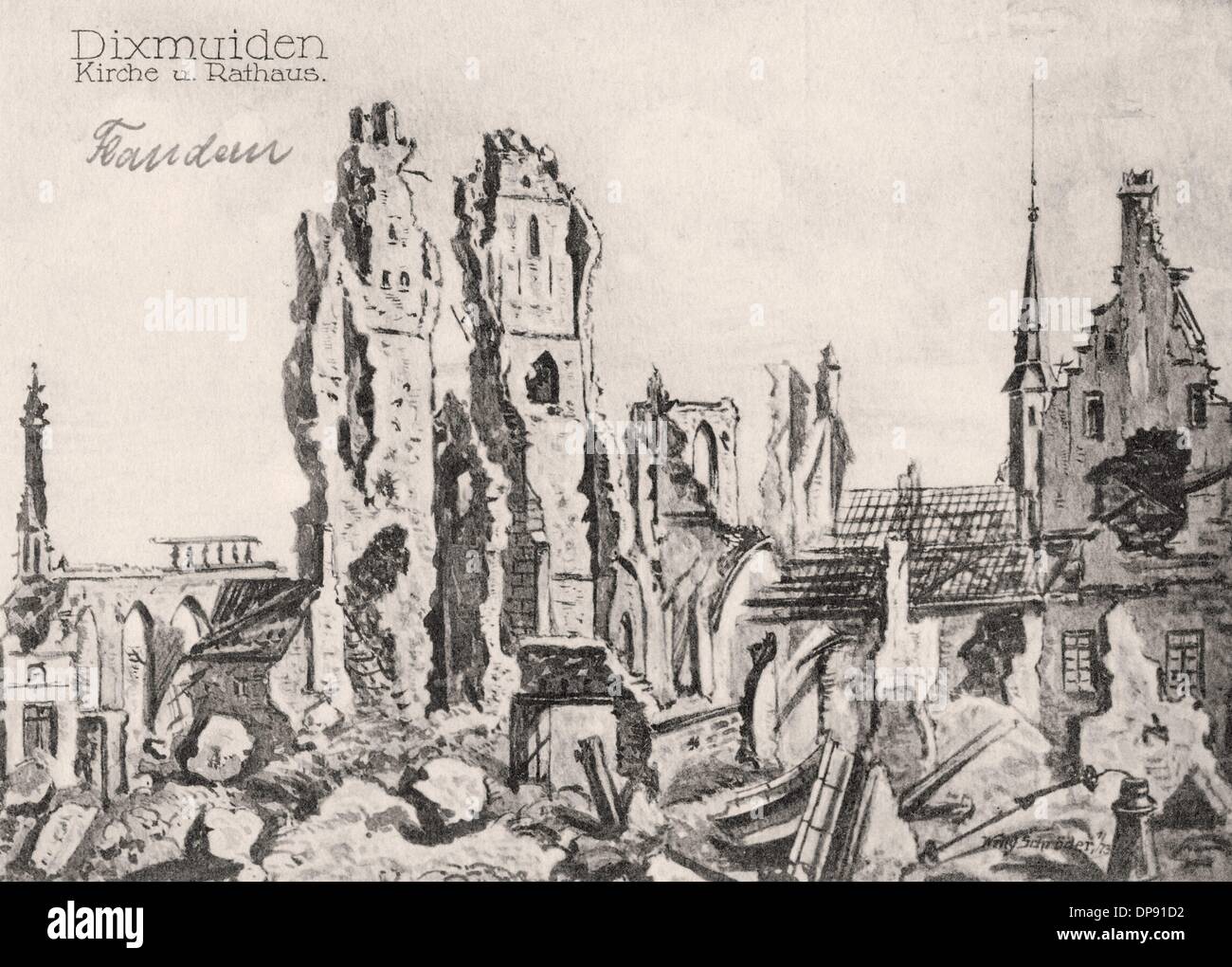 A German field postcard from World War I shows a destroyed church and the destroyed city hall in Diksmuide in West Flanders, Belgium, in 1915. Fotoarchiv für Zeitgeschichte Stock Photohttps://www.alamy.com/image-license-details/?v=1https://www.alamy.com/a-german-field-postcard-from-world-war-i-shows-a-destroyed-church-image65352254.html
A German field postcard from World War I shows a destroyed church and the destroyed city hall in Diksmuide in West Flanders, Belgium, in 1915. Fotoarchiv für Zeitgeschichte Stock Photohttps://www.alamy.com/image-license-details/?v=1https://www.alamy.com/a-german-field-postcard-from-world-war-i-shows-a-destroyed-church-image65352254.htmlRMDP91D2–A German field postcard from World War I shows a destroyed church and the destroyed city hall in Diksmuide in West Flanders, Belgium, in 1915. Fotoarchiv für Zeitgeschichte
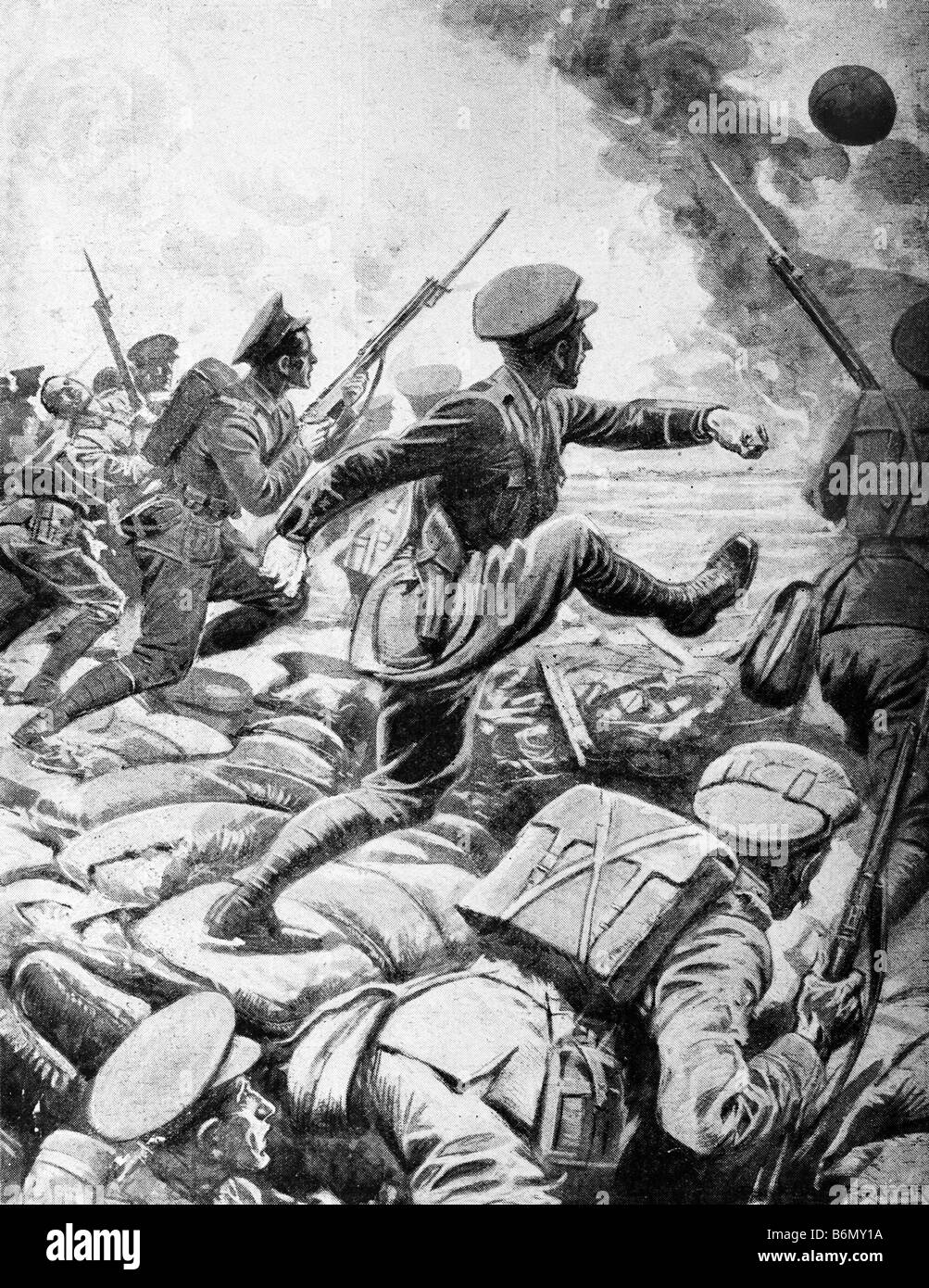 Contemporary World War One illustration of a British officer kicking a football towards German trenches as he leads an attack. Stock Photohttps://www.alamy.com/image-license-details/?v=1https://www.alamy.com/stock-photo-contemporary-world-war-one-illustration-of-a-british-officer-kicking-21358550.html
Contemporary World War One illustration of a British officer kicking a football towards German trenches as he leads an attack. Stock Photohttps://www.alamy.com/image-license-details/?v=1https://www.alamy.com/stock-photo-contemporary-world-war-one-illustration-of-a-british-officer-kicking-21358550.htmlRMB6MY1A–Contemporary World War One illustration of a British officer kicking a football towards German trenches as he leads an attack.
 The Battle of Damme on 30 May and 31 May 1213, Anglo-French War, From British Battles on Land and Sea, by James Grant Stock Photohttps://www.alamy.com/image-license-details/?v=1https://www.alamy.com/the-battle-of-damme-on-30-may-and-31-may-1213-anglo-french-war-from-british-battles-on-land-and-sea-by-james-grant-image213384773.html
The Battle of Damme on 30 May and 31 May 1213, Anglo-French War, From British Battles on Land and Sea, by James Grant Stock Photohttps://www.alamy.com/image-license-details/?v=1https://www.alamy.com/the-battle-of-damme-on-30-may-and-31-may-1213-anglo-french-war-from-british-battles-on-land-and-sea-by-james-grant-image213384773.htmlRMPB4ECN–The Battle of Damme on 30 May and 31 May 1213, Anglo-French War, From British Battles on Land and Sea, by James Grant
 Skirmish in a Roman Circus, 1621. Stock Photohttps://www.alamy.com/image-license-details/?v=1https://www.alamy.com/skirmish-in-a-roman-circus-1621-image491514642.html
Skirmish in a Roman Circus, 1621. Stock Photohttps://www.alamy.com/image-license-details/?v=1https://www.alamy.com/skirmish-in-a-roman-circus-1621-image491514642.htmlRM2KFJBXA–Skirmish in a Roman Circus, 1621.
 Poppy illustration Stock Photohttps://www.alamy.com/image-license-details/?v=1https://www.alamy.com/stock-photo-poppy-illustration-99615391.html
Poppy illustration Stock Photohttps://www.alamy.com/image-license-details/?v=1https://www.alamy.com/stock-photo-poppy-illustration-99615391.htmlRFFP1TCF–Poppy illustration
![English Attack of July 31, 1917; British infantry advance towards the upper reaches of the River Steenbeck, through the smoke of the barrage in front of them; in the foreground, explosion of a large German projectile, 1917. From "L'Album de la Guerre 1914-1919, Volume 2" [L'Illustration, Paris, 1924]. Stock Photo English Attack of July 31, 1917; British infantry advance towards the upper reaches of the River Steenbeck, through the smoke of the barrage in front of them; in the foreground, explosion of a large German projectile, 1917. From "L'Album de la Guerre 1914-1919, Volume 2" [L'Illustration, Paris, 1924]. Stock Photo](https://c8.alamy.com/comp/2RRJE90/english-attack-of-july-31-1917-british-infantry-advance-towards-the-upper-reaches-of-the-river-steenbeck-through-the-smoke-of-the-barrage-in-front-of-them-in-the-foreground-explosion-of-a-large-german-projectile-1917-from-quotlalbum-de-la-guerre-1914-1919-volume-2quot-lillustration-paris-1924-2RRJE90.jpg) English Attack of July 31, 1917; British infantry advance towards the upper reaches of the River Steenbeck, through the smoke of the barrage in front of them; in the foreground, explosion of a large German projectile, 1917. From "L'Album de la Guerre 1914-1919, Volume 2" [L'Illustration, Paris, 1924]. Stock Photohttps://www.alamy.com/image-license-details/?v=1https://www.alamy.com/english-attack-of-july-31-1917-british-infantry-advance-towards-the-upper-reaches-of-the-river-steenbeck-through-the-smoke-of-the-barrage-in-front-of-them-in-the-foreground-explosion-of-a-large-german-projectile-1917-from-quotlalbum-de-la-guerre-1914-1919-volume-2quot-lillustration-paris-1924-image565275228.html
English Attack of July 31, 1917; British infantry advance towards the upper reaches of the River Steenbeck, through the smoke of the barrage in front of them; in the foreground, explosion of a large German projectile, 1917. From "L'Album de la Guerre 1914-1919, Volume 2" [L'Illustration, Paris, 1924]. Stock Photohttps://www.alamy.com/image-license-details/?v=1https://www.alamy.com/english-attack-of-july-31-1917-british-infantry-advance-towards-the-upper-reaches-of-the-river-steenbeck-through-the-smoke-of-the-barrage-in-front-of-them-in-the-foreground-explosion-of-a-large-german-projectile-1917-from-quotlalbum-de-la-guerre-1914-1919-volume-2quot-lillustration-paris-1924-image565275228.htmlRM2RRJE90–English Attack of July 31, 1917; British infantry advance towards the upper reaches of the River Steenbeck, through the smoke of the barrage in front of them; in the foreground, explosion of a large German projectile, 1917. From "L'Album de la Guerre 1914-1919, Volume 2" [L'Illustration, Paris, 1924].
 Poppy illustration Stock Photohttps://www.alamy.com/image-license-details/?v=1https://www.alamy.com/stock-photo-poppy-illustration-99615394.html
Poppy illustration Stock Photohttps://www.alamy.com/image-license-details/?v=1https://www.alamy.com/stock-photo-poppy-illustration-99615394.htmlRFFP1TCJ–Poppy illustration
 A German field postcard from World War I shows a destroyed oil tank near the Yser River in West Flanders in 1915. Fotoarchiv für Zeitgeschichte Stock Photohttps://www.alamy.com/image-license-details/?v=1https://www.alamy.com/a-german-field-postcard-from-world-war-i-shows-a-destroyed-oil-tank-image65352290.html
A German field postcard from World War I shows a destroyed oil tank near the Yser River in West Flanders in 1915. Fotoarchiv für Zeitgeschichte Stock Photohttps://www.alamy.com/image-license-details/?v=1https://www.alamy.com/a-german-field-postcard-from-world-war-i-shows-a-destroyed-oil-tank-image65352290.htmlRMDP91EA–A German field postcard from World War I shows a destroyed oil tank near the Yser River in West Flanders in 1915. Fotoarchiv für Zeitgeschichte
 Poppy illustration Stock Photohttps://www.alamy.com/image-license-details/?v=1https://www.alamy.com/stock-photo-poppy-illustration-99615409.html
Poppy illustration Stock Photohttps://www.alamy.com/image-license-details/?v=1https://www.alamy.com/stock-photo-poppy-illustration-99615409.htmlRFFP1TD5–Poppy illustration
 Skirmish in a Roman Circus, 1621. Stock Photohttps://www.alamy.com/image-license-details/?v=1https://www.alamy.com/skirmish-in-a-roman-circus-1621-image491461525.html
Skirmish in a Roman Circus, 1621. Stock Photohttps://www.alamy.com/image-license-details/?v=1https://www.alamy.com/skirmish-in-a-roman-circus-1621-image491461525.htmlRM2KFG059–Skirmish in a Roman Circus, 1621.
 A German field postcard from World War I shows a destroyed church in Beerst near Diksmuide in West Flanders, Belgium, in 1915. Fotoarchiv für Zeitgeschichte Stock Photohttps://www.alamy.com/image-license-details/?v=1https://www.alamy.com/a-german-field-postcard-from-world-war-i-shows-a-destroyed-church-image65352259.html
A German field postcard from World War I shows a destroyed church in Beerst near Diksmuide in West Flanders, Belgium, in 1915. Fotoarchiv für Zeitgeschichte Stock Photohttps://www.alamy.com/image-license-details/?v=1https://www.alamy.com/a-german-field-postcard-from-world-war-i-shows-a-destroyed-church-image65352259.htmlRMDP91D7–A German field postcard from World War I shows a destroyed church in Beerst near Diksmuide in West Flanders, Belgium, in 1915. Fotoarchiv für Zeitgeschichte
 Poppy illustration Stock Photohttps://www.alamy.com/image-license-details/?v=1https://www.alamy.com/stock-photo-poppy-illustration-99615402.html
Poppy illustration Stock Photohttps://www.alamy.com/image-license-details/?v=1https://www.alamy.com/stock-photo-poppy-illustration-99615402.htmlRFFP1TCX–Poppy illustration
 Il Greco in Troia: Plate 3. The Greeks in Troy. Stock Photohttps://www.alamy.com/image-license-details/?v=1https://www.alamy.com/il-greco-in-troia-plate-3-the-greeks-in-troy-image506212792.html
Il Greco in Troia: Plate 3. The Greeks in Troy. Stock Photohttps://www.alamy.com/image-license-details/?v=1https://www.alamy.com/il-greco-in-troia-plate-3-the-greeks-in-troy-image506212792.htmlRM2MBFYG8–Il Greco in Troia: Plate 3. The Greeks in Troy.
 A German field postcard from World War I shows a destroyed farmstead In Nazell on the Yser River in West Flanders, Belgium, in 1915. Fotoarchiv für Zeitgeschichte Stock Photohttps://www.alamy.com/image-license-details/?v=1https://www.alamy.com/a-german-field-postcard-from-world-war-i-shows-a-destroyed-farmstead-image65352289.html
A German field postcard from World War I shows a destroyed farmstead In Nazell on the Yser River in West Flanders, Belgium, in 1915. Fotoarchiv für Zeitgeschichte Stock Photohttps://www.alamy.com/image-license-details/?v=1https://www.alamy.com/a-german-field-postcard-from-world-war-i-shows-a-destroyed-farmstead-image65352289.htmlRMDP91E9–A German field postcard from World War I shows a destroyed farmstead In Nazell on the Yser River in West Flanders, Belgium, in 1915. Fotoarchiv für Zeitgeschichte
 Poppy illustration Stock Photohttps://www.alamy.com/image-license-details/?v=1https://www.alamy.com/stock-photo-poppy-illustration-99615407.html
Poppy illustration Stock Photohttps://www.alamy.com/image-license-details/?v=1https://www.alamy.com/stock-photo-poppy-illustration-99615407.htmlRFFP1TD3–Poppy illustration
 Military Commander on Horseback, 1621. Stock Photohttps://www.alamy.com/image-license-details/?v=1https://www.alamy.com/military-commander-on-horseback-1621-image491514957.html
Military Commander on Horseback, 1621. Stock Photohttps://www.alamy.com/image-license-details/?v=1https://www.alamy.com/military-commander-on-horseback-1621-image491514957.htmlRM2KFJC9H–Military Commander on Horseback, 1621.
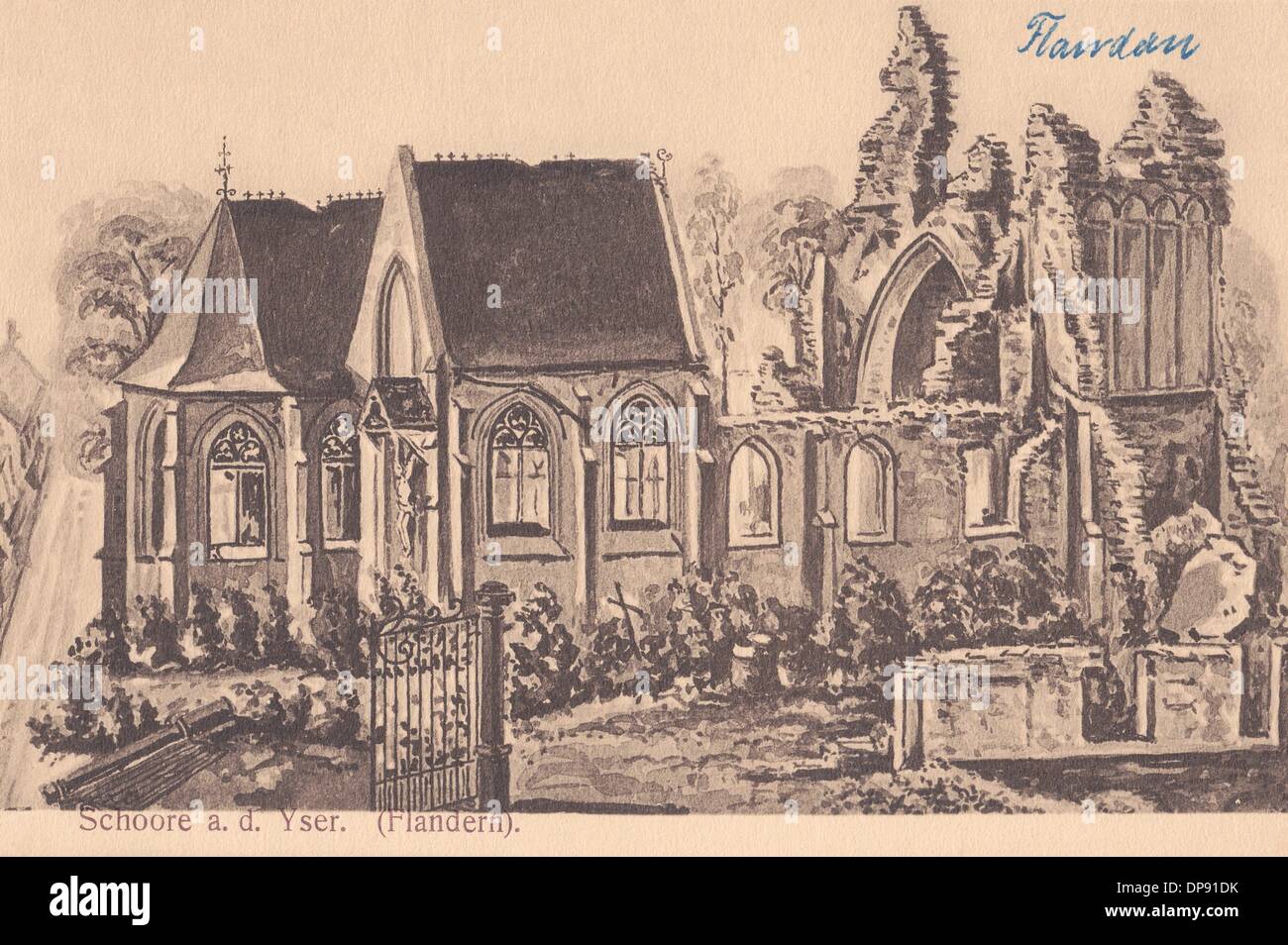 A German field postcard from World War I shows a destroyed church in Schore on the Yser River near Middelkerke in West Flanders, Belgium, in 1915. Fotoarchiv für Zeitgeschichte Stock Photohttps://www.alamy.com/image-license-details/?v=1https://www.alamy.com/a-german-field-postcard-from-world-war-i-shows-a-destroyed-church-image65352271.html
A German field postcard from World War I shows a destroyed church in Schore on the Yser River near Middelkerke in West Flanders, Belgium, in 1915. Fotoarchiv für Zeitgeschichte Stock Photohttps://www.alamy.com/image-license-details/?v=1https://www.alamy.com/a-german-field-postcard-from-world-war-i-shows-a-destroyed-church-image65352271.htmlRMDP91DK–A German field postcard from World War I shows a destroyed church in Schore on the Yser River near Middelkerke in West Flanders, Belgium, in 1915. Fotoarchiv für Zeitgeschichte
 Poppy illustration Stock Photohttps://www.alamy.com/image-license-details/?v=1https://www.alamy.com/stock-photo-poppy-illustration-99615405.html
Poppy illustration Stock Photohttps://www.alamy.com/image-license-details/?v=1https://www.alamy.com/stock-photo-poppy-illustration-99615405.htmlRFFP1TD1–Poppy illustration
 Military Commander on Foot, 1621. Stock Photohttps://www.alamy.com/image-license-details/?v=1https://www.alamy.com/military-commander-on-foot-1621-image491514942.html
Military Commander on Foot, 1621. Stock Photohttps://www.alamy.com/image-license-details/?v=1https://www.alamy.com/military-commander-on-foot-1621-image491514942.htmlRM2KFJC92–Military Commander on Foot, 1621.
 A German field postcard from World War I shows a destroyed church in Schore on the Yser River near Middelkerke in West Flanders, Belgium, in 1915. Fotoarchiv für Zeitgeschichte Stock Photohttps://www.alamy.com/image-license-details/?v=1https://www.alamy.com/a-german-field-postcard-from-world-war-i-shows-a-destroyed-church-image65352283.html
A German field postcard from World War I shows a destroyed church in Schore on the Yser River near Middelkerke in West Flanders, Belgium, in 1915. Fotoarchiv für Zeitgeschichte Stock Photohttps://www.alamy.com/image-license-details/?v=1https://www.alamy.com/a-german-field-postcard-from-world-war-i-shows-a-destroyed-church-image65352283.htmlRMDP91E3–A German field postcard from World War I shows a destroyed church in Schore on the Yser River near Middelkerke in West Flanders, Belgium, in 1915. Fotoarchiv für Zeitgeschichte

